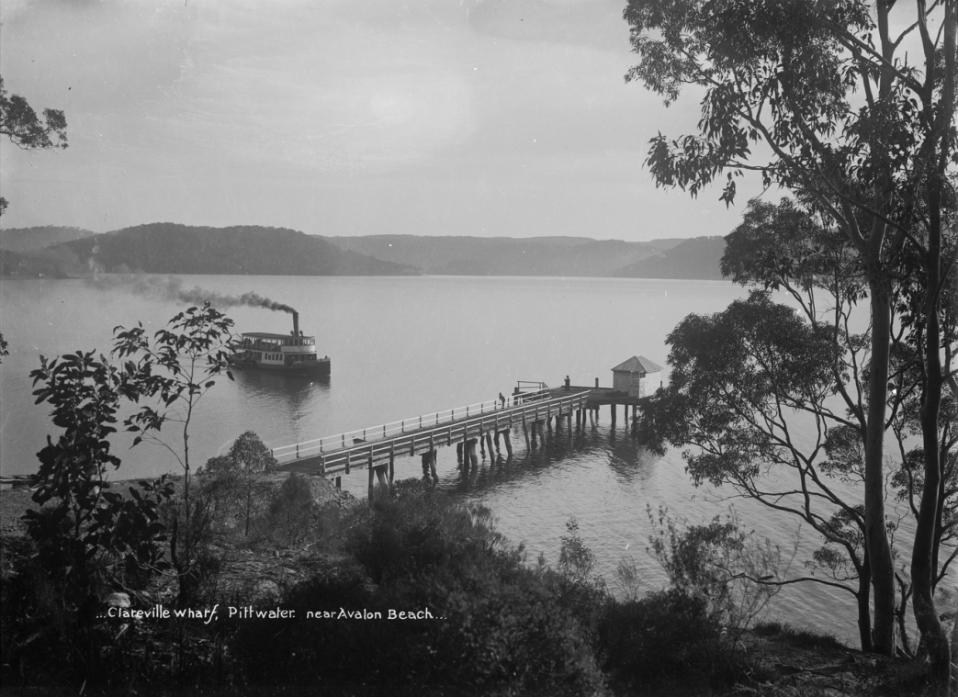March 31 - April 6, 2019: Issue 399
Pittwater Roads II: Where The Streets Have Your Name - Clareville
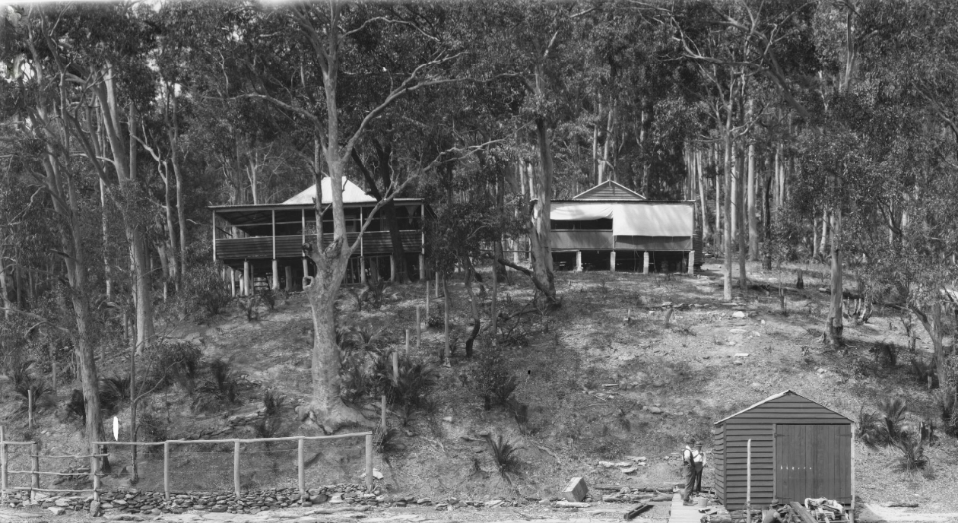
.jpg?timestamp=1553725151454)
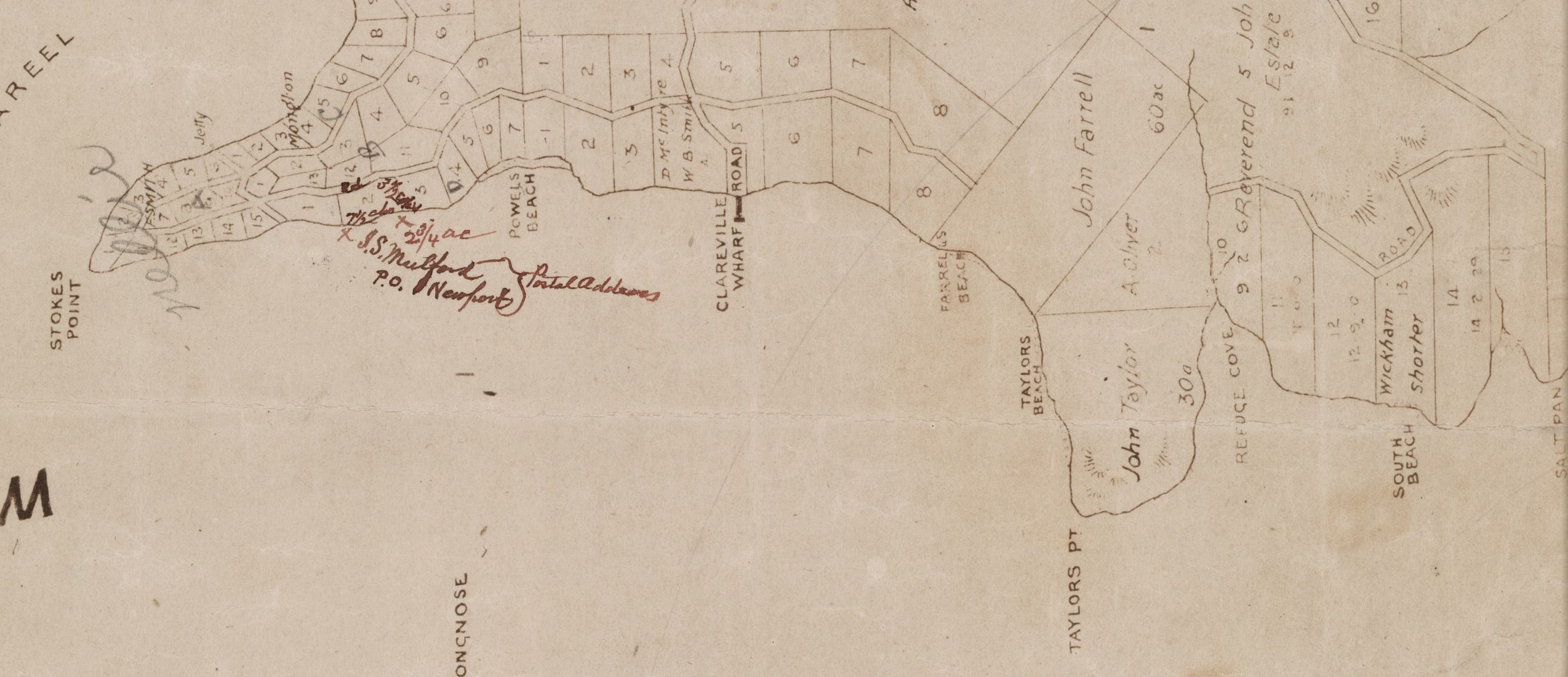
Sections from: Plan of Bay View and Pittwater district - No boundaries shown, circa 1900- 1901, Item No.: c053460078, courtesy State Library of NSW. Showing 'Powel's Beach', 'Clareville Wharf', 'Farrell's Beach' and 'Taylor's Beach'.
An earlier stylised picture version of what we now call 'Clareville' was identified by local history buff Roger Sayers and President of the Avalon Beach Historical Society, Geoff Searl OAM in an article they published in PON during 2017 and again in a condensed version in 2018. Visit: Retracing Governor Phillip's Footsteps Around Pittwater: The Mystery Of The Cove On The East Side by Roger Sayers And Geoff Searl
This shows the original custodians enjoying life on this side of the Pittwater estuary and even, apparently, dancing with the newcomers:
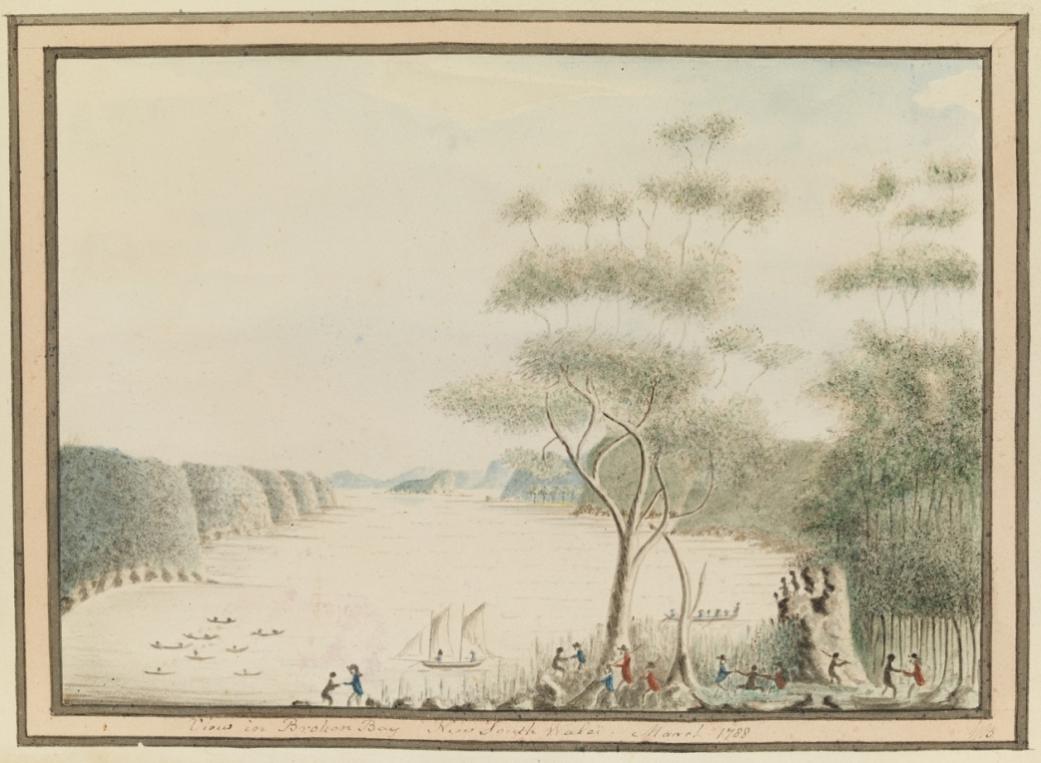
The area south of Clareville beach had been named after a gentleman with the surname 'Taylor'. Shelagh Champion OAM and George Champion OAM, in their Profiles of the Pioneers in Manly, Warringah and Pittwater (1996 - revised 2013), state:
“So far back as 1840, a Mr Samuel Taylor who had just arrived in the colony, with his wife and family, from England, purchased a farm at the locality in question, adjoining the Mona Vale farm. He immediately commenced to fence and improve it, and built a substantial house at a cost of £350; but Mrs Taylor dying in Sydney just as the house was finished, and before it was occupied, Mr Taylor, instead of going into farming pursuits himself, determined to let the place.He shortly afterwards secured an eligible tenant, who was about to take possession, when word was brought that the house and premises had been totally destroyed by fire. In a letter received a few days since from Mr Taylor, who now resides in the Bathurst district, that gentleman, in reference to the treatment which he experienced, says: ‘When it was known that I had let the place, those parties who had the benefit of my ground, and would of course lose the benefit of their cattle grazing there if the tenant had come, rendered the place useless to any one by maliciously firing the dwelling-house; and the fences having all been destroyed, the place has lain waste ever since; and Mr Farrell has had the use and benefit of my land for a number of years.’”
The name 'Claraville' was also an early one for the area and persisted into the 1930s - along with 'Clareville' - one of the earlier instances appears in this land sale:
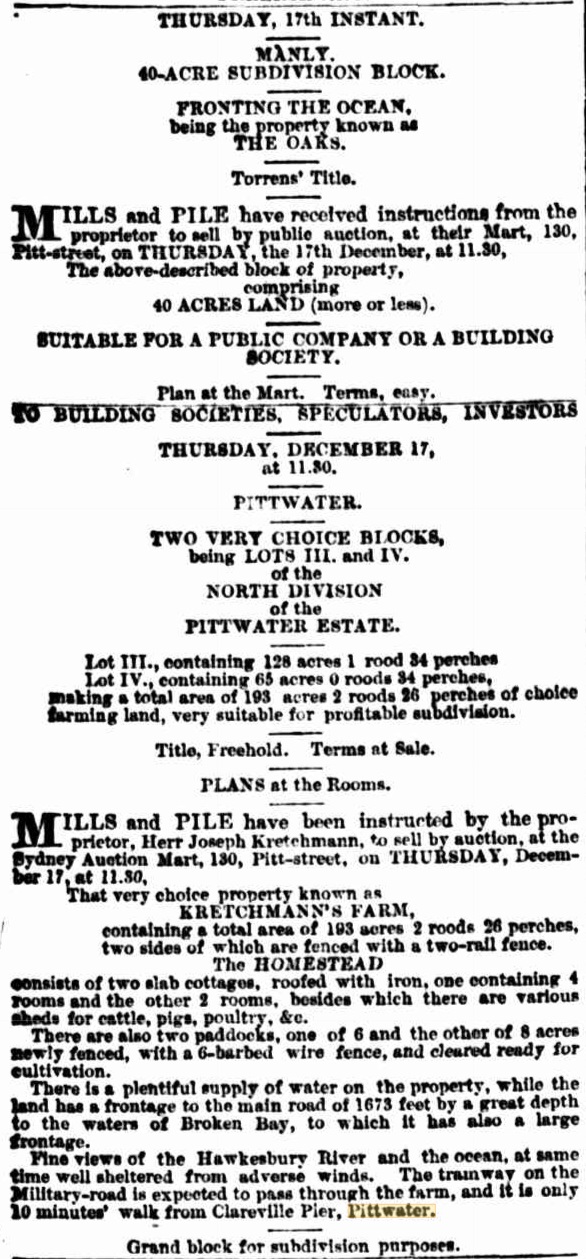
Advertising (1885, December 12). The Sydney Morning Herald (NSW : 1842 - 1954), p. 18. Retrieved from http://nla.gov.au/nla.news-article13606422
PITTWATER ESTATE. TWO VERY CHOICE BLOCKS, being LOTS III. and IV. of the NORTH DIVISION known as KRETCHMANN'S FARM. containing a total area of 193 acres 2 roods 28 perches, two sides of which are fenced with a two-rail fence. THE HOMESTEAD consists of two slab cottages, roofed with Iron, one containing 4 rooms and the other 2 rooms besides which there are various sheds for cattle, pigs, poultry, &c. There are also two paddocks, one of 6 and the other of 8 acres, newly fenced with a 6-barbed wire fence, and cleared ready for cultivation. There is a plentiful supply of water on the property, while the land has a frontage to the main road of 1673 foot by a great depth to the waters of Broken Bay, to which it has also a large frontage. Fine views of the Hawkesbury River and the ocean, at same time well sheltered from adverse winds. The tramway on the Military-road is expected to pass through the farm, and it is only 10 minutes walk from Claraville Pier, Pittwater. Grand block for subdivision purposes. Advertising. (1886, January 11). The Sydney Morning Herald(NSW : 1842 - 1954), p. 12. Retrieved from http://nla.gov.au/nla.news-article28359687
DEEP WATER FRONTAGE suit boatshed baths situated Claraville Pittwater £175. _No 6957 Herald. Advertising (1938, December 22). The Sydney Morning Herald (NSW : 1842 - 1954), p. 18. Retrieved from http://nla.gov.au/nla.news-article17550838
The Josef (Joseph) Kretchmann referred to above was one of Sydney's premier musicians, born in Austria. He was having a few money problems in 1885-1886, and appears among those being pursued for bankruptcy in June 1886. The farm was probably being sold to meet those debts.
On 29 June 1885 Lix’s attorney sold the farm to Josef Kretschmann, Professor of Music, for £1162. A contract for sale to John Davison was transacted on 5 February 1886. [LTO Book 336 No. 603] On 18 May 1886 an order was made by the Chief Commissioner for Insolvent Estates, placing Kretschman’s estate under sequestration. The official assignee of the estate, Lancelot Threlkeld Lloyd, finally conveyed the estate to John Davison on 20 February 1888. [LTO Book 381 No. 150] Davison paid £816 1s 6d to Lloyd, and £30 to Simeon Frankel. from - Profiles of the Pioneers in Manly, Warringah and Pittwater (1996 revised 2013), Shelagh Champion, OAM, B.A.(Lib.Sc.)and George Champion, OAM, Dip.Ed.Admin.
Gustave Adolphe Lix came out to Australia from France for the 1881 International Exhibitions in Sydney and Melbourne, then stayed on, is shown in possession of 640 acres where one of the origins of Mullet Creek flows towards Irrawong's 'water pond' at Warriewood. The family surname of Heydon and it is in a cancelled Land Map of 1905 that we see the 640 acres of Warriewood Gustave Lix land has now been ascribed to J K Heydon. Born in or close to 1836, Monsieur Lix would have been around 50 years of age when his name was affixed to land in Warriewood in 1886, the same year Leon Houreaux, another French gentleman 'farmer' and timber cutter in Warriewood prior to then, applied for a publicans licence, and within months of Mr. Lix turning 70 in 1905 - time to retire from hard work in any man's language....or to invest elsewhere....We have found no proof of a connection between the two Frenchmen, but it beggars belief that they did not know each other while in the same valley in the same year and of the same culture.
To be noted is Shelagh Champion, OAM, B.A.(Lib.Sc.) and. George Champion, OAM, Dip listing Mr. Lix as a 'farmer' as well in their Profiles of the pioneers in Manly Warringah and Pittwater - 1996, revised 2013.
John Collins purchased twelve lots in the Brighton (Josephton) subdivision, totalling approximately 4¾ acres, for £12 on December 2nd 1880. On the same day his brother Frank purchased three lots for £9. Sales may have been slow, for a further advertisement appeared in the Herald on 9 and 12 May 1881 advertising a sale by auction. At this auction, on Monday May 16 1881, Collins’ farm, consisting of Block III (128acres 1r.34p.) and Block IV (65 acres 0r. 32p.) of the North Division of the estate, were sold to Gustave Adolphe Lix, farmer, for £1018 10s 8d.
Lix offered Collins’ homestead buildings for use as a school in June 1882. In January 1885 Lix appointed an attorney, and went overseas. By 16 May 1885 he had paid £250 of the purchase money, the balance owing to the trustees being £866 6s. 0d. On 29 June 1885 Lix’s attorney sold the farm to Josef Kretschmann, Professor of Music, for £1162. As seen above, a contract for sale to John Davison was transacted on 5 February 1886. On 18 May 1886 an order was made by the Chief Commissioner for Insolvent Estates, placing Kretschman’s estate under sequestration. The official assignee of the estate, Lancelot Threlkeld Lloyd, finally conveyed the estate to John Davison on 20 February 1888. Davison paid £816 1s 6d to Lloyd, and £30 to Simeon Frankel.
This notice, which describes the property, and records that Leon Houreaux worked as a woodcutter prior to opening the Rock Lily Hotel seems most telling, or confirming:
TO SPECULATORS -Splendid unique chance. Right to M. C. P. Block of 640 acres at Narrabeen; splendid position, plenty of water, part cleared, and dwelling on It. For particulars and Inspection apply at Rocklily Hotel, Pittwater-rd. Advertising. (1886, July 31). The Sydney Morning Herald (NSW : 1842 - 1954), p. 17. Retrieved from http://nla.gov.au/nla.news-article13632453
THE SYDNEY MUSICAL UNION
The first performance in New South Wales of Mendelssohn's Scotch Symphony by the Sydney Musical Union, under the conductorship of Herr Joseph Kretschmann which took place on Saturday last, attracted a brilliant and fashionable audience. The orchestra consisted of about 80 of the leading amateur and professional musicians of Sydney. ... AMUSEMENTS. (1885, January 28). The Sydney Morning Herald (NSW : 1842 - 1954), p. 7. Retrieved from http://nla.gov.au/nla.news-article13576626
He passed away in April 1918. A Joseph Krechmann Club existed in Sydney during the 1920's and into the 1930's:
JOSEF KRETCHMANN.
SYDNEY. April 30.
Death removed in Josef Kretschmann one of the most familiar figures in Sydney's musical circles, one who had given the best years of his life to the music of this city, and who had endeared, himself to a host of pupils, his age was 80. He was a typical German of the old type, genial, and immensely kind-hearted,. He gave many free lessons, and was always ready to listen to an appeal for help. ln late years his health had been precarious, and, since the war, this condition had been aggravated. On the door of his room a few days ago, lie scrawled in. a trembling hand a notice containing the words, "I am sick for a change." His long day was closing. JOSEF KRETCHMANN. (1918, May 3). The Week (Brisbane, Qld. : 1876 - 1934), p. 24. Retrieved from http://nla.gov.au/nla.news-article188924793
He had given many musical talent:
STATE ORCHESTRA.
The child prodigy of Joseph Kretchmann, Miss Ruby Rich, has returned to her homeland. After several years spent on the Continent, and Sydney audiences are to have the pleasure of hearing her with the State Orchestra on November 3, at the Conservatorium Hall. STATE ORCHESTRA. (1921, October 30). Sunday Times (Sydney, NSW : 1895 - 1930), p. 17. Retrieved from http://nla.gov.au/nla.news-article123237503
Lots III and IV weren't '10 minutes from Clareville Pier' unless you had a very fast horse and a good road!
It would appear the advertisers are calling the Careel Bay wharf by the same name as no wharf or pier is indicated on the 1882 sales map or any other map.
The name 'Clareville' being applied to that pier is a reference to the original land grantee, Archpriest John Joseph Therry who had installed a pier, or wharf at Careel Bay by 1862 for an April excursion of that year, aboard the SS Collaroy, under the command of Captain William Mulhall, brother of George Mulhall, the first light keeper at Barrenjoey.
Born in Cork and educated at St Patrick’s, Carlow, Therry was ordained in 1815 and did parochial work in Dublin and Cork before sailing to Sydney in May of 1820 aboard the Janus, a transportation ship carrying over 100 Irish men and women convicts.
As one fellow traveller, Cruig Barry, when visiting the just purchased property of a friend on 'Long Beach', the name then given to Clareville Beach, in the late summer of 1880 states in 'A Trip to Pittwater', in describing the trip aboard the first boat to Manly;
Another harbour, pre-eminent for its capacity and safety,' and no mean rival of our own is more blessed in this respect, for the melody of the Shandon Chimes supplies the void felt here. On this I ponder,
Where'er I wander,
And thus grow fonder,
Sweet Cork, of thee ;
Why thy bells of Shandon,
That sound so grand on
The pleasant waters
Of the river Leo.
The reference to Cork, Ireland, points out that the name likely given to that pier, by an Irishman in Therry, stems from reminiscence about where he came from and how that compared, or reminded him of, the bright bay Careel Bay is, whichever season you see it in - a brightness that also applies to Clareville.
'Scorcha' is common to both the Irish and Scottish Gaelic languages, and is derived from a Gaelic word meaning "brightness". In Scotland, Sorcha has traditionally been Anglicised as 'Clara', which retains the name's Gaelic meaning: the English Clara is derived from the Latin clarus, meaning "bright", "famous". The word 'ville' has a definition: ( denoting ) a place, condition, or quality with a character as specified, - a combining form extracted from place names ending in -ville,.
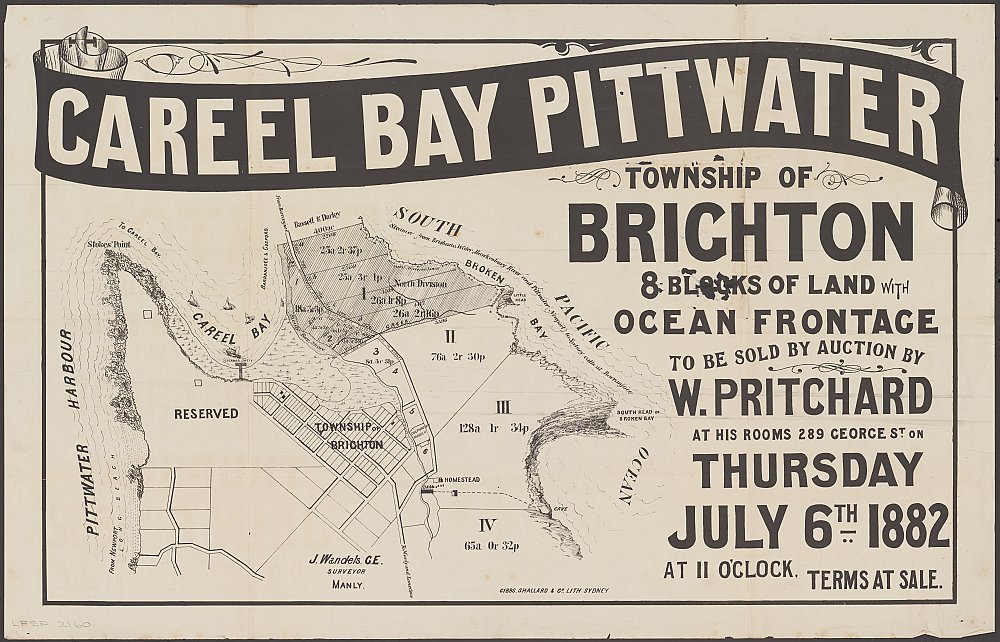
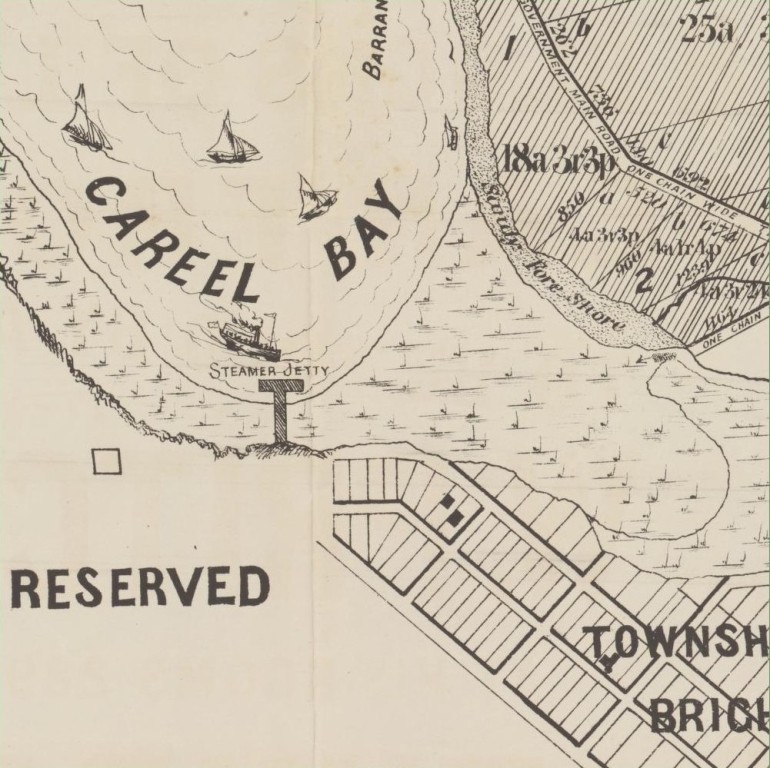

Careel Bay Pittwater [cartographic material] : township of Brighton, 8 blocks of land with ocean frontage 1882. MAP Folder 135, LFSP 2160 by Pritchard, W., courtesy National Library of Australia.
On May 3rd 1880, Richardson and Wrench offered the Therry estate, as they did again the following year:
PITTWATER and CAREEL COVE.
The whole of the residue of
THE PITTWATER ESTATE.
Also,
STOKES POINT, which is now subdivided into VILLA SITES, fronting CAREEL COVE
and PITTWATER.
adjoining the Township of BRIGHTON, PITTWATER.
RICHARDSON and WRENCH have received instructions to sell by public auction, at the Rooms, Pitt-street, on MONDAY, 16th May, at 11 o'clock, The whole of the unsold lots of
THE PITTWATER ESTATE, as follows :
NORTH DIVISION.
TWO CHOICE FARMS.
No. III. Area. 128 ACRES 1 ROOD .14 PERCHES, having frontages to the PACIFIC OCEAN and the MAIN ROAD to BARRENJOEY, on which is the HOMESTEAD and, RESIDENCE now in the occupation of JOHN COLLINS, Esq.. and also the CELEBRATED CAVE.
No. IV. Area, 65 ACRES and 32 PRRCHES, adjoining the above, and which are the WELL-KNOWN SPRINGS.
SUBURBAN SITES.
Nos. 8 to 16 and 10 and 20, surrounding the TOWNSHIP OF BRIGHTON, in areas from 2 ACRES 3 ROODS 35 PERCHES to 9 ACRES 3 ROODS 10 PERCHES, having frontages to the MAIN PITTAVATER ROAD and other roads and streets, all 1 chain wide.
Nos. 1A and 2A. Areas. 5 ACRES 3 ROODS 21 PERCHES and 7 ACRES 34 PERCHES respectively, overlooking PITTWATER.
SOUTH DIVISION.
Nos. IV. and V. TWO FINE FARMS, areas 97 ACRES 3 ROODS 17 PERCHES, and 91 ACRES 2 ROODS 9 PERCHES respectively.
No. VI. A FARM of 127 ACRES 3 ROODS 29 PERCHES, near SALTPAN COVE and the TOWNSHIP of NEWPORT.
Lots 5 to 8 and 5A to 8A. EIGHT CHOICE VILLA SITES in PITTWATER, fronting LONG BEACH ; areas from 4 ACRES 2 ROODS 10 PERCHES to 17 ACRES 27 PERCHES.
Lots 9 and 11. TWO SMALL FARMS in REFUGE BAY; areas. 25 ACRES 1 ROOD 6 PERCHES, and 11 ACRES 1 ROOD 24 PERCHES.
Lots 16 to 21, and 24 and 25. S GRAND BLOCKS of RICH SOIL in CABBAGE-TREE VALE, on BILGOLA BEACH : areas, from 5 ACRES 2 ROODS 36 PERCHES to 21 ACRES 1 ROOD.
Lot 26. A SMALL FARM, fronting the RECREATION RESERVE on OCEAN BEACH ; area, 12 ACRES 3 ROODS 8 PERCHES.
STOKES' POINT, PITTWATER.
ADJOINING THE TOWN OF BRIGHTON, AT THE STEAMERS WHARF.
The whole of this Magnificent Point will be submitted in lots, as per lithograph, now published, viz..
Section A. 15 VILLA SITES; areas. 3 ROODS 17 PERCHES to 2 ACRES 20 PERCHES.
Section B. 14 VILLA SITES : areas. 1 ACRE 10 PERCHES to 6 ACRES 3 ROODS 32 PERCHES
Section C. 9 VILLA SITES. CAREEL BAY ; areas. 1 ACRE 3 ROODS 34 PERCHER to 4 ACRES 21, PERCHES
Section D. WATER FRONTAGE SITES; areas. 2 ACRES to 4 ACRES 21 PERCHFS. PITTWATER HARBOUR
Section E. 10 VILLA SITES, adjoining the TOWN OF BRIGHTON : areas. 1 ACRE 11 PERCHES to 4 ACRES 1 ROOD 23 PERCHES.
This subdivision is well worthy of attention, as there is no doubt that PITTWATER will become an important and attractive resort for our BUSINESS MEN requiring CHANGE OF AIR, QUIET, and REST from the busy turmoil of the city.
The communication between the city and Pittwater is now more frequent than formerly, besides having the coaches daily from MANLY BEACH, there are now commodious fast steamers plying regularly from the city.
The NORTHERN RAILWAY will pass within 7 miles of CAREEL COVE at Pittwater.
TERMS EXCEEDINGLY LIBERAL AT SALE.
LITHOGRAPHS are now READY FOR DISTRIBUTION.
Messrs. ELLIS and MAKINSON, Elizabeth-street, are Solicitors of the vendors. Day of Sale, MONDAY NEXT. Advertising (1881, May 12). The Sydney Morning Herald (NSW : 1842 - 1954), p. 9. Retrieved from http://nla.gov.au/nla.news-article13479502
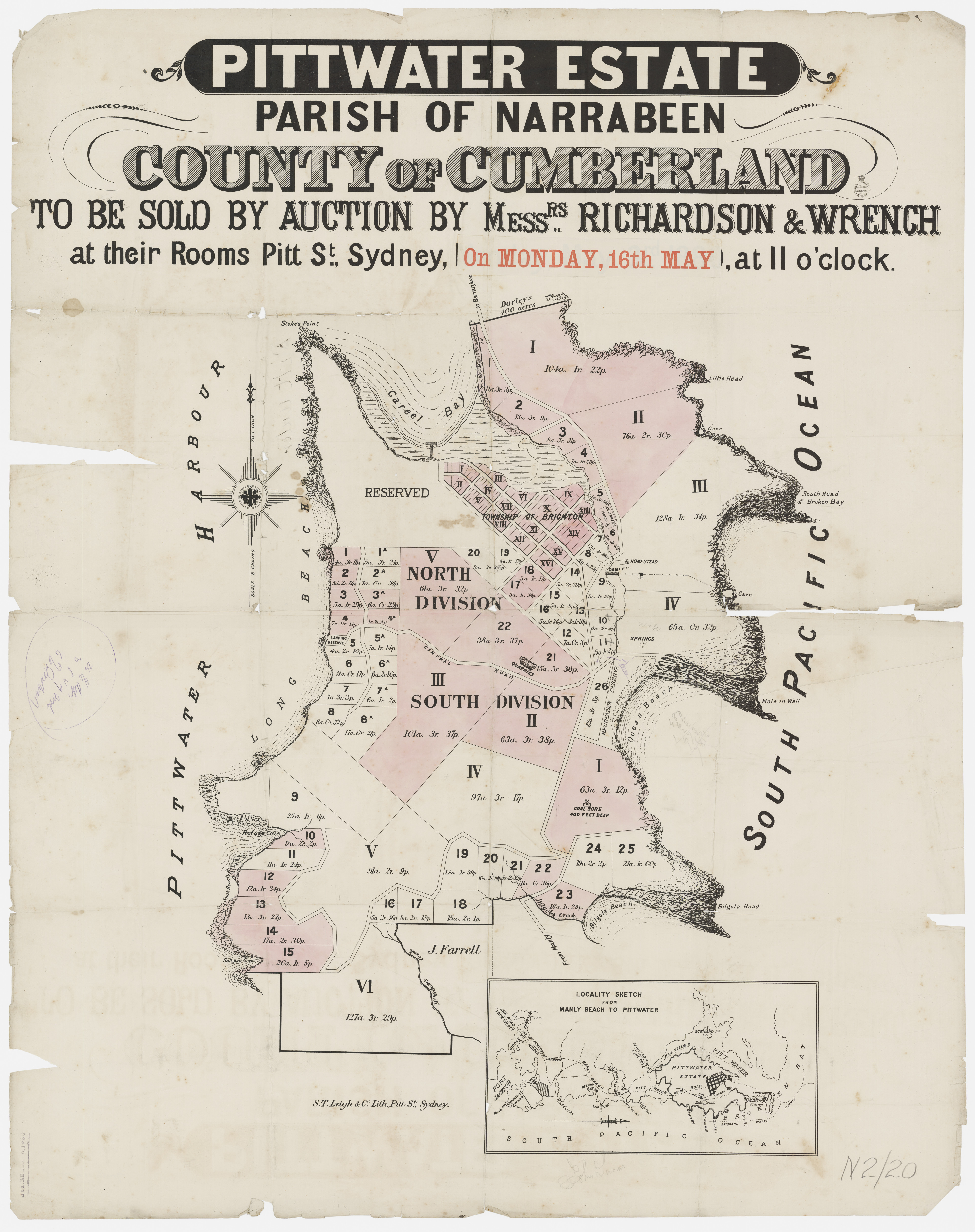
Pittwater Estate Monday May 16th, 1881 - Richardson and Wrench - Item c050370020, courtesy State Library of New South Wales.
Mr. Barry's A Trip to Pittwater in full, since it describes the then of what we call 'Clareville' now:
A TRIP TO PITTWATER.
Some friends of mine having purchased part of the Pittwater estate recently offered for sale, were anxious to see the land, and they invited me to accompany them. Saturday last was fixed for the trip. On that morning we were all up betimes. The night before we agreed that whoever rose earliest should call the others. Being known to rise on the first sound of the ' cock's shrill clarion,' I was expected to rouse my friends. At 5 o'clock when I went to do so I found that one of them had been up two hours, the others even longer. They had evidently worried themselves into wakefulness all night, for which there was no necessity, as a late sleeper might catch the first Manly boat, by which we were to leave Sydney. Saturday morning broke in smiling silence on the city and suburbs: it was one of those mornings which call forth praise and prayer to heaven for the blessing of such a climate as we enjoy in this Southern land. The waters of the harbour from our point of view (the heights of North Shore)looked like several lakes which were as calm as millponds. Our unrivalled harbour, it appears to me, presents scenes at, daybreak and by moonlight that cannot be viewed at any other time.
In summer mornings, before the sun rises, you may see creeping over the waters of its various nooks and bays gauze-like exhalations, which magnify the ships and boats in the stream. On the appearance of the great, vaporizer the mist is dispelled and the grand picture we all admire is unveiled. The nocturnal beauty of Port Jackson one never ceases to admire. Music only is wanted to make a moonlight view of it one of the most pleasurable sensations. Another harbour, pre-eminent for its capacity and safety,' and no mean rival of our own is more blessed in this respect, for the melody of the Shandon Chimes supplies the void felt here. On this I ponder,
Where'er I wander,
And thus grow fonder,
Sweet Cork, of thee ;
Why thy bells of Shandon,
That sound so grand on
The pleasant waters
Of the river Leo.
On board the Royal Alfred we were joined by a young gentleman who was also a guest. There were not more than half-a-dozen other passengers besides our party. Some of them looked sleepy and sullen, and appeared as if they had parted on bad terms with Morpheus. One of them who was late had to jump on board. The unamiable mood in which he appeared soon gave way to perfect equanimity, the effect, as one observed, of the soothing influence of the incense from the North Shore gums.
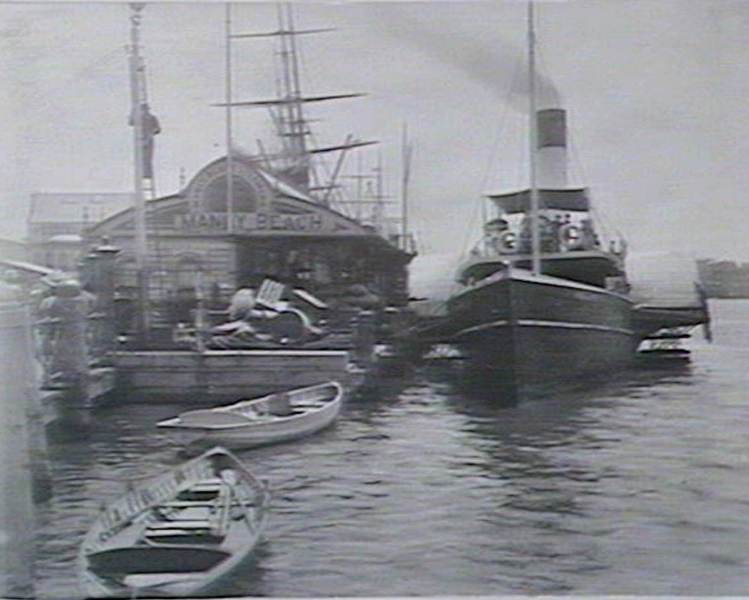
"Royal Alfred" at wharf Circular Quay, date; 9/1935 (?!), Image. No: d1_20453, courtesy State Library of NSW.
Arrived at Manly, we had an appetite for breakfast which many might, envy. This watering place reminds one of Passage, which Father Prout describes as situated
Upon the say;
'Tis nate and dacent,
And quite adjacent
To come from Cork,
On a summer's day.
The 'trap' which was awaiting us at, the hotel door, and which had been bespoken, was certainly not one of Kearey Brothers'. It had the appearance of a disused milk-cart, or a superannuated costermonger's conveyance. Our young companion did not like the look of it, but on being told there was no other available for our journey, he had sufficient of the Stoic in him to sink his personal feelings. Needs must when a Manly coach proprietor commands the drive to Pittwater. There is nothing very charming in the neighbourhood of the Pittwater road from Manly. Ducks and water fowl might find it a suitable abiding locality, but Manly-ites, if they have any regard for the future repute of their rising suburb, will extend it on the higher ground Spitwards.
Some four or five miles out of the township we overtook the 'royal mail coach' with its convoy conveying the mails and passengers to Boulton's or Newport at the head of the navigation of the Pittwater harbour. We sailed alone in this company until we crossed the Narrabeen Lagoon. As we emerged there from we descried a church, which appeared to be as well supported as the Smithy described in one of Swift's anecdotes. Seeing no residents around, we inquired where the congregation came from, but our Jehu was not a Matt Ryan. Indeed he was the most taciturn ' whip ' I ever travelled with.
Shortly after we entered upon the estate at Bilgola beach, where there is a deep leafy glen well adapted for the growth of bananas. On ascending to Bilgola Head a splendid view of the coast from Cabbage Tree Head to Barranjoee is obtained. The broad Pacific lay on our right at that moment as placid as Farm Cove. A splendid valley lay before us with the homestead of the patriarch of Pittwater, Mr. John Collins, in the distance; on the left, undulating land, well timbered.
Descending to the valley, we crossed the farm purchased by Mr. Canty, which is believed to be carboniferous. Some years ago competent judges gave it as their opinion that coal existed there. A bore of four hundred feet, made in the ground many years ago, when an attempt was made to test it, passed through strata that indicated the immediate vicinity of the black diamond. Mr. Coghlan's diamond drill would soon settle the question whether coal could be struck there. Mr. Collins's farm is situated in the valley, being flanked on the east by St. Michael's Cave and the South Head of Broken Bay, and on the West by Mount St. Mary.
After doing full justice to Mr. Collins's hospitality, we sallied forth under his guidance to survey that part of the estate in which we were interested. We directed our steps towards Long Beach, nearly opposite Scotland Island, Pittwater Harbour. The land improved as we receded from the valley. Indeed we were agreeably surprised at finding soil and slope not excelled by any locality we had seen on the coast, except Irishtown, Lane Cove. My friends were delighted with their investment, and were only sorry they had not purchased more of the land.
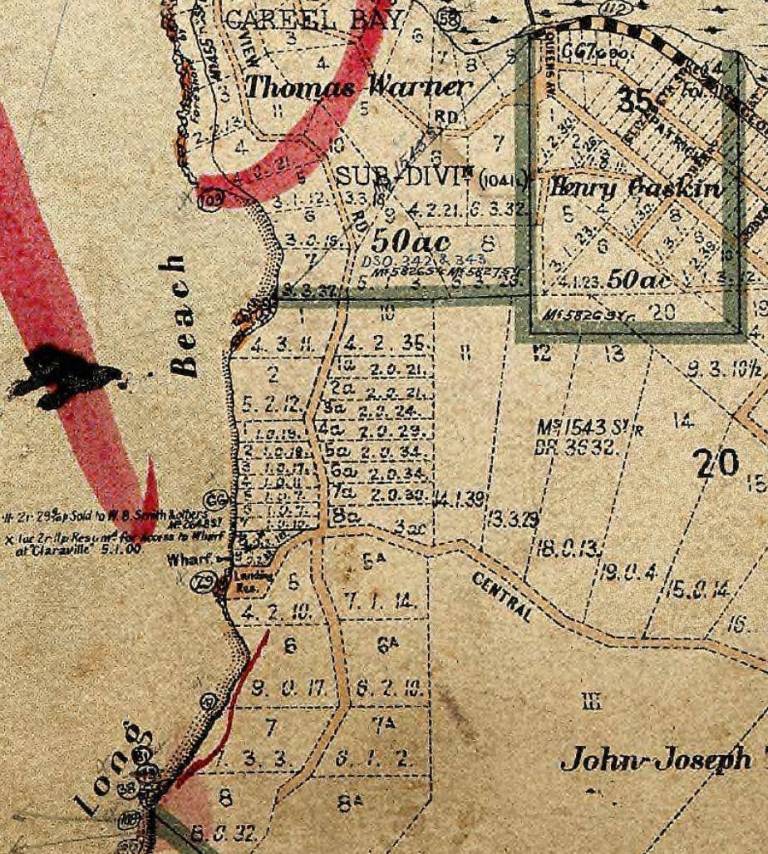
Pre- 1905 Land Titles Map - Showing 'Claraville' and 'Long Beach' and land taken from 'W.B. Smith & others at 'Claraville''. Courtesy Land Titles Office Historic records of NSW.
Pittwater estate belonged to the late Very Rev. Archpriest Therry, who bequeathed it to the Society of Jesus. It is surrounded on all sides save one by water; and it has been highly praised for its salubrity. It has a Catholic church, at which the Rev. Dr. Hallinan officiates once a month; it has also a Provisional school, attended by some twenty children.
There is an incipient town called Brighton at Careel Bay, north-west of Barranjoee. The site is eminently unsuited for a township, and the sooner it is abandoned the better. A low swampy beach from which the water recedes at ebb tide, is not well adapted for settling on. A better site is that on the harbour higher up at Long Beach, where there is ‘ample room and verge ' enough, besides a moderately elevated coast and deep water. West Carbery, as we christened the place, is the site for a township.
A large block of land at Stokes's Point is reserved for a College. The scenery at Pittwater and on the greater part of the way thither is simply grand. When the road is better— (Mr. Collins informed us there is money on the estimates to form it all the way), and when a better style of conveyance is available, I know of no place or drive that will present so many attractions to the invalid, the pleasure or holiday-seeker. Everything conspires to quiet the anxieties of the mind and invigorate the body. Wooded slopes and deep ravines, picturesque views of ocean, beach, and headland, are features that would dissipate the megrims of a miser or restore peace to the mind of a rejected swain. Notwithstanding the discomforts we laboured under from the vile vehicle we had, we enjoyed the trip to and fro uncommonly well, and arrived at 7 in the evening at Manly without any mishap beyond that which a little application of Australian Ointment will remedy, as our young friend of bills and briefs said.
CRUIG BARRY.
11th May, 1880.
A TRIP TO PITTWATER. (1880, May 22). Freeman's Journal(Sydney, NSW : 1850 - 1932), p. 19. Retrieved from http://nla.gov.au/nla.news-article133488037
You can understand Mr. Barry's references to 'Cork', once again, when finding 'West Carbery' is a barony in County Cork in Ireland. It has been split since the nineteenth century into East and West Divisions (an Roinn Thoir/Thiar).
Baronies were created after the Norman invasion of Ireland as divisions of counties and were used for the administration of justice and the raising of revenue. While baronies continue to be officially defined units, they have been administratively obsolete since 1898. They continue to be used in land registration and in specification, such as in planning permissions. In many cases, a barony corresponds to an earlier Gaelic túath which had submitted to the Crown.
Carbery West originally formed a single Barony of Carbery with Carbery East. This was essentially a small, semi-independent kingdom, ruled over by the MacCarthy Reagh dynasty from the 13th through 16th centuries, that broke away from the larger Kingdom of Desmond.
Carbery West is bordered by the baronies of Carbery East to the east and [Bantry (County Cork barony)|Bantry]] to the north. To the south and west is a long indented coastline; the Celtic Sea as far west as Mizen Head, and thence around Dunmanus Bay to Bantry Bay.
Clareville wharf, the first one as a public wharf, was built a few decades after the 'Clareville pier' referred to above - although there is a Clareville wharf mentioned just a few years after the advertisement for the Kretchmann farm when calling for tenders for 'an approach' (road).
Some historians have stated that Avalon Beach was once named 'Clareville Beach' too, so the name was around - possibly from that first 1862 disembarking of visitors from the S.S. Collaroy at Careel Bay and their romp to 'Monks cave' or St Michael's Cave as we now call it - with records that further point to this being the name given to the wharf at Careel Bay built by Therry for access to the lands in with the roads department calling for tenders and then an early application by a landowner to bring their acreage under the Real Property Act naming that access road as the Clareville Wharf Road and naming surrounding landowners that locate where that first Clareville wharf and Clareville wharf road was:
Department of Public Works, Sydney,
12th August, 1887.
TENDERS will he received at this Office until 11 o'clock on MONDAY, the 22nd instant, from persons willing to Contract for
16q. Pittwater to Barreujuee
17q. Approach to Clareville Wharf, Pittwater.
Tenders to be addressed to P. H. FLYNN, Chief Clerk, Roads Department, where specifications and sections may be seen. Advertising (1887, August 18). The Sydney Morning Herald (NSW : 1842 - 1954), p. 2. Retrieved from http://nla.gov.au/nla.news-article13659039
No. 13,259. County of Cumberland, parish of Narrabeen, 101 acres 1 rood 381 perches, situated on Clareville Wharf Road, Clareville,—is Block No. 3, South Subdivision, Pittwater Estate, and is part of 1,200 acres (portion No. 20 of parish) granted to John Joseph Therry; adjoining the properties of F. Burne, J. Robertson, S. Smith, and G. A. Smith, Trustees of Mrs. Evans, or J. G. Cousins, G. Holland, The London Bank of Australia, and J. H. Parry. – Applicant: Margaret Allan, Mosman. Day until which Caveats may be lodged: 17th February, 1905. NOTICE UNDER REAL PROPERTY ACT. (1904, December 30). Government Gazette of the State of New South Wales (Sydney, NSW : 1901 - 2001), p. 9437. Retrieved from http://nla.gov.au/nla.news-article226488010
The name 'Clareville' applied to the area at what we now call, 'Clareville' on the Pittwater estuary appears in - although this wharf is already in existence:
GOVERNMENT GAZETTE.
Land has been resumed at Clareville, Pittwater, for a wharf... GOVERNMENT GAZETTE. (1900, January 8). Evening News (Sydney, NSW : 1869 - 1931), p. 3. Retrieved from http://nla.gov.au/nla.news-article117033146
The location of that wharf and resumption notice (how much was taken) shows as 1 acre, 2 roods and 11 perches being taken from 'Claraville' for construction of a wharf and a landing reserve:
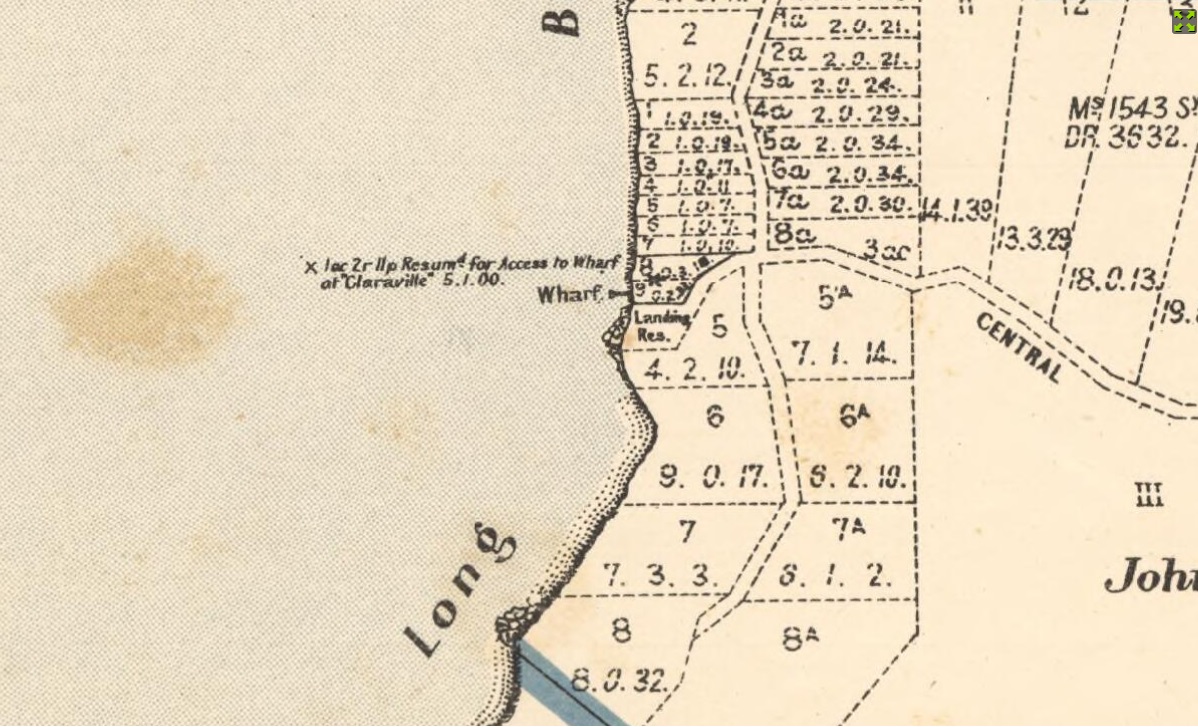
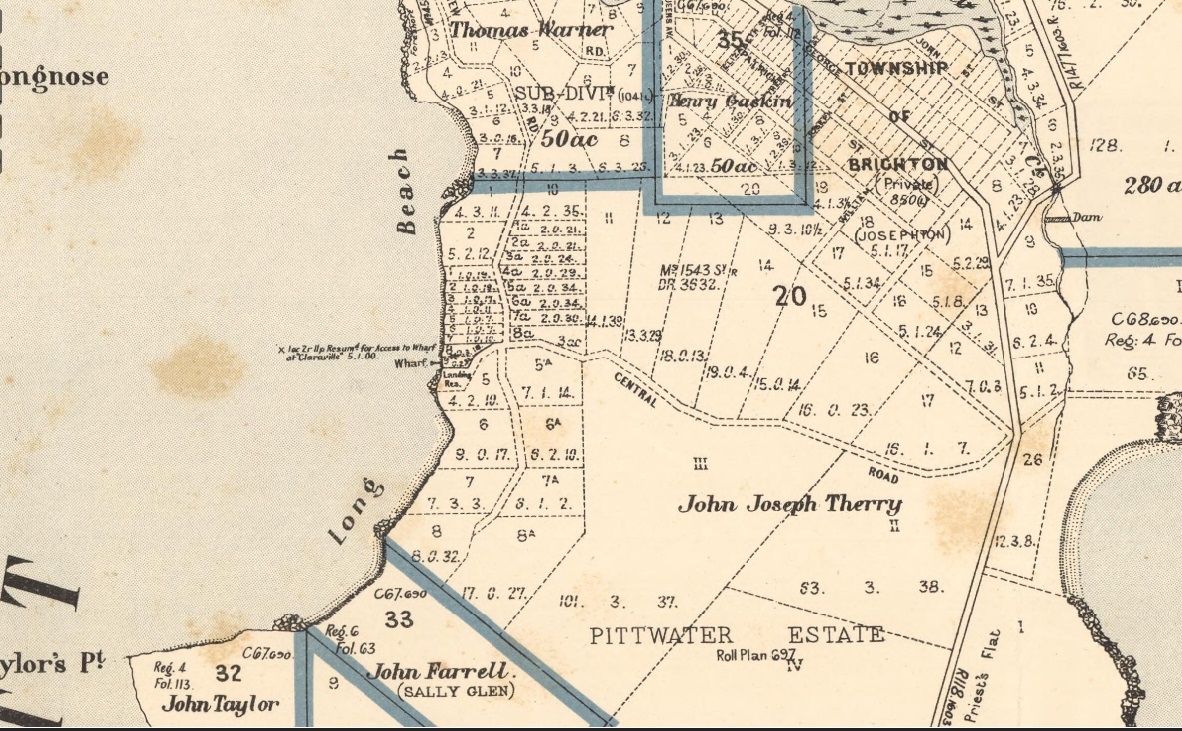
Sections from New South Wales. Department of Lands. (1905). Parish of Narrabeen, County of Cumberland Metropolitan Land District, Eastern Division N.S.W Retrieved from http://nla.gov.au/nla.obj-233833612
At the location of the Clareville land resumed for a wharf and landing place (probably for materials to be landed to build homes and in anticipation of all the new produce that would come from the Therry land grant now divided into 'farms') a 'Claravilla' is named at the spot.
The resumption notice states:
NOTIFICATION OF RESUMPTION OF LAND UNDER
THE "LANDS FOR PUBLIC PURPOSES ACQUISITION ACT," 44 VICTORIA No. 16.
PROCLAMATION
New South Wales,
to wit,
(L.S.)
BEAUJCHAMP,
Governor.
By His Excellency The Right Honourable William, Earl Beauchamp, Knight Commander of the Most Distinguished Order of Saint Michael and Saint George, Governor and Commander-in Chief of the Colony of New South Wales and its Dependencies.
WHEREAS a certain public work, that is to say the construction of a Wharf at Clareville, Pitt Water, in the said Colony, has been duly carried out, and whereas it has been found necessary to acquire the lands described in the Schedule hereto for the purpose of the said public work, that is to say, for a way of access in connection therewith, and for the acquisition of which, said lands public funds are lawfully available: Now, therefore, I, William, Earl Beauchamp, the Governor of the said Colony aforesaid, with the advice of the Executive Council, in pursuance of the powers in this behalf given to or vested in me by the "Lands for Public Purposes Acquisition Act," do, by this notification to be published in the Government Gazette, and in one or more newspapers published or circulated in the Police District wherein the said lands are situated, declare that the Crown Land comprised within the descriptions set forth in the Schedule hereto has been appropriated, and the private property within such descriptions has been resumed, for the public purpose aforesaid, to the intent that upon the publication of this notification in the Gazette, the legal estate in the said lands described in the Schedule hereto shall forthwith be vested in the Minister for Public Works and his successors, on behalf of her Majesty, for the purposes of the said Act, for an estate of inheritance in fee simple, in possession, freed and discharged from all trusts, obligations, estates, interests, contracts, charges, rates, rights-of way, or other easements whatsoever; and to the intent further, that the legal estate therein, together with all powers incident thereto or conferred by the said Act, shall be vested in the said Minister as a Trustee; and I declare that the following is the Schedule of the lands hereinbefore referred to : —
Schedule.
All that piece or parcel of land situate in the parish of Narrabeen, county of Cumberland, and Colony of New South Wales, being part of the land comprised in certificate of title registered volume 1,294, folio 169: Commencing at the north western corner of a reserve for access; and bounded thence by the northern boundary of that reserve bearing 92° 11' 221 1/10 feet; thence by the western boundary of a road 1 chain wide leading to Newport, bearing 28° 1' 143 feet 6 inches; thence by a line bearing 269° 16' 275 9/10 feet to the high-water mark of Pitt Water; and thence by that boundary bearing southerly, to the point of commencement,— be the said several dimensions all a little more or less, containing 2 roods 33 perches or there abouts, and said to be in the possession of James Crowley.
All that piece or parcel of land situate in the parish of Narrabeen, county of Cumberland, and Colony of New South Wales, being part of the land comprised in certificate of title, registered volume 1,294, folio 169 : Commencing on the high water mark of the eastern shore of Pitt Water, at a point bearing 6° 12' and distant 115 4/10 feet from the north-western corner of a reserve for access; and bounded thence by a line bearing 89° 16' 275 9/10, feet; thence by the north-western boundary of a road one chain wide leading to Newport, bearing 60° 32' 217 1/10 feet; (hence by a line bearing 269° 16' 445½ feet to the aforesaid high-water mark; and thence by that boundary bearing southerly, to the point of commencement,— be the said several dimensions all a little more or less, containing 3 roods 18 perches or thereabouts, and said to be in the possession of Barnett Smith and others.
In witness whereof I have hereunto set my Hand, and caused the Great Seal of the Colony to be hereto affixed, at Government House, Sydney, this twenty second day of December, in the year of our Lord one thousand eight hundred and ninety-nine, and in the sixty-third year of Her Majesty's Reign.
By His Excellency's Command,
E. W. O'SULLIVAN.
[5126] GOD SAVE THE QUEEN !
NOTIFICATION OF RESUMPTION OF LAND UNDER THE "LANDS FOR PUBLIC PURPOSES ACQUISITION ACT," 44 VICTORIA No. 16. (1900, January 5). New South Wales Government Gazette (Sydney, NSW : 1832 - 1900), p. 88. Retrieved from http://nla.gov.au/nla.news-article221011182
The Crowley Estate verges on the Clareville-Avalon Beach road gives us the first application along this way for a Real Property Act conversion of land to subdivisions:
No. 10,815. County of Cumberland, parish of Narrabeen, 135 acres 3 roods 33 perches and 9 acres 0 roods 30 perches at Long Beach, near Careel Bay, Pitt Water, adjoining the properties of E. E. Small, J. Crew, and Mrs. Powell,—compiles lots Nos. 1a,1, 2a} 3a, 4a, 3, 4, 21, 22, and part of lot V of the north division of Pitt Water Estate, and part of 1,200 acres granted to John Joseph Therry. Applicant: Jeremiah Crowley. Of North Sydney. 1 Sept 1899. NOTICE UNDER REAL PROPERTY ACT. (1899, July 14). New South Wales Government Gazette (Sydney, NSW : 1832 - 1900), p. 5273. Retrieved from http://nla.gov.au/nla.news-article221003297
A little about Jeremiah Crowley - there is more about this family's subsequent generations in Pittwater Roads II: Where the Streets Have Your Name - Avalon Beach
Death of Mr. Jeremiah Crowley.
Mr. Jeremiah Crowley, an old resident of North Sydney, died yesterday at his residence, Naremburn. The late Mr. Crowley was born In Skibbereen, Ireland, in 1837, and came to Sydney over 60 years ago. When he opened the first R.C. school 55 years ago at St. Leonards (as North Sydney was known in those days) there was almost continuous bush between Miller's Point and Hornsby. The site of the school Is now occupied by the North Sydney School of Arts. In 1879 Mr. Crowley took charge of the new public school at Crow's Nest (then known as North St. Leonards), and children flocked to the school from all parts of the district. A large number of North Sydney middle-aged residents have affectionate remembrance of what to this day— although Mr. Crowley's connection with it ceased nearly 20 years ago— is known as "Crowley's School." He leaves two sons, one or them, Mr. George Crowley, chairman of the City Mutual Life Company, and one daughter, ' who married Mr. J. M. Taylor, of the Public Service Board. One of his grandsons— the only one of age — Dr. R. J. Taylor— is serving with the forces In France. DEATH OF MR. JEREMIAH CROWLEY. (1916, August 25). The Daily Telegraph (Sydney, NSW : 1883 - 1930), p. 7. Retrieved from http://nla.gov.au/nla.news-article239209661
THE LATE MR. JEREMIAH CROWLEY.
A GOOD FRIEND AND A GOOD CITIZEN. ALWAYS IN THE FOREFRONT OF THE FIGHT FOR CATHOLIC RIGHTS
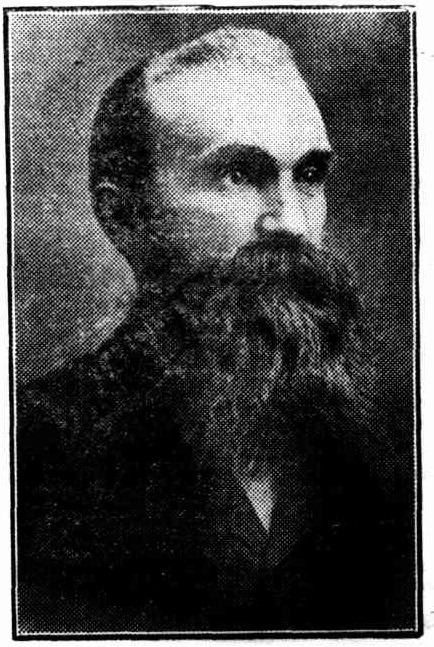 High in the esteem of many of our leading citizens, Mr. Jeremiah Crowley, who died at his residence, Naremburn, on Wednesday week, left an honoured name as an ideal citizen, a true patriot, and a devoted Catholic. Born in Skibbereen, Cork, in the year 1837, Mr. Crowley heard the call of the southern land of Australia, and he came out to Sydney about sixty years ago, and settled in what was then the wild bush around St. Leonards.
High in the esteem of many of our leading citizens, Mr. Jeremiah Crowley, who died at his residence, Naremburn, on Wednesday week, left an honoured name as an ideal citizen, a true patriot, and a devoted Catholic. Born in Skibbereen, Cork, in the year 1837, Mr. Crowley heard the call of the southern land of Australia, and he came out to Sydney about sixty years ago, and settled in what was then the wild bush around St. Leonards.
At that, time the Rev. Father Powell looked after the spiritual requirements of his scattered flock, from Milson's Point to the rugged ranges of the Hawkesbury and farther north. Recognition and appreciation of Mr. Crowley 's work and abilities were soon forthcoming, and we presently find him taking charge of the Catholic school at the corner of Mount-street, St. Leonards, the site now occupied by the School of Arts. He continued to exercise fruitful authority over the school until the old denominational system of education passed away under the Bill brought in by Sir Henry Parkes in 1879. Naturally, through population and material progress, the district had assumed importance, but Mr. Crowley, so well equipped mentally, kept ahead of the times, and when the call was answered by the authorities for the establishment of a public school, Mr. W. Wilkins, who was then directing educational affairs in the colony, pressed Mr. Crowley to take charge of it. This he did, and to this day one frequently hears the St. Leonards School termed "Mr. Crowley's School"—evidence of the deep imprint of his scholarly character upon the young Australian minds entrusted to his wise guidance. He retired from active service in the year 1892, to the great regret of the scholars and their parents.
A student and a gentlemen of high intellectual attainments, Mr. Crowley's erudite pen was consistently championing the cause of justice, and many illuminating articles have from time to time brightened the pages of the "Freeman's Journal." In controversy his polished diction and irrefutable logic were of much value in levelling prejudice which from time to time found play in the events of the day. Well versed in the history of Catholicity in the State, Mr. Crowley published a volume dealing with educational and religious occurrences which won favour and appreciation from the late Cardinal Moran and other leading ecclesiastics. In the promotion of the work of the Church and of Catholic education Mr. Crowley was a generous helper, while in charitable circles his unostentatious deeds stand as a monument to the liberality of a big-hearted Irishman.
"To you," writes the Lord Mayor of Sydney and Speaker of the N.S.W. Legislative Assembly (Mr. R. D. Meagher) to a member of Mr. Crowley's family, "he has left the precious legacy of a good father. To me and others he has left the fragrant memory of a good friend and a good citizen."
For some time he had not enjoyed good health, and he was a patient in the Mater Misericordiæ Hospital, where he was spiritually attended by the Very Rev. Father E. Corish, S.J., Rev. Fathers W. Barry, M. Sherin, Breen, and J. Brennan, S.J. The love of the land of his birth was ever abiding in the heart of Mr. Crowley, and he had set his mind on visiting Dublin and participating in the joyous celebrations which were to welcome freedom for his native land. In this, however, sad disappointment was in store for him, as well as for his kith and kin. The funeral was of a private nature, the remains being interred in the Gore Hill cemetery, where his wife, who had predeceased him nine years ago, had been placed. At the graveside the Rev. Father Sherin officiated, and was assisted by the Rev. Father Breen. A Requiem Mass was celebrated in the church at Naremburn on Friday morning. Deceased leaves two sons (Mr. George Crowley, the well-known managing director of the City Mutual Life Assurance Company of Sydney, and Mr. Michael Crowley) and one daughter (Mrs. J. M. Taylor, wife of the Chairman of the Public Service Board). His grandson, Dr. Robert Taylor, is on active service fighting for the Empire some where abroad.—R.I.P. THE LATE MR. JEREMIAH CROWLEY. (1916, August 31). Freeman's Journal (Sydney, NSW : 1850 - 1932), p. 25. Retrieved from http://nla.gov.au/nla.news-article115592111
Market Firm All Round Real estate sales during the week have returned firm prices for all classes of property. Crowley's Estate. No. 1. Pittwater, an area of 2 acres. £95; REAL ESTATE (1938, May 21). The Daily Telegraph (Sydney, NSW : 1931 - 1954), p. 8. Retrieved from http://nla.gov.au/nla.news-article247251474
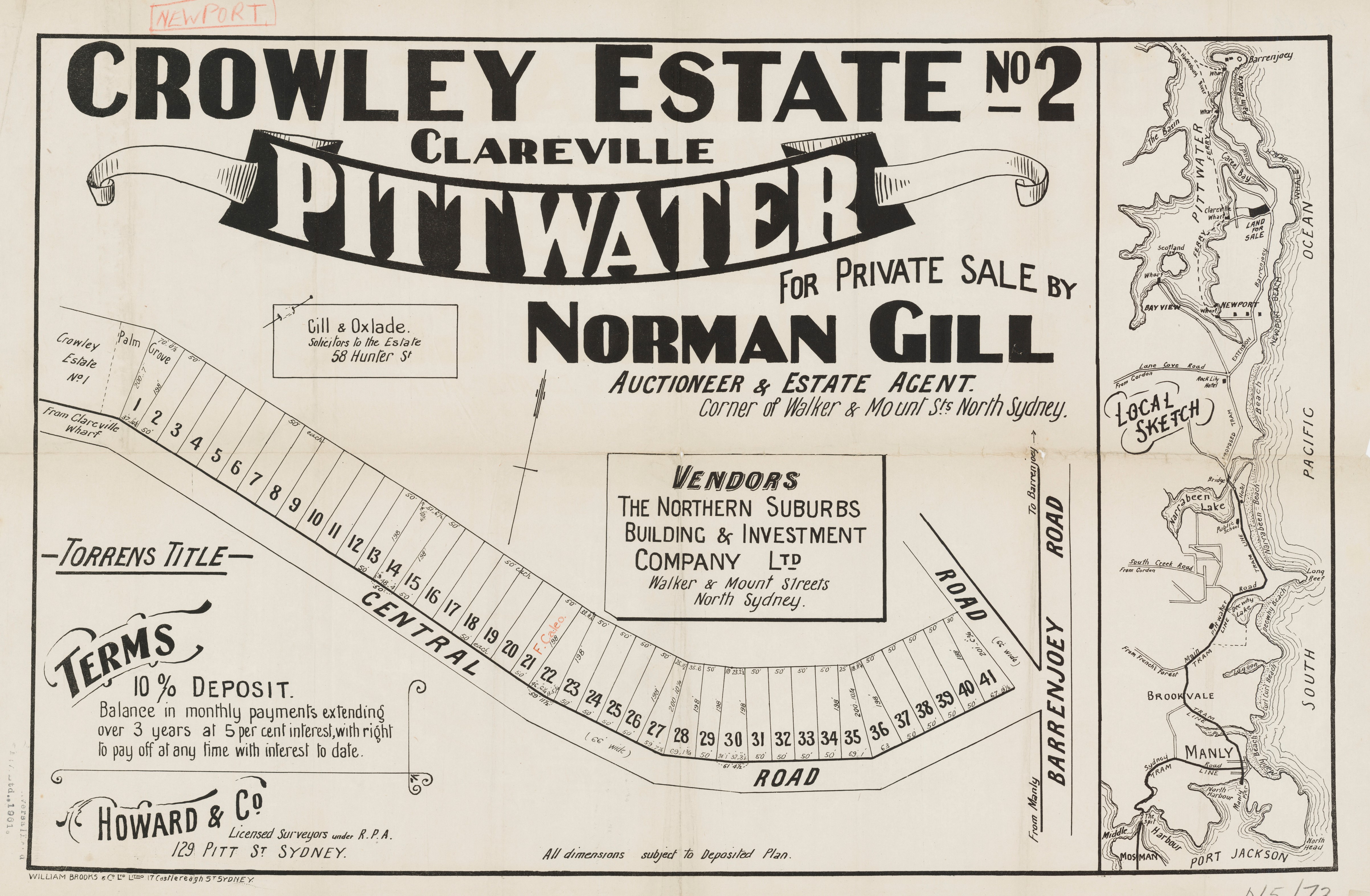
Crowley Estate Subdivision no. 2 - closer to Avalon - Estate 1 can be seen to left of road plan at Clareville end. Item No.: c050400052, courtesy State Library of NSW
In Barnett Smith the threads between Little, Phillips and Cooper families and how or why they owned successive blocks of land across a few interconnections. Mr. Barnett Smith passed away in 1932:
MR. W. BARNETT SMITH.
Mr. William Barnett Smith, Who was town clerk of North Sydney for 35 years, died at his home at Bond-street, Mosman, yesterday, aged 80 years Mr, Smith was born at Canterbury. He began his career as a newspaper pressman. He was editor of the "Mudgee Independent" for several years. He then went Into business, and for a period was, associated with the management of Lonergans, a well-known firm of western storekeepers. Mr. Smith, who was an expert accountant, became town clerk of North Sydney in 1887. He retired 10 years ago He is survived by a grown-up family of three sons and five daughters. There will be a funeral service at St. Luke's, Mosman, at 2 p m. to-day. after which the funeral will leave for St. John's Churchyard, Gordon. Mr. Barnett Smith was one of the first presidents of the Local Government Clerks' Association, which is sitting in conference in Sydney. His death was announced by the president, Mr. W. K. Percival, town clerk of Randwick. The conference passed a vote of sympathy with the family. MR. W. BARNETT SMITH. (1932, October 22). The Sydney Morning Herald (NSW : 1842 - 1954), p. 17. Retrieved from http://nla.gov.au/nla.news-article16924436
Mr. Smith's retirement party has a list of the who's who of North Sydney of then as well as a picture of him. Those early land sales advertisements for the 'the businessman who needs respite' perhaps being coined by businessmen who took respite there, as well as investing inland beside the farmers :
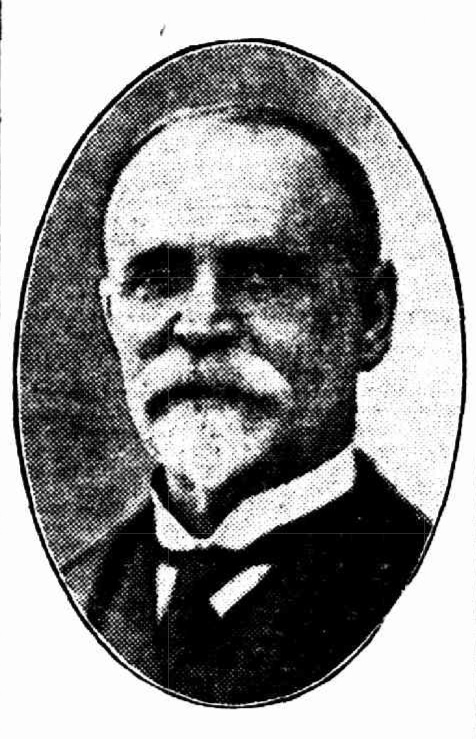 MR. W. BARNETT SMITH
MR. W. BARNETT SMITH
DINNER AND PRESENTATION
The severance of Mr. W. Barnett Smith of his associations with the North Sydney Council as town clerk, where he has officiated for 33 years, was responsible for a large company of representative citizens at a farewell dinner at Sargent's, in George Street, last evening, tendered by the Mayor, aldermen, staff, and ratepayers of North Sydney.
Included in the company were the Mayor and aldermen of North Sydney, ex-Mayor Milson, ex-Mayor W. Anderson, Major-General Sir Granville Ryrie, Sir Thomas Henley, M.L.A., Messrs. A. A. C. Cocks and R. W. D. Weaver, MS.L.A., Colonel Spain, Captain S. G. Green, T. Raine (Raine and Horne), J. Stinson. Ald. R. T. Forsyth (Mayor of Willoughby), ex-Ald. J. Carter, and fully 100 others. The Mayor of North Sydney (Aid. Whatmore), in proposing Mr. Smith's health, referred to his long and faithful service to the people of the municipality, and said that In his retirement the people of North Sydney were losing one of the best town clerks. Messrs. A. Milson and W. Anderson also paid a tribute to the excellent services rendered to North Sydney by the retiring town clerk. The other toasts were "Parliament." "Local Government," and "The Chairman." During the evening the chairman presented Mr. Smith with a wallet of notes and an illuminated address on behalf of the Mayor, aldermen, staff, and ratepayers of North Sydney. Mr. Smith made a suitable acknowledgement. MR. W. BARNETT SMITH (1921, September 1). The Daily Telegraph (Sydney, NSW : 1883 - 1930), p. 6. Retrieved from http://nla.gov.au/nla.news-article239711097
One of the Mayors of North Sydney during Mr. Barnett Smith's tenure there was Gerard Phillips. He too was a successful land agent - was proctor for Martha Powell, widow of William Powell, Builder of Waterloo who also served on that Council, as did his son later on, prior to his death in 1877.
Gerard Phillips was the official who oversaw the electoral process for Woollahra in 1860, and as a manager and agent for the Waterloo Company, Mr. Phillips’s fortunes were tied to those of the Cooper family, owners of the largest single landholding within the newly formed municipality.
From his Obituary:
DEATH OF MR. GERARD PHILLIPS.
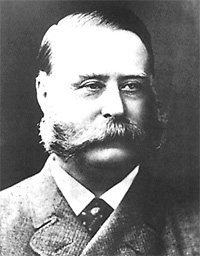 Mr. Gerard Phillips, Mayor of North Sydney, died very suddenly last Tuesday night at his residence, Redlands, Military-road, North Sydney. For some time past Mr. Phillips had been suffering from bronchitis and an affection of the throat; but he was sufficiently well to be able to attend the meeting of the North Sydney council. He occupied the mayoral chair on Tuesday night at the regular meeting at the council chambers.... adjourned, after 9 o'clock, he went home. He was then, apparently, in better health and spirits than usual. ' On reaching borne a few minutes before 10 o'clock, he was almost immediately seized with a fit of coughing, which lasted for a short time. During the fit a jugular vein in his neck burst;, and in a few minutes he aspired. The seizure and its results were so sudden that Dr. Baldwin, who had been summoned, had not yet arrived when death ensued.
Mr. Gerard Phillips, Mayor of North Sydney, died very suddenly last Tuesday night at his residence, Redlands, Military-road, North Sydney. For some time past Mr. Phillips had been suffering from bronchitis and an affection of the throat; but he was sufficiently well to be able to attend the meeting of the North Sydney council. He occupied the mayoral chair on Tuesday night at the regular meeting at the council chambers.... adjourned, after 9 o'clock, he went home. He was then, apparently, in better health and spirits than usual. ' On reaching borne a few minutes before 10 o'clock, he was almost immediately seized with a fit of coughing, which lasted for a short time. During the fit a jugular vein in his neck burst;, and in a few minutes he aspired. The seizure and its results were so sudden that Dr. Baldwin, who had been summoned, had not yet arrived when death ensued.
The late Mr Phillips was connected with municipal affairs for a considerable time, and was chosen Mayor of North Sydney in succession to Mr. Frank Punch at the election in February' last. He was a native of the West of England, and came to Sydney about 40 years ago.
He was for many years manager of the Sir Daniel Cooper affairs, taking the position in 1854, and at the time of his decease was agent for the estate of Mr. John Cooper, North Sydney (Thrapp's grant). Besides conducting an extensive land agency business, Mr. Phillips held at various times several offices of trust. He was Secretory for the South Head-road Trust. The deceased gentleman was an earnest Catholic, and up to about ten years back was identified with the various Catholic movements in the city, including the erection of St. Mary's Cathedral and St. Vincent's Hospital. For some years past his interest in Catholic affairs was confined to the district of North Sydney, and it will be recollected that he assisted the Jesuit Fathers at the opening of the new school-church near Mossman's Bay. He leaves a widow and large family but it is generally understood that they are well provided for, as the deceased was a keen and successful business man. Two sisters survive him in New South Wales— Mother De Sales, of the Sisters of Charity, St. Vincents Convent, Victoria street, and Mrs. Colley, of Parramatta, who lost her husband only a few weeks since. Mr. Phillips was 63 years of age. DEATH OF MR. GERARD PHILLIPS. (1892, May 21). Freeman's Journal (Sydney, NSW : 1850 - 1932), p. 14. Retrieved from http://nla.gov.au/nla.news-article111324649
There's more family threads under Extras and more that unfold through the first subdivision.
The name 'Claraville', lots 8 and 9, (section 2) of portion 20, Geoff Searl, President of the Avalon Beach Historical society can shed some light on in yet another thread of the name change from Long Beach and landowners names being applied to the coves/beaches, to Clareville as well as the pier Therry built at Careel Bay:
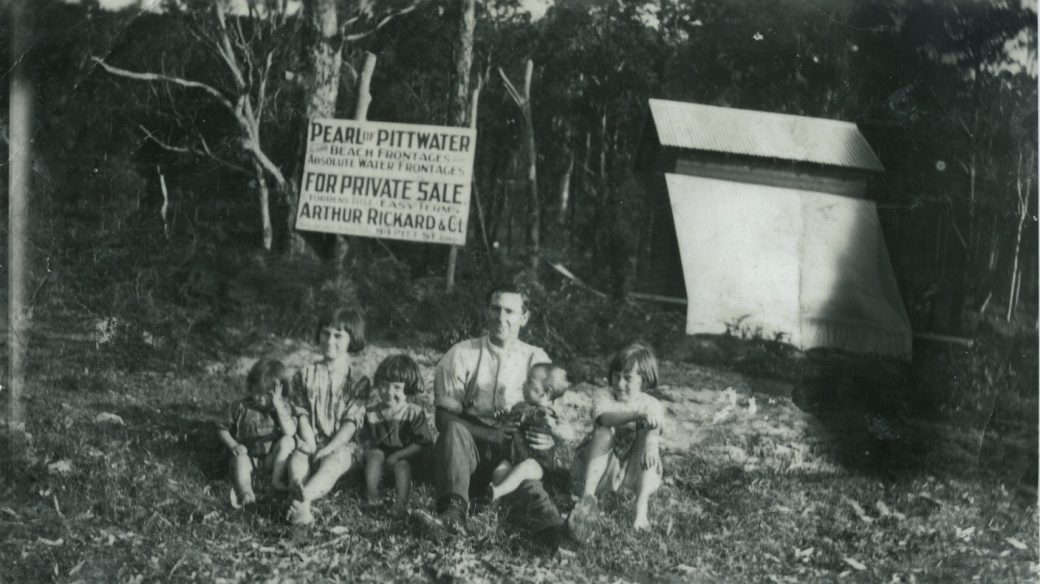
This photo taken in 1923 shows Alan Hay with his daughter Irene on his lap. Alan had married Clara Dorothy Collier in 1919. His other daughter Evelyn sits between the two Butcher children and her dad. The girl on the right was a friend from the dairy at Careel Bay. Note the lean-to against the early building which eventually became “Clare Villa”. Clara’s dad James purchased the first block of land on Clareville Beach. ABHS photo.
The name 'Clareville' for Avalon persists even in the notices of a gentleman whose land ownership in the area was definitely on the ocean side of this valley - more on this gentleman, Mr. Horning, when we get to the Avalon Beach (Roads Have Your Name) page and that one Mr. A. J. Small Esq.! who was behind the name change for one part of what was once Clareville and would be, soon, Avalon:
HORNING - Suddenly (23rd instant), at Risingholme, Pittwater, Frederick Arnold, youngest surviving son of the late William Horning, of Sydney, and Mrs. Henry Allan, Kelvin, Ridge street, North Sydney. Family Notices (1912, January 26). The Sydney Morning Herald(NSW : 1842 - 1954), , p. 6. Retrieved from http://nla.gov.au/nla.news-article15305288
PITTWATER.
By Order of the Trustees in the Deceased Estate of Frederick Arnold Horning on the Property known as Risingholme Clareville via Newport
SATURDAY 3rd FEBRUARY AT 2.3O SHARP
Motor Launch will leave Newport day of Sale at ...
UNRESERVED SALE
Of all Stock Plant, and Building Material on the Property Comprising -
Powerful heavy Grey Heavy Draught horse 7 years Tip Dray and Harness Hogskin Saddle and Bridle 2 well bred Jersey Cows in full milk Roan Bull (selected for breeding and soundness)
Plough Scantier Harness Sundry Farming Implements about 2 tons Lucerne Hay Quantity of
Bran Chaff and Pollard.
Full Set Carpenter's Tools.
Highest Grade Building Material for a 4-roomed cottage (just landed for erection) comprising Galvanised Iron Hardwood flooring and Weatherboards Fibro Cement Sheets Doors and Window Sashes Bolts, Nails, and Screws 2 G L Tanks 800 and 1000 gallons *
Sundry Household Furniture and Kitchen Utensils Incubator Grindstone Fodder Cases tin lined etc.
DJ MCINTYRE and CO Auctioneers, "0 Castlereagh street, city have been instructed by the
Trustees of the Estate of Frederick Arnold Horning (deceased) to hold an Unreserved Auction
Sale of the whole of the Personal Estate on the Property
AS ABOVE. TERMS CASH
The auctioneers can personally vouch for the absolutely genuine character of this Sale the Plant, Holding Materials Tools etc. having only been purchased a month or two and must be cleared off the land
The Property known as "Risingholme " Clareville via Newport comprising 101 acres, the pick of the whole district for soil aid beauty- of situation will also be offered by Auction on the Ground prior to Sale of Effects.
See Property Auction Advts.
THE KOHINOOR* OF PITTWATER.
Practically "The Gem of the Pacific/ Ocean.
On the Property known as "RISINGHOLME” Clareville, via Newport
SATURDAY 3rd FEBRUARY, at 2.30 sharp. Motor Launch win leave Newport day of Sale at 1.45 pm. ,
101 ACRES THE PICK of the whole district for soil and beauty of situation. An old identity states that nothing in the district can be compared with it for subdivision purposes or as an ideal
MARINE HOME
DJ M INTYRE and CO Auctioneers ...have been instructed by the Trustees of Frederick Arnold Horning deceased to
Wd an Auction Sale on the Ground of the above described Valuable Property. Advertising (1912, January 26). The Sydney Morning Herald (NSW : 1842 - 1954), , p. 11. Retrieved from http://nla.gov.au/nla.news-article15305262
The name as Clareville referring to what we now call Avalon Beach is also present in the first subdivision Arthur Jabez Small, who later coined the name 'Avalon', brought to the market. Mr. Small is listed as bringing more land under the Real Property Act in 1914. He too utilises the proximity and existence of a wharf at Clareville as a means to access the estate:
Newport- Pittwater.
SANDY BEACH FRONTAGES, in the SHELTERED WATERS of PITTWATER HARBOR, opposite SCOTLAND ISLAND, and only 12 MINUTES WALK of the OCEAN BEACHES.
The Clareville Beach Estate.
Adjoining the CLAREVILLE PUBLIC WHARF, and embracing 1
ABSOLUTE BEACH and WATER FRONTAGES, and CAMPERS' SITES, Overlooking the Beach.
TITLE WILL BE TORRENS. NOTE THE TERMS: £2 and £5 per Lot Deposit, balance by quarterly payment extending over 5 years. Interest 5 per cent.
FREE LAUNCHES from BAYYIEW and NEWPORT JETTIES all day of Sale. LIGHT REFRESHMENTS ON THE GROUND.
Lithographs obtainable from the Auctioneers and Local Agent.
INTENDING PURCHASERS ate requested to take TRAM to NARRABEEN, then MOTOR 'BUSES to NEWPORT or BAY VIEW, and catch the FREE LAUNCHES from both these places on day of sale, and attend the Sale of CLAREVILLE BEACH ESTATE, IN PITTWATER HARBOR.
AUCTION SALE, ON THE GROUND, S O'CLOCK,
Anniversary Day, January 26.
RICHARDSON AND WRENCH, LTD., AUCTIONEERS.
— J. WILLIAMS, Bayview, Pittwater, Local Agent. Advertising (1914, January 11). The Sun (Sydney, NSW : 1910 - 1954), p. 9 (SUNDAY EDITION). Retrieved from http://nla.gov.au/nla.news-article221563893
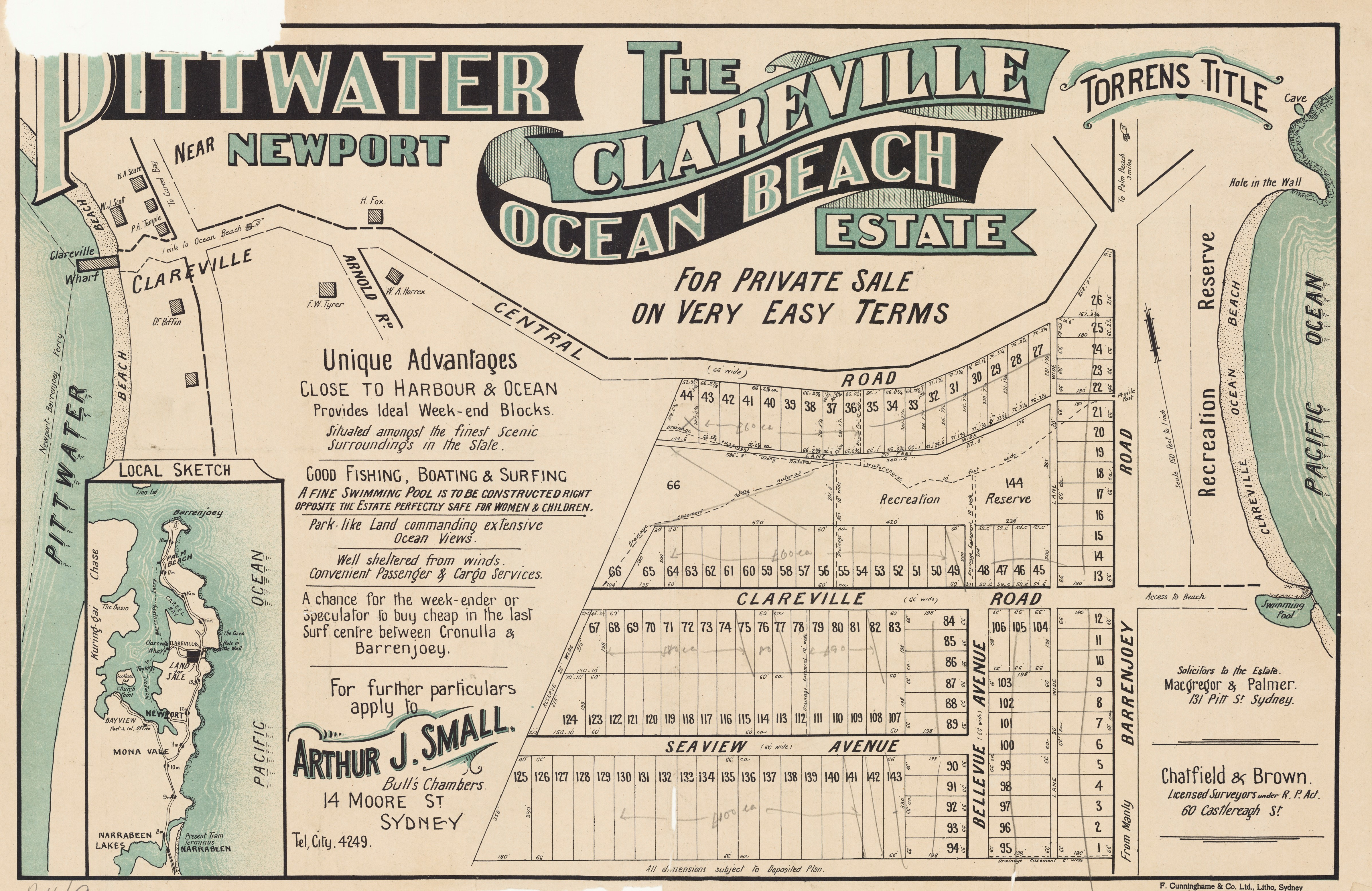
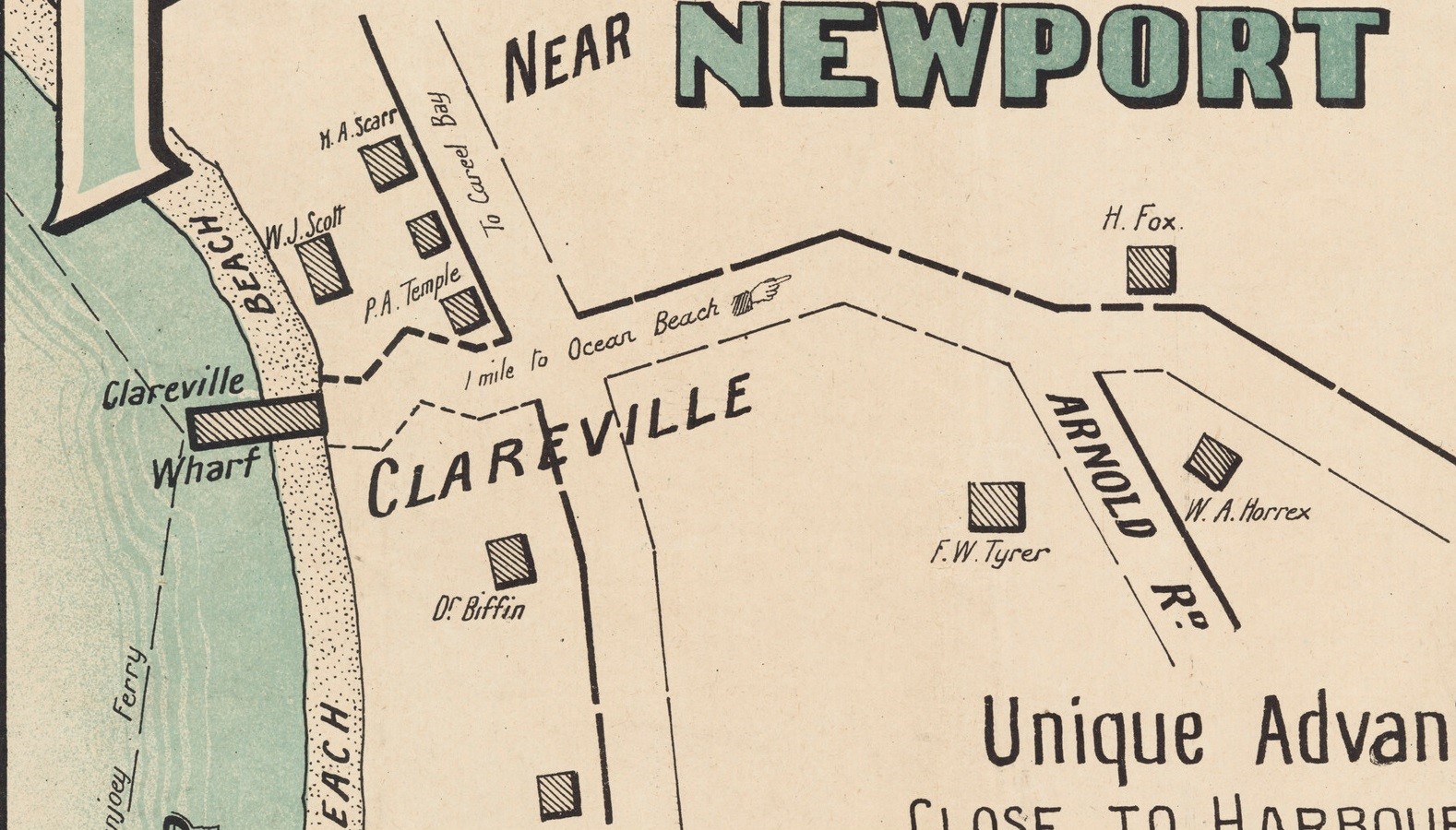
%20for%20Clareville%20page%20showing%20name%20for%20ocean%20beach.jpg?timestamp=1554254107807)
Pittwater Clareville Ocean Beach Estate - Central Rd, Barrenjoey roads - A J Small. Item No.: c027560009 [Avalon subdivision plans] - courtesy State Library of New South Wales. And sections from to show residences and name for Avalon Beach.
Mr. Arthur J. Small, of Royston Park, Asquith, takes exception to the statement last week that Palm Beach Estate, Barrenjoey where land brought £4 per foot, ls Inaccessible to the public, and practically can only be reached as a residential area by persons owning their own car. He draws attention to the fact that there is an hourly service of motor cars from the present tram terminus at Narrabeen to Newport, and a regular ferry service thence to Clareville and Palm Beach of two trips each way daily. This service was Inaugurated by the Palm Beach Co. when they first opened up the estate some five or six years ago. REAL ESTATE. NOTES OF THE WEEK. (1917, March 31). The Sydney Morning Herald (NSW : 1842 - 1954), p. 11. Retrieved from http://nla.gov.au/nla.news-article28101228

.jpg?timestamp=1592011477712)
.jpg?timestamp=1592011520170)
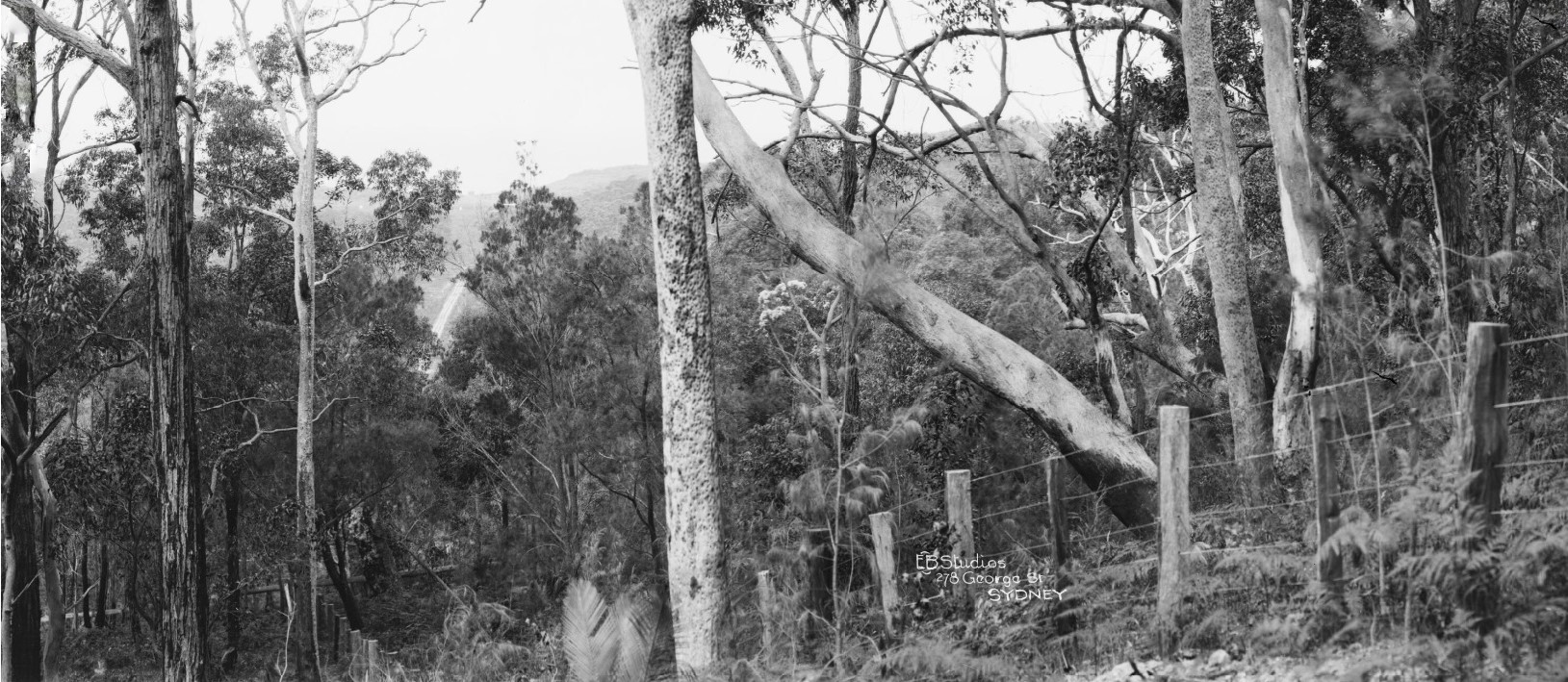
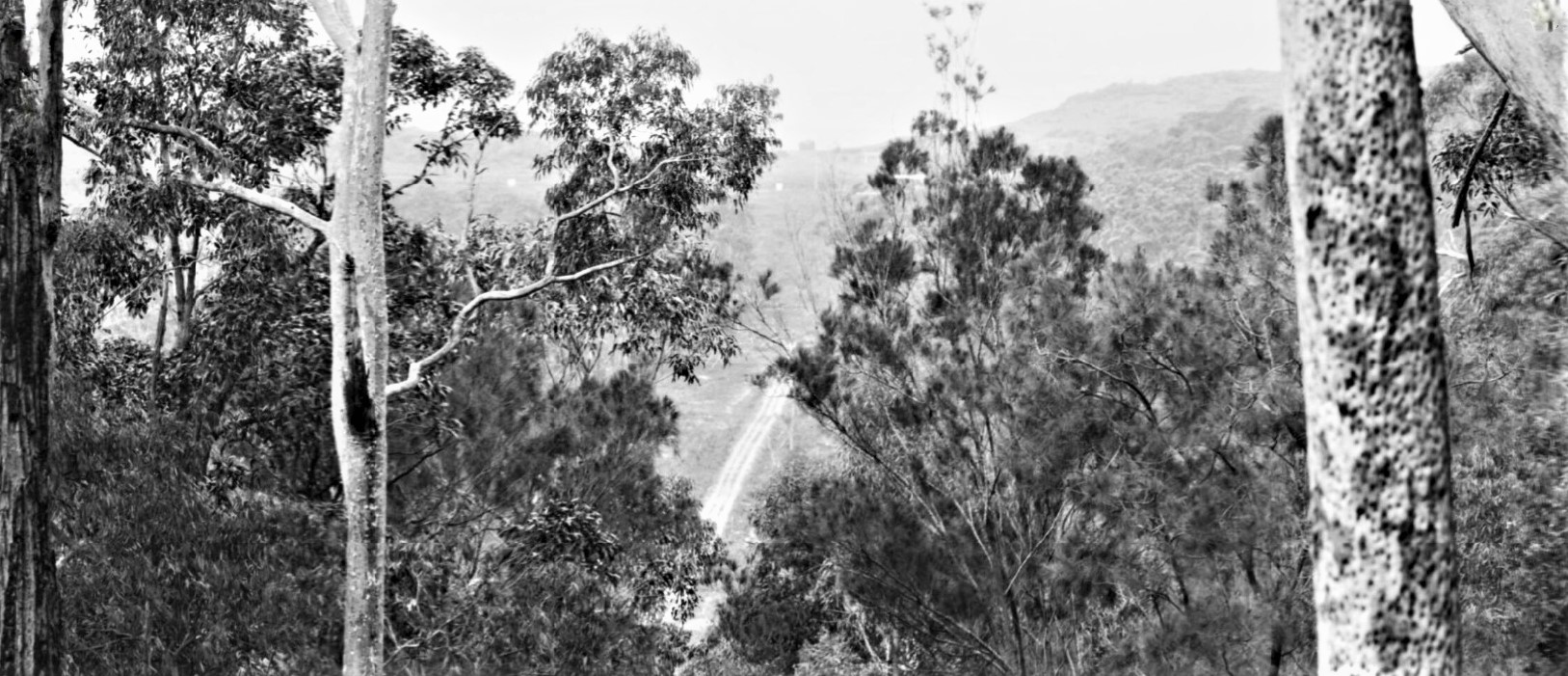
Above: 'Clareville Road' - which will become 'Avalon Parade' in late 1921 per A J Small
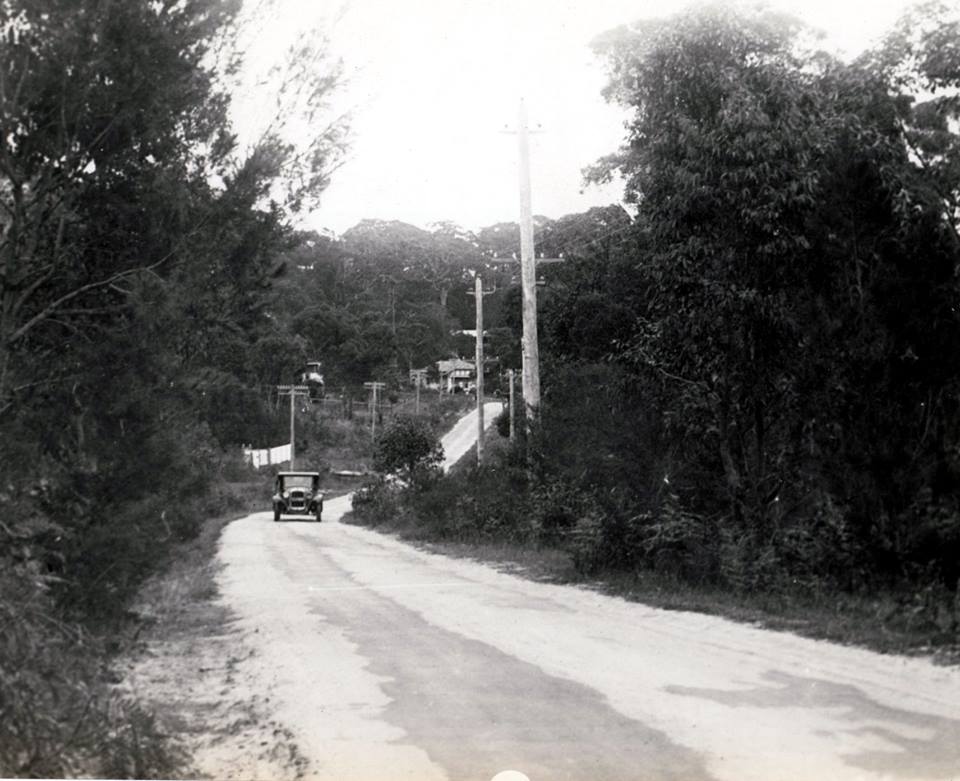
'Clareville Road, Pittwater between 1922/1925 and 1930'. My great grandfather's photo Albert Henry Grace. Image shared on local Facebook History pages by and courtesy Helen Grant. This was soon to be renamed 'Avalon Parade' the name is is still now called. Helen's great grandparents bought land and built a place they called 'Gunjulla' - the home is still intact and gave its name to 'Gunjulla Place' off Avalon Parade towards the Clareville end.
The shift from rural idyll and green aquatic country resort of much 'brightness' to suburbia on the old Clareville side of Pittwater occurred when Sections (Lots) 5 to 8 of portion 20 were brought under the Real Property Act in 1914 by Henry Little and his sister and younger brother:
NOTICE UNDER REAL PROPERTY ACT.
APPLICATIONS having been made to bring the lands hereunder described under the provisions of the Real Property Act, Certificates of Indefeasible Title will issue, unless Caveats be lodged in accordance with the Third Schedule to the said Act on or before the 1st July, 1911: —
No. 18.843. APPLICANTS:—Louisa Little, Wallendbeen, Henry John Little, and William Augustus Little, both Sydney. LAND:—County Cumberland, parish Narrabeen, shire Warringah, 27 acres 3 perches, at Pittwater.—lots 5, 6, 7, and 8, villa sites, in the Pittwater Estate, and part 1200 acres (portion 20, parish), granted to John Joseph Therry; adjoining properties of P. A. Temple, A. Robinson, W. Robinson. J. D. Fletcher, J. Smith, and J. Gregg.
Diagrams delineating these lands may be inspected at the Land Titles Office, Sydney.
H. R. COLBORNE,
Acting Registrar-General.
27th, May, 1914.
NOTICE UNDER REAL PROPERTY ACT. (1914, May 27). Government Gazette of the State of New South Wales (Sydney, NSW : 1901 - 2001), p. 3104. Retrieved from http://nla.gov.au/nla.news-article226768146
Henry John Little was Managing Director of Richardson and Wrench and worked as an Auctioneer, as did William Augustus. They started out as having their own firm. Louisa is their widowed mother. Her name before she married was 'Phillips. The names Louisa Little, William Augustus J Phillips (relative on their mother's side) and William Augustus Little occur frequently in the buying of land and taking over of mortgages in Sydney and in rural areas during those decades - big amounts of acreage is involved. They also had land at Bayview from the early 1900's late 1890s too - more threads on this run under extras.
Richardson and Wrench were involved in sales of the Therry land grants, past those earliest 1871 to 1880 ones, from at least 1887 - subdivisions plans, one then marked with the names of the earlier buyers, and some records of these lands changing hands, run further down this page - the 1887 R&W sales were advertised and then reported as:
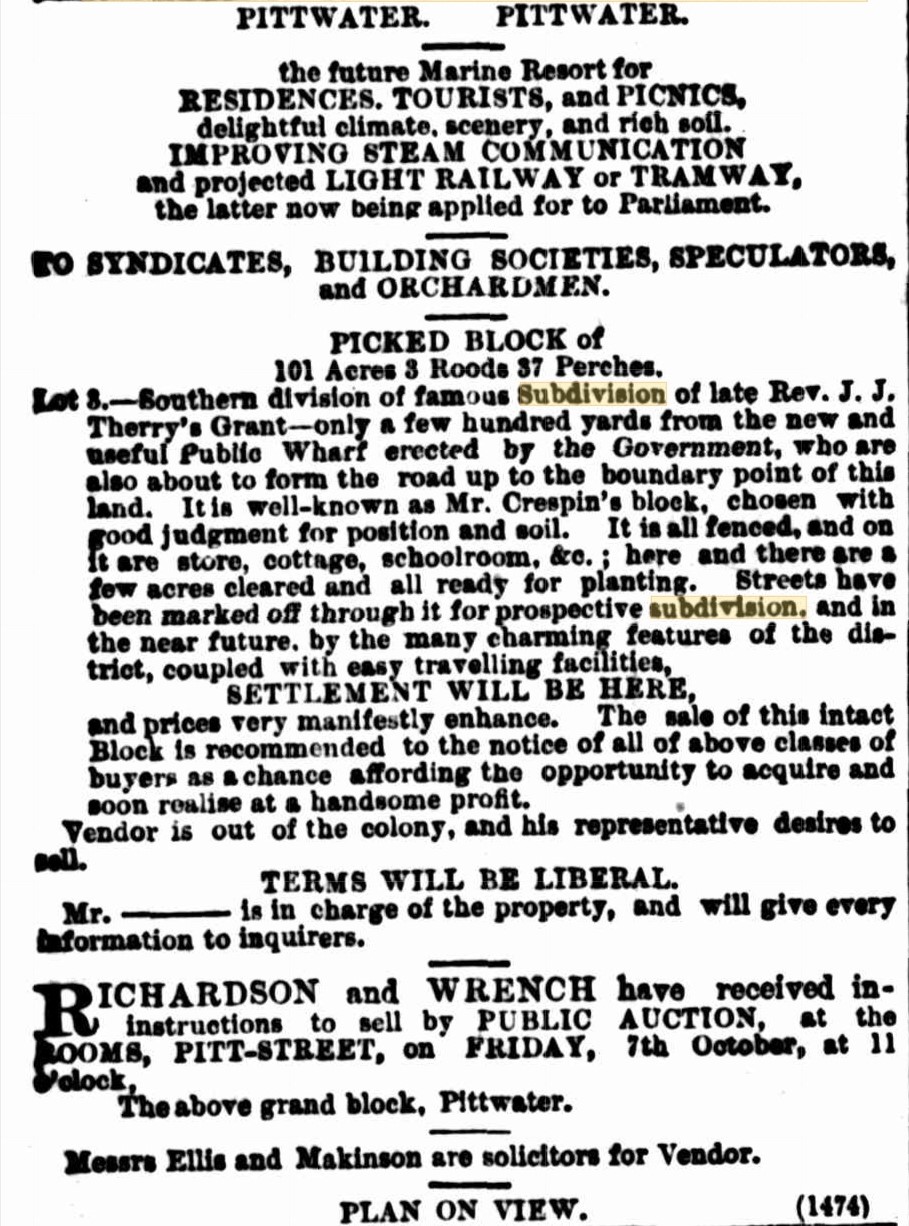
Advertising (1887, October 1). The Sydney Morning Herald (NSW : 1842 - 1954), p. 18. Retrieved from http://nla.gov.au/nla.news-article28348853
Richardson and Wrench report having told by auction and private contract, during the week, the following properties ...7 blocks of the Pittwater Estate (Father Therry's), at prices ranging from £4 17s 6d to £21 per acre; 8 allotments In the village of Brighton, Pittwater Estate, for £12; block of land, Stoke's Point, Pittwater, In area 3 acres and 38 perches, for the sum of £7 per acre-... PROPERTY SALES. (1887, October 8). The Sydney Morning Herald (NSW : 1842 - 1954), p. 16. Retrieved from http://nla.gov.au/nla.news-article13662798
Later that year, 1914, the Little's land described above was advertised for sale with Hilltop Road already named and Hudson Parade called 'Beach Parade'. This also marks when 'Clareville Beach' is applied as a name to the estuarine sandy stretch we know by the same name now. The beach we call 'Avalon' was known from at least 1912 after landowner Frederick Burne, as 'Burne's Beach' while the wharf at Careel Bay was called 'Careel Bay Wharf' in advertisements for land sales from the same year.
Clareville Beach Estate, Newport-Pittwater - Beach Pde, Hilltop Rd, Central Rd, 1914
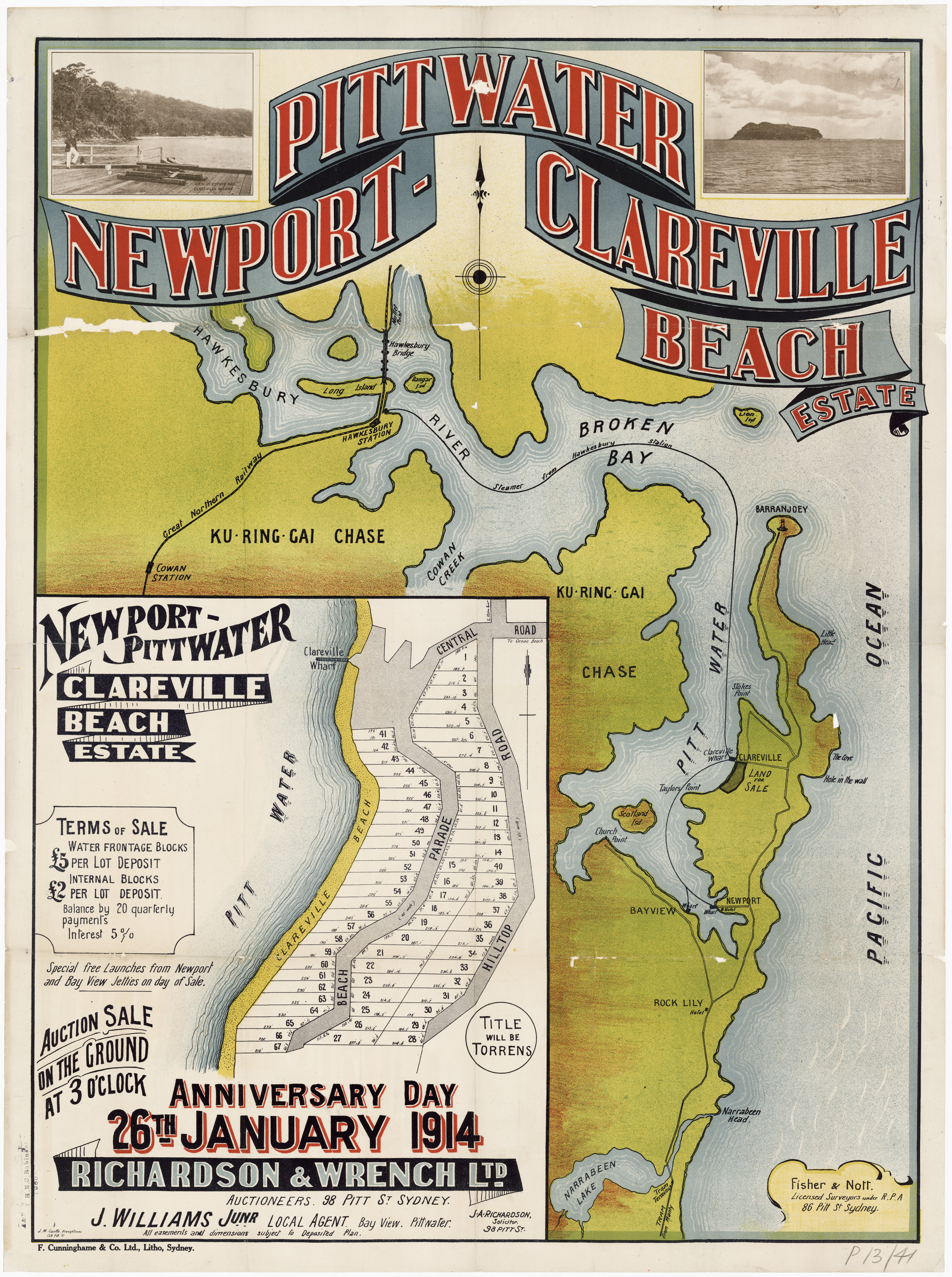
.jpg?timestamp=1553714661290)
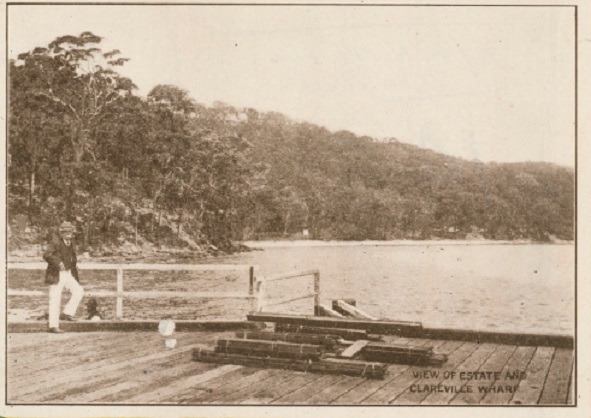
Two different spellings persist in precursors; this advertorial in a similar form first appears in newspapers on December 28th, 1913:
Messrs. Richardson and Wrench the auctioneers. The same firm will also conduct a sale on the holiday at Newport, Pittwater, where there are sandy beach frontages in the sheltered waters of Pittwater Harbour, opposite Scotland Island, and only 12 minutes walk of the ocean benches. The estate to be offered is the Clareville Beach subdivision, which adjoins the local public wharf, and embraces absolute-beach and water frontages, between Taylor's Point and Clareville wharf; also campers' sites, overlooking the beach. Free launches will run from Bay View and Newport jetties on the day of the sale, and persons wishing to inspect the land on Saturday can go by launch from the Hawkesbury River Railway station on arrival of the morning train from Sydney, returning from Clareville in the evening. HOLIDAY AUCTIONS. (1914, January 24). The Sydney Morning Herald (NSW : 1842 - 1954), p. 8. Retrieved from http://nla.gov.au/nla.news-article28120916
Messrs. Richardson and Wrench, Ltd., have two important sales in hand, at Balmoral and the Clairville Estate, which, faces Pittwater Harbor. The Balmoral preposition consists of 60 lots in Murphy's Estate, quite close to this popular .beach, and commanding exquisite views of Middle Harbor. Since the Minister for Works has promised to put the Balmoral tram, proposal on his list for immediate attention,, the value of these blocks for residential or investment purposes has improved considerably, but even without such added inducement their admirable situation ensures a brisk demand. The Claireville Estate supplies the opportunity for those looking for cheaper blocks on an equally: attractive beach. Messrs. Richardson and Wrench have made arrangements to cater for their clients at this sale, and motor-launches will meet the motor-cars from Narrabeen at Newport and Bay View and from the Hawkesbury River railway station on the day of sale.
On the opposite side of this narrow neck of land, which is on the road to Barrenjoey, Messrs. Stanton and Son, Ltd., will, about the same time, cater for investors who desire to acquire blocks in the Careel Ocean Beach Estate, which is situated near the Hole in the Wall.
This firm, too, will run free motor-launches to meet the down motor-cars and the train at Hawkesbury from Sydney. Both propositions have considerable future values, and, judging from inquiries which the auctioneers have received, there will be a good attendance of buyers for -blocks in both estates. ACRES AND LOTS. (1914, January 25). Sunday Times (Sydney, NSW : 1895 - 1930), p. 4. Retrieved from http://nla.gov.au/nla.news-article120363861

Clareville wharf Pittwater near Avalon Beach - Small steam passenger vessel ( The Phoenix) coming in by Rex Hazlewood from album 'photos of Avalon Clareville and Palm Beach', circa 1920 Image No.: c046220013h, courtesy State Library of NSW
Subdivision of Taylor's Point, Pittwater - Hudson Parade, Clareville, 1921
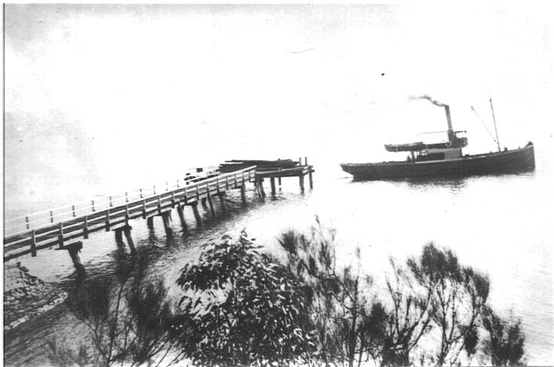 The next subdivision came through Mr. Hudson selling some of his land holdings. His name now applies to a section of what was 'Beach Parade' during the first land sales and named as 'Clareville Beach Parade' in the accompanying brochures for the sale. This ran straight on from what was called then, as now, 'Avalon Parade'. There is also now a 'Wandeen' Road.
The next subdivision came through Mr. Hudson selling some of his land holdings. His name now applies to a section of what was 'Beach Parade' during the first land sales and named as 'Clareville Beach Parade' in the accompanying brochures for the sale. This ran straight on from what was called then, as now, 'Avalon Parade'. There is also now a 'Wandeen' Road.
'Wandeen' is used for a name for dinghies on the harbour from the late 1890's. It has been used for the names for houses, for horses, for places, for avenues elsewhere prior to appearing at Clareville. It appears in South Australia as a name for Mount Lofty.
Those who have used it as a name for their child, boy or girl, hold that is has a meaning of 'Optimistic, Peacemaker, Cheerful'.
When used as a name for a home it would be situated up high. A little of Mount Lofty as an elevation, as much as a cheerful outlook from this tree top wended way up that hill would apply in this instance.
Louisa Little of Wallendbeen, widow, Henry John Little and William Augustus Little both auctioneers, whose land was subdivided first, may have had some influence here too. In 1904 three members of one family purchased three portions of land at Wandeen Avenue, Beecroft. The name of the street takes its name from the original home of “Wandeen Cottage”.
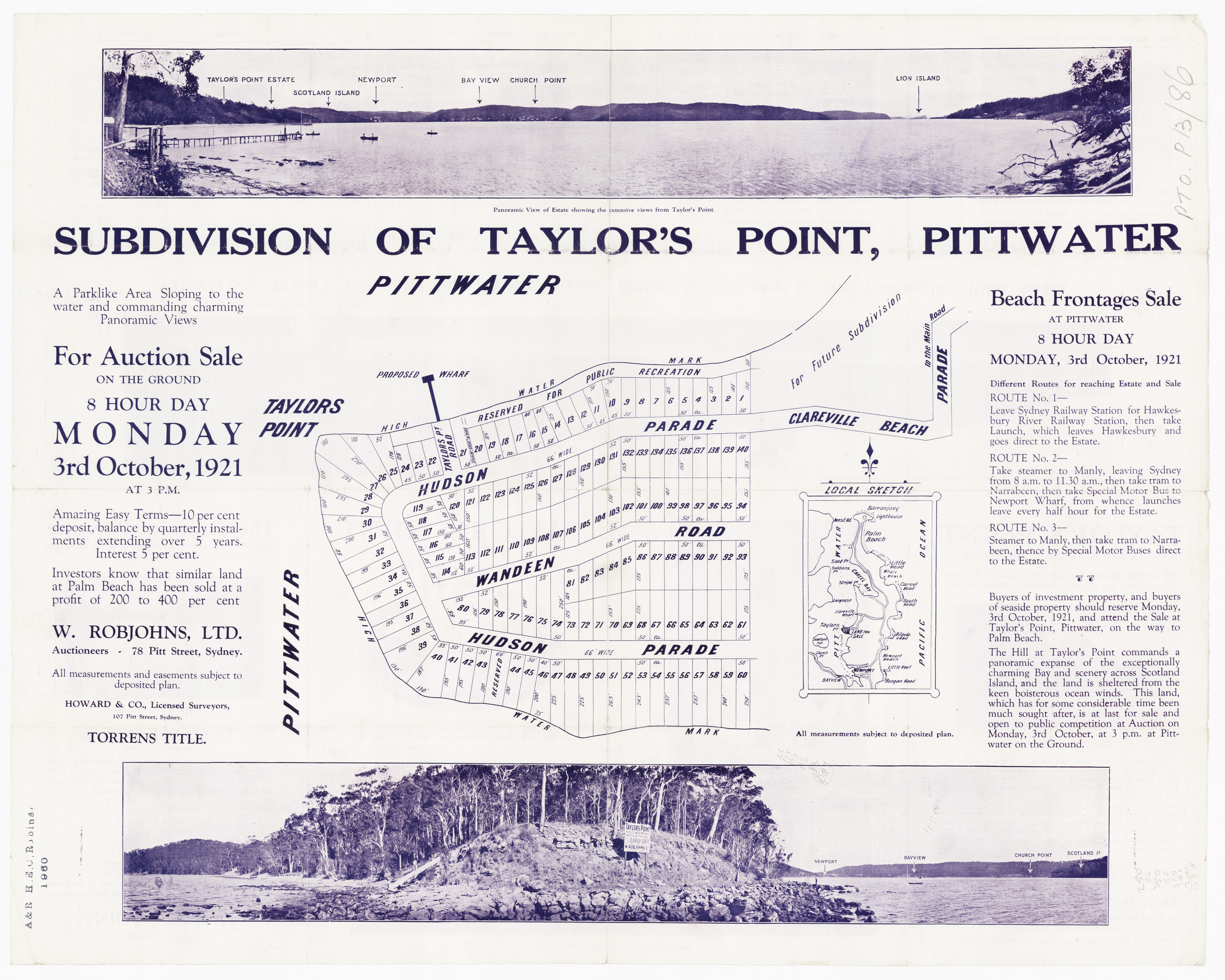

'Panorama of Taylors Point with real estate sign advertising upcoming land subdivision', Pittwater, New South Wales, Circa 1917-1920, courtesy National Library of Australia., Image No.: nla.pic-vn6149436 - Part of Enemark collection of panoramic photographs [picture] [1917-1946]
Below: zoomed in sections from above panorama - which show the beach area to an old boatshed and jetty and the SS Erringhi coming up the Pittwater Estuary. You can explore many of these Enemark Panoramas in the National Library of Australia's Online collection - these all have a 'zoom' in feature where you can see the small details of Pittwater - our research indicates they were photographed between 1917 and 1921 - as the Clareville and Taylors Point wharf and jetty were built or replaced during this period - simply go to the NLA website and enter into the Search box 'Pittwater' and choose 'picture' under add limits dropdown box - click on the Panos that pop up and you will see a 'zoom' function - enter 1200x1200 and have an explore - wonderful stuff - visit here
This 'Taylors Point' sale sign is from 1921:
CALL FOR CONCESSION MOTOR AND LAUNCH TICKETS FOR THE SALE AT TAYLORS POINT. THE GEM OF PITTWATER
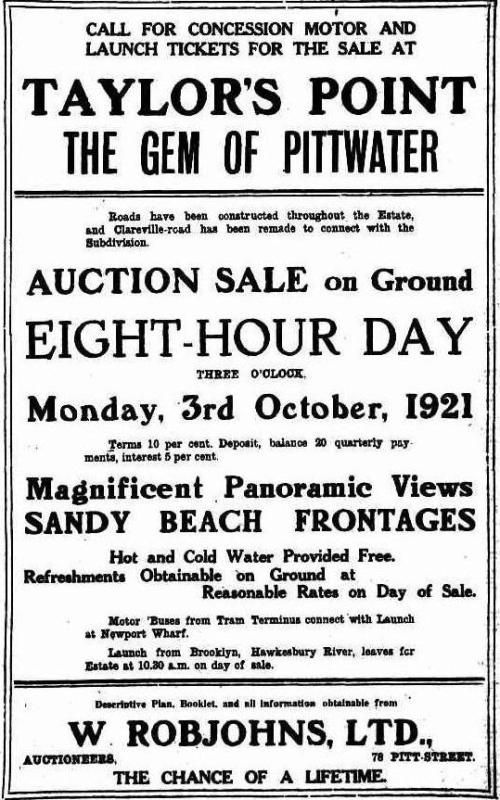
Roads have been constructed throughout the Estate, and Clareville-road has been remade to connect with the Subdivision. AUCTION SALE on Ground EIGHT-HOUR DAY THREE O'CLOCK, Monday, 3rd October, 1921. Terms 10 per cent. Deposit, balance 20 quarterly payments, interest 5 per cent. Magnificent Panoramic Views SANDY BEACH FRONTAGES. Hot and Cold Water Provided Free. Refreshments Obtainable on Ground at Reasonable Rates on Day of Sale. Motor 'Buses from Tram Terminus connect "with Launch at Newport Wharf. Launch from Brooklyn, Hawkesbury River, leaves for Estate at 10.30 a.m. on day of sale. Descriptive Plan. Booklet, and all information obtainable from W ROBJOHNS, LTD., AUCTIONEERS, 78 PITT-STREET. THE CHANCE OF A LIFETIME. Advertising. (1921, September 24). The Sydney Morning Herald (NSW : 1842 - 1954), p. 11. Retrieved from http://nla.gov.au/nla.news-article15989853
Another - with pictures!
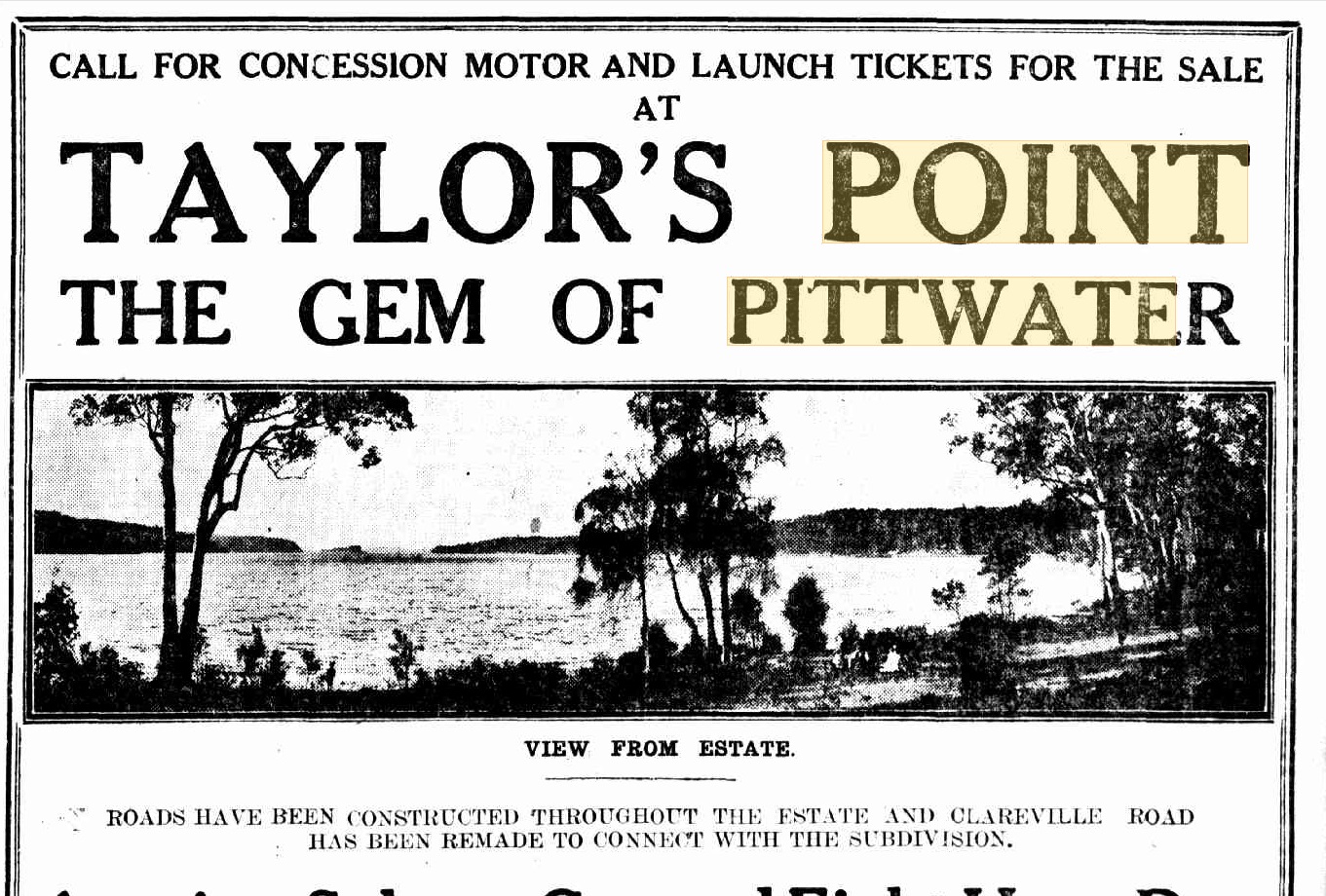
.jpg?timestamp=1553828403166)
.jpg?timestamp=1553828154323)
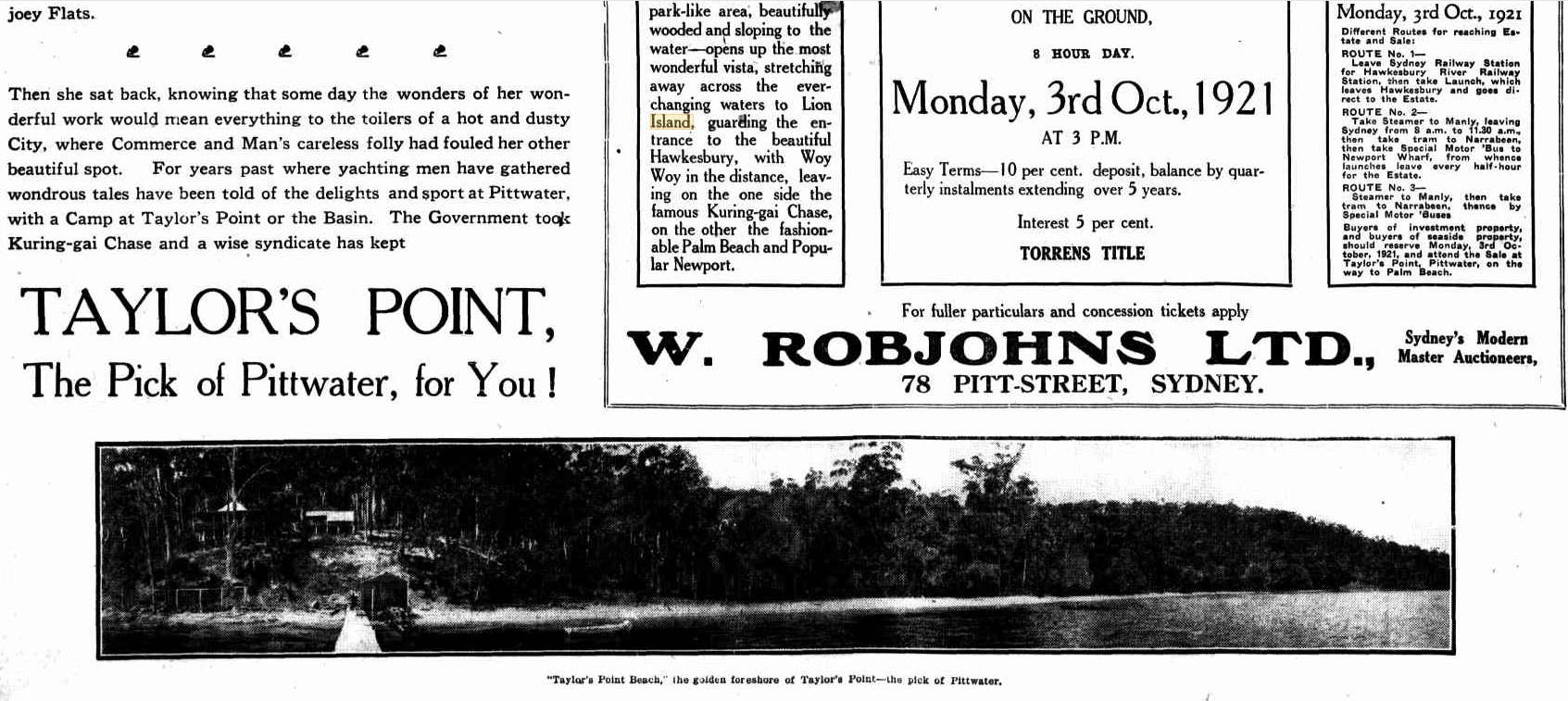
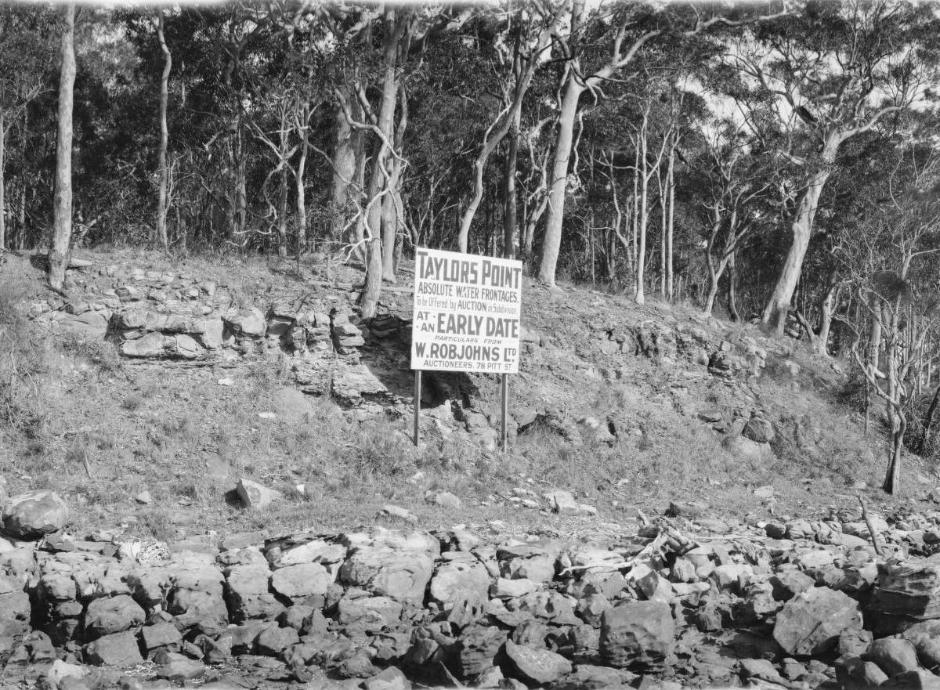
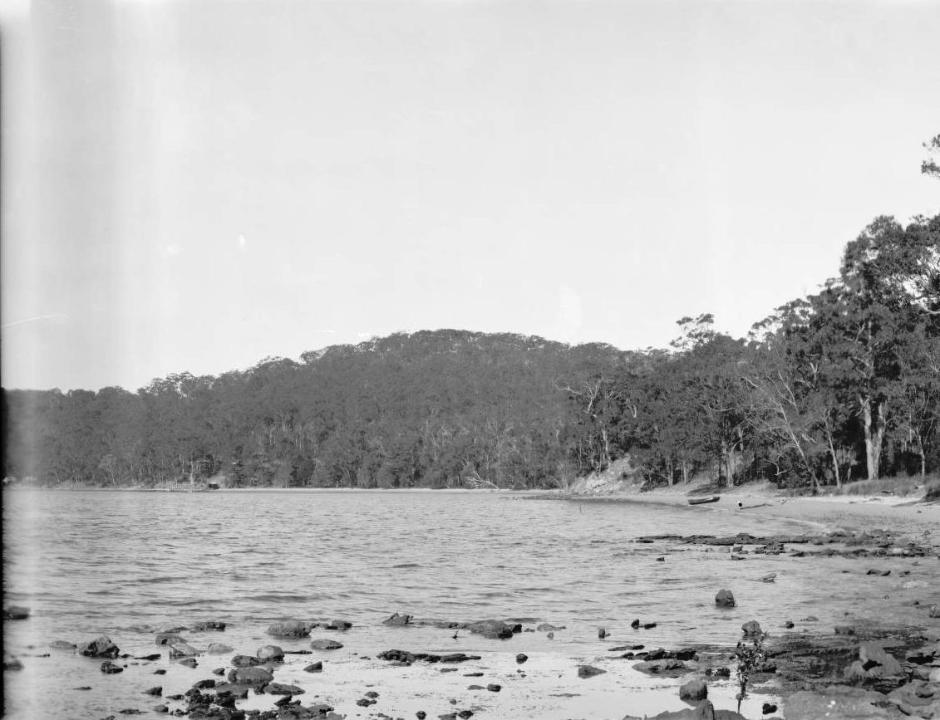
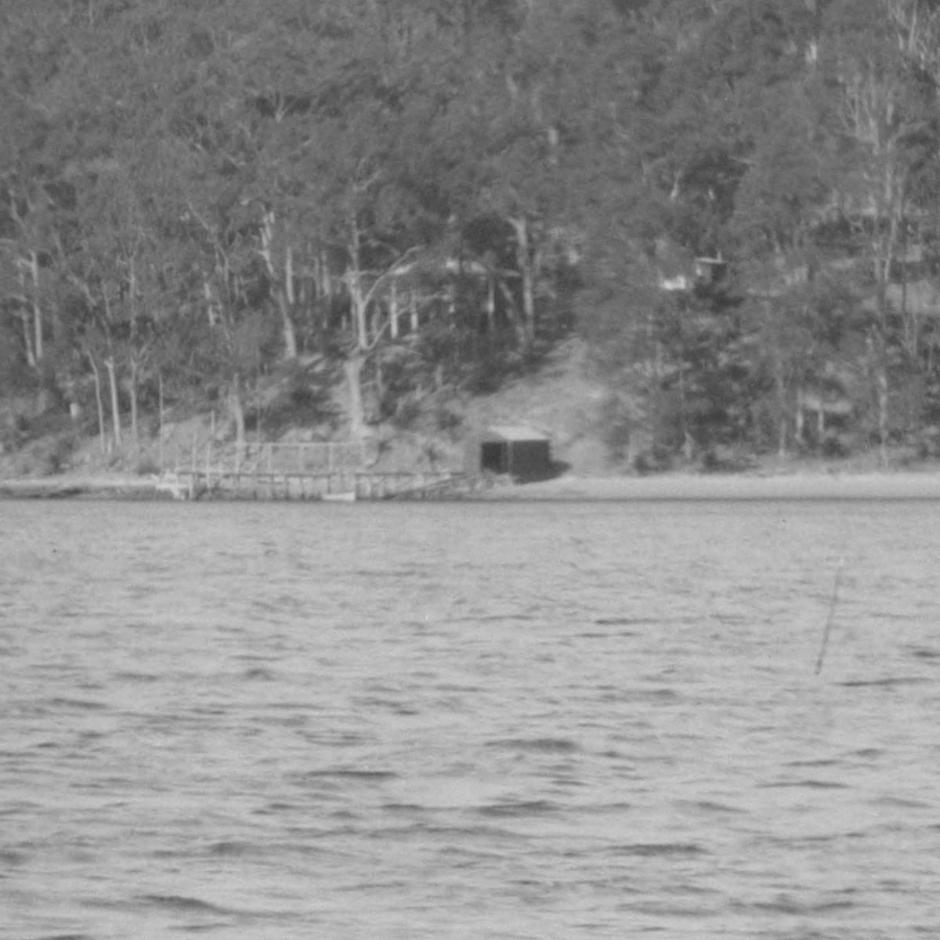
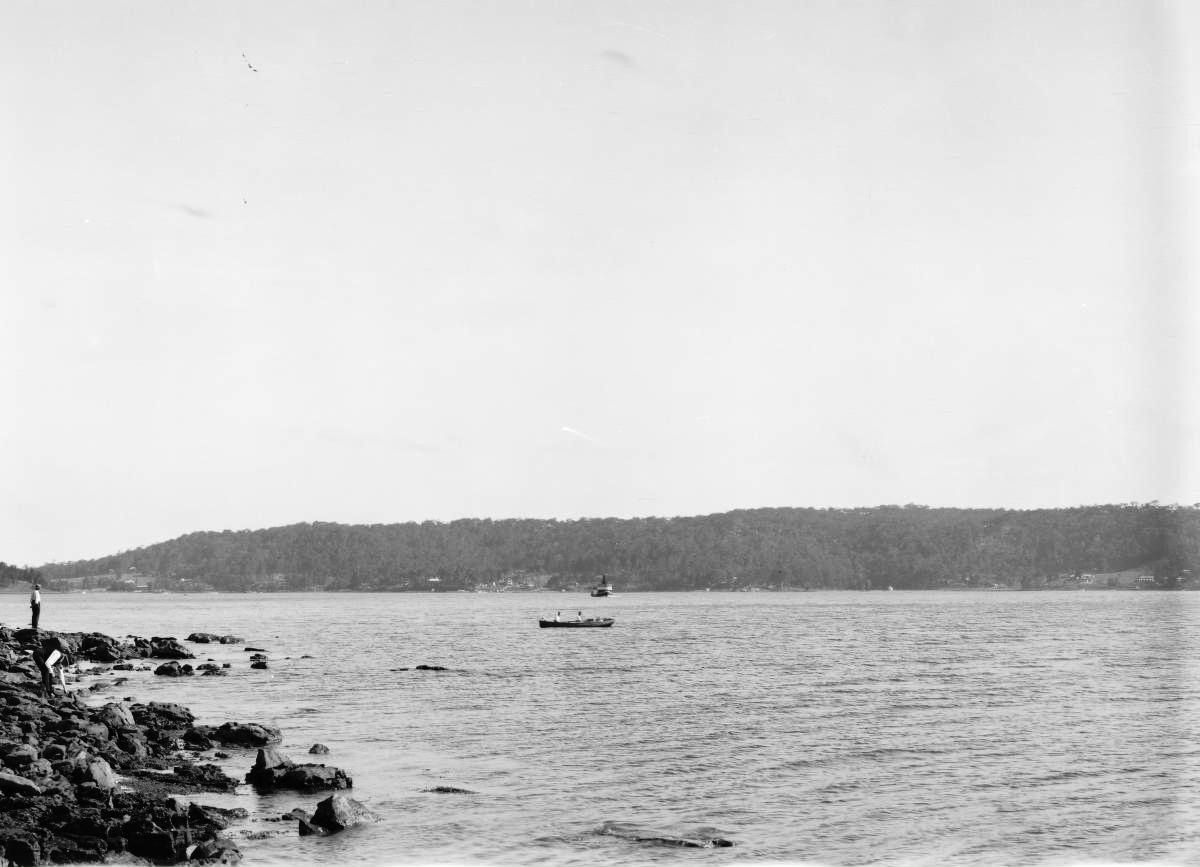
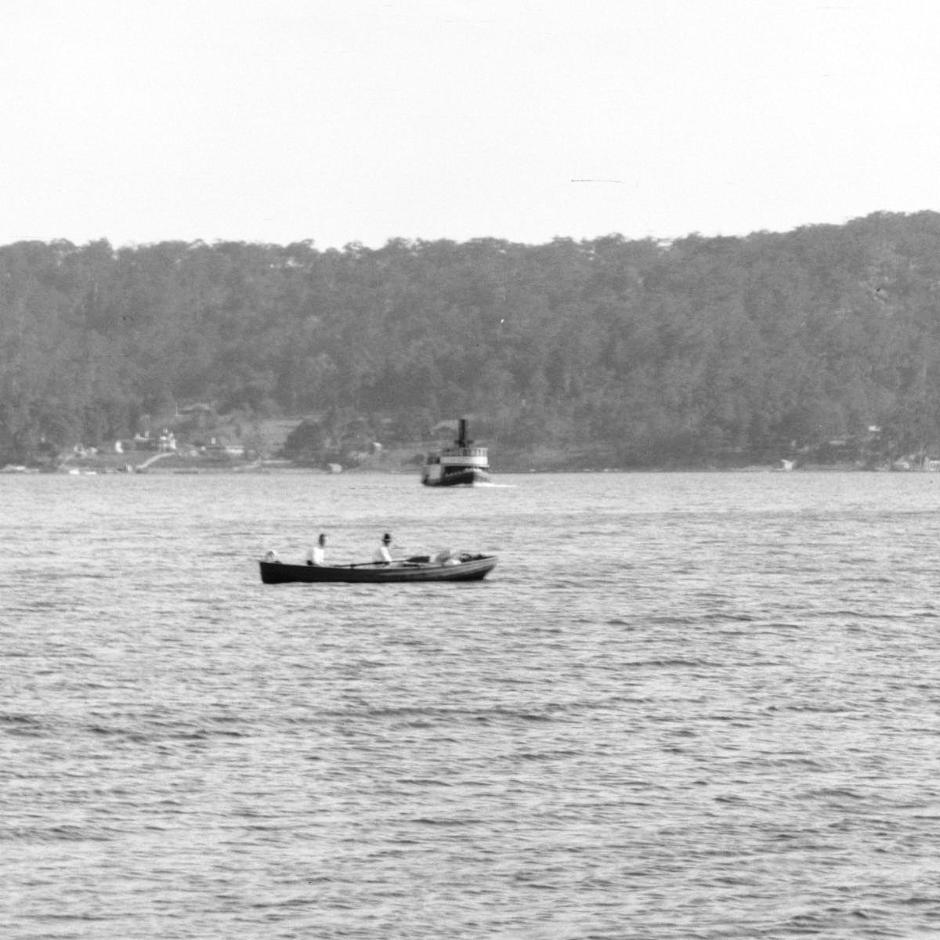
Back page of above purple sales pamphlet:
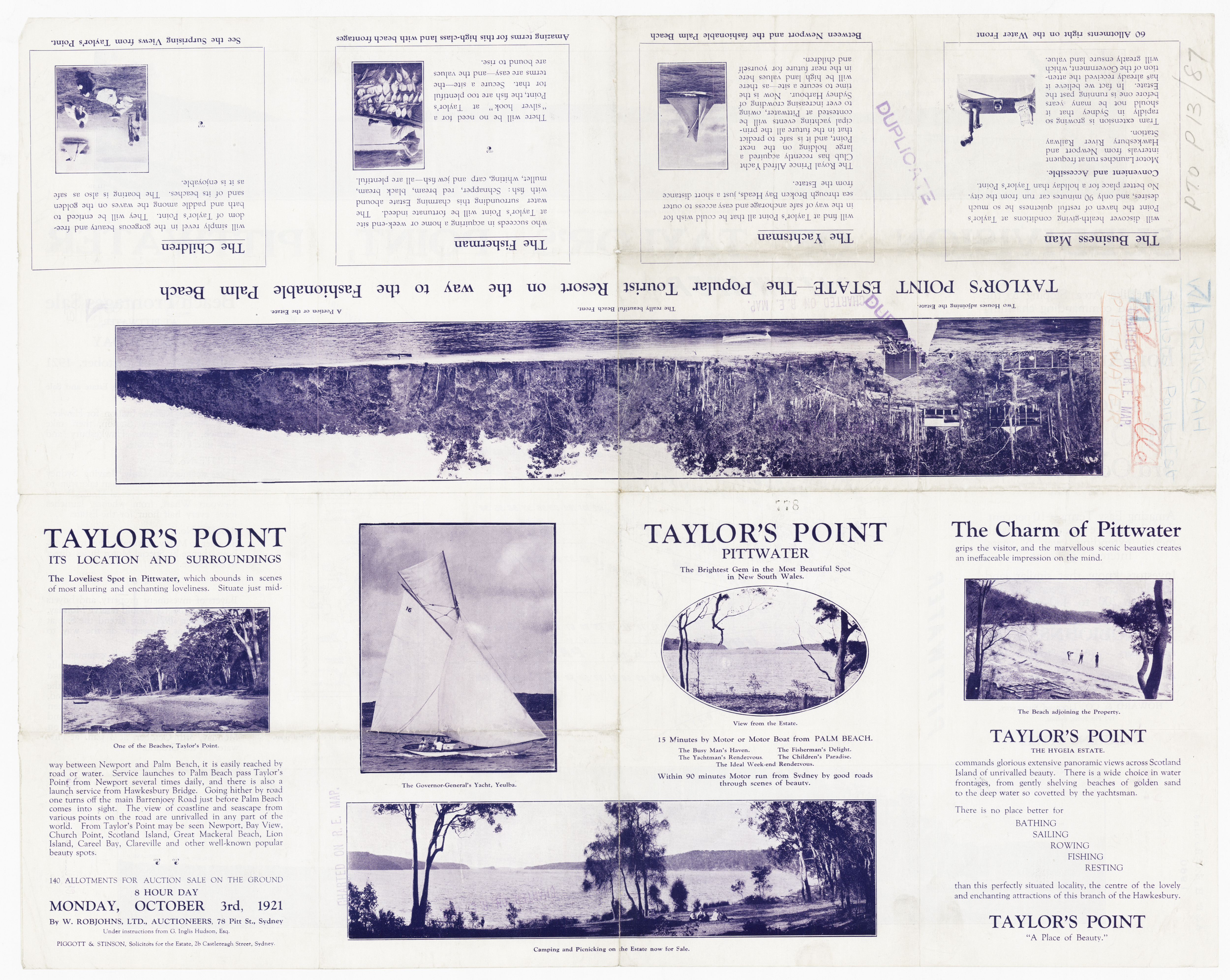
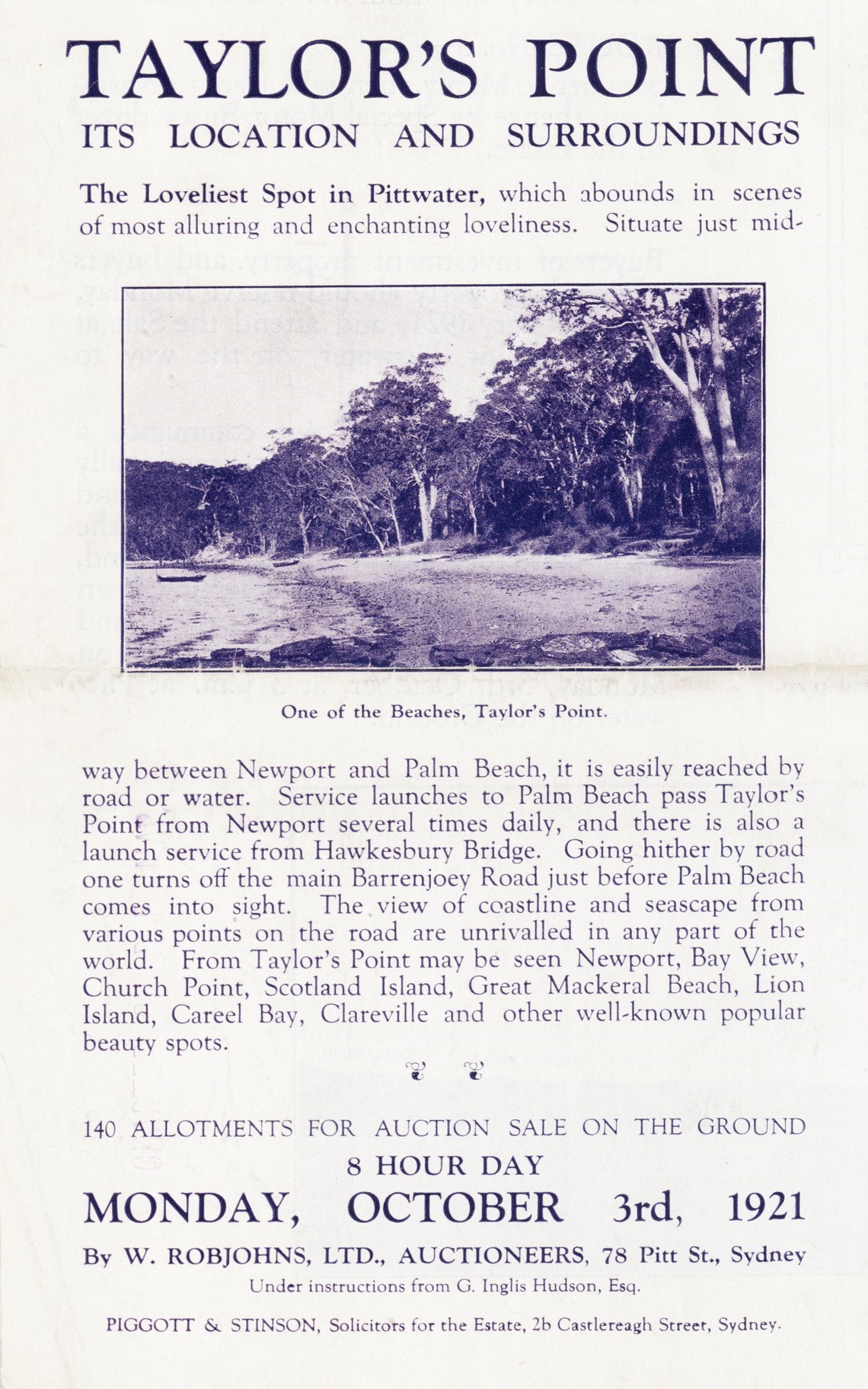
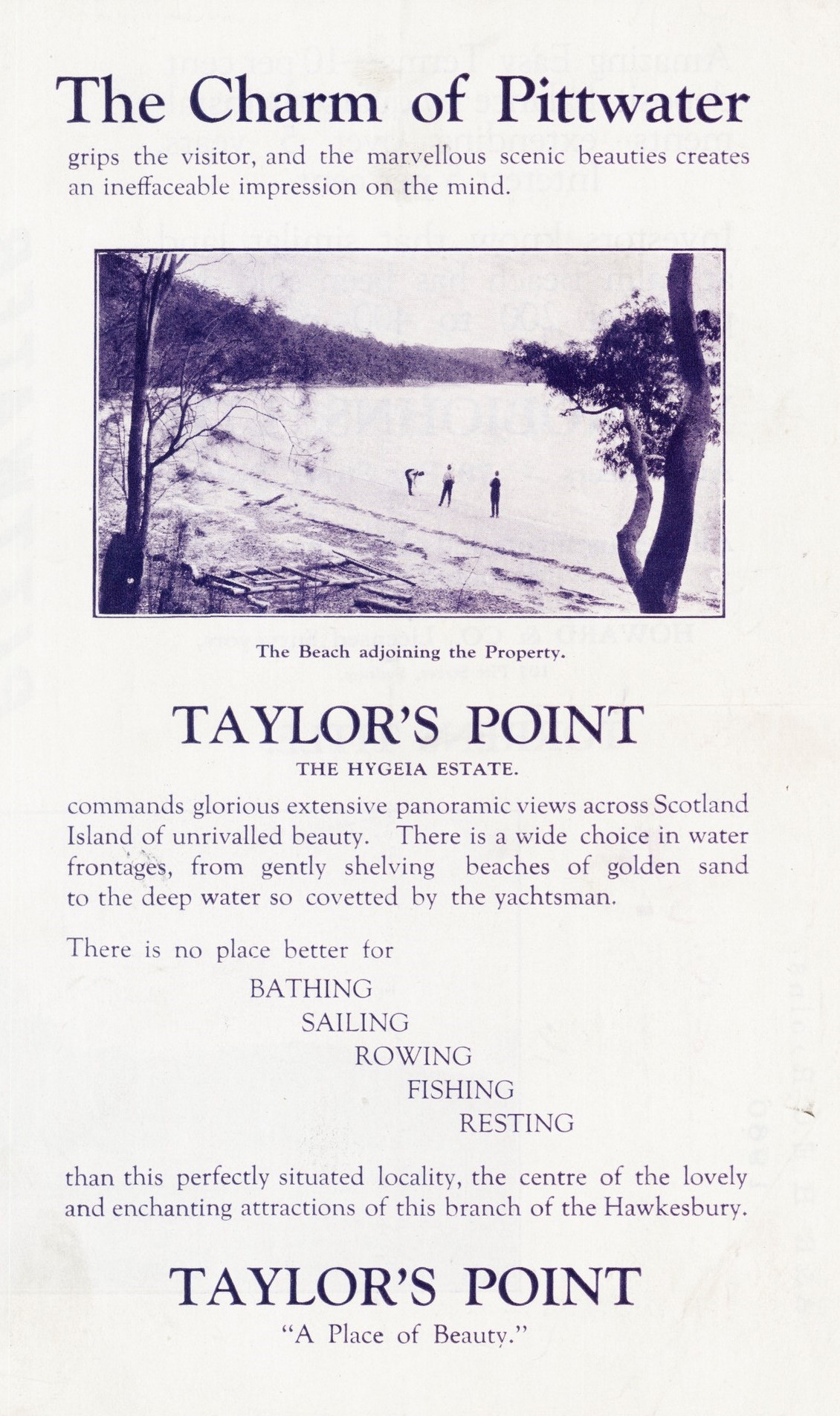
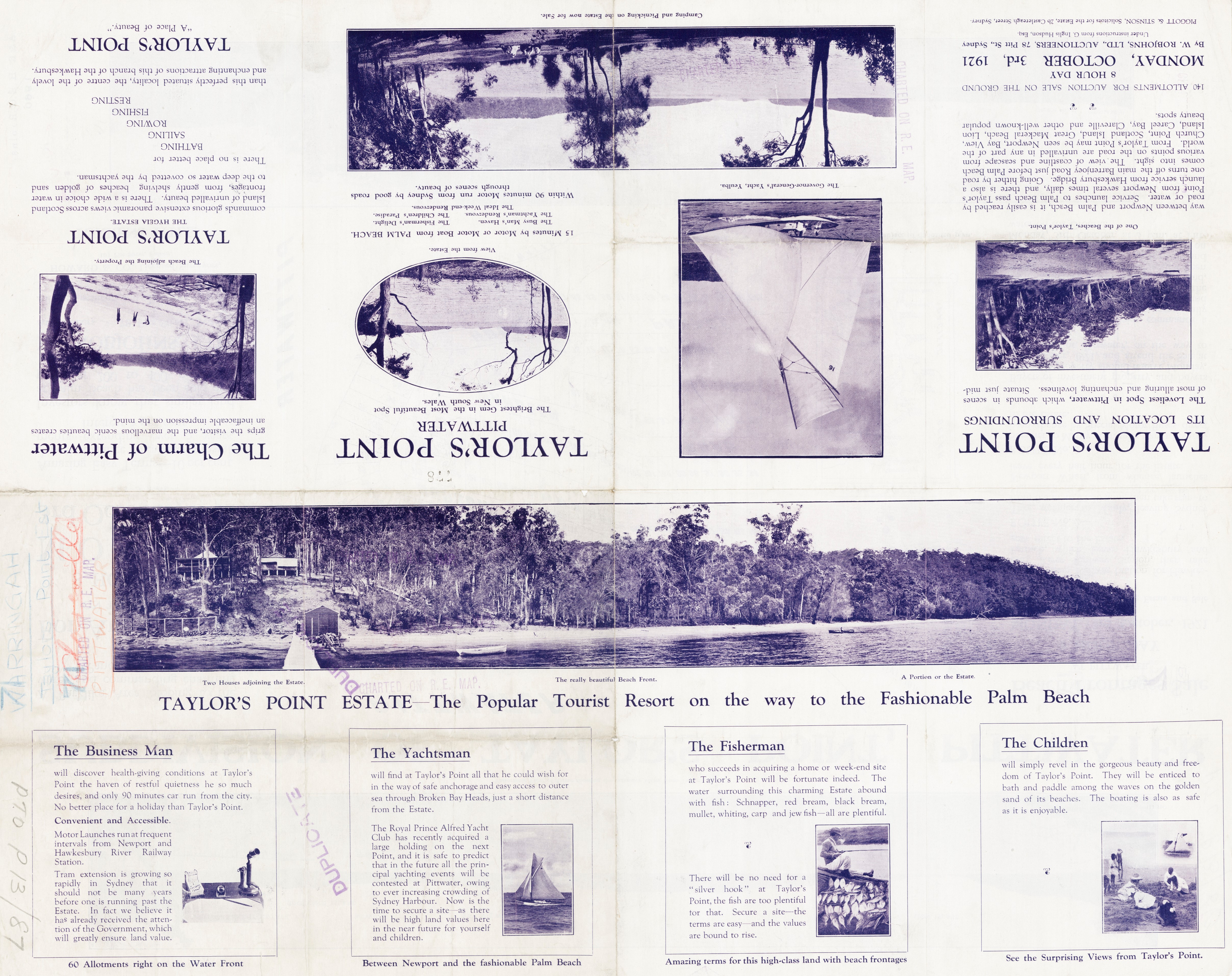
Taylor's Point Pittwater Monday October 3rd 1921 Land sale. Item No.: c053460105, Subdivisions, courtesy State Libnrary of NSW

Panorama of Taylors Point, Pittwater, New South Wales, 3 [picture]- Image No nla.pic-vn6149433 courtesy National Library of Australia, - Part of Enemark collection of panoramic photographs [picture] [1917-1946] . Below: Sections from above panorama
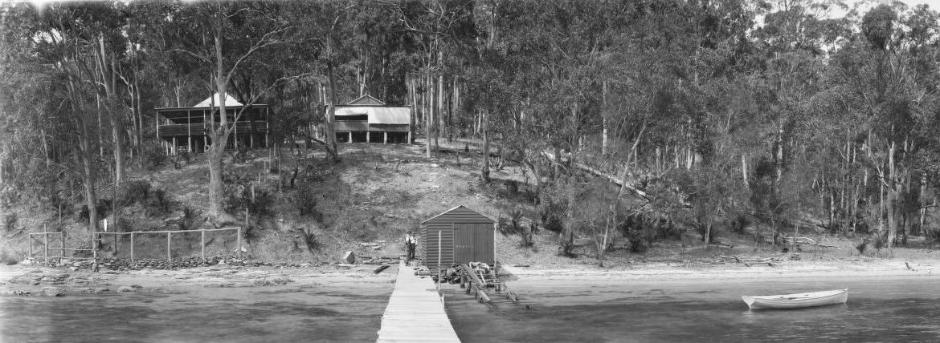
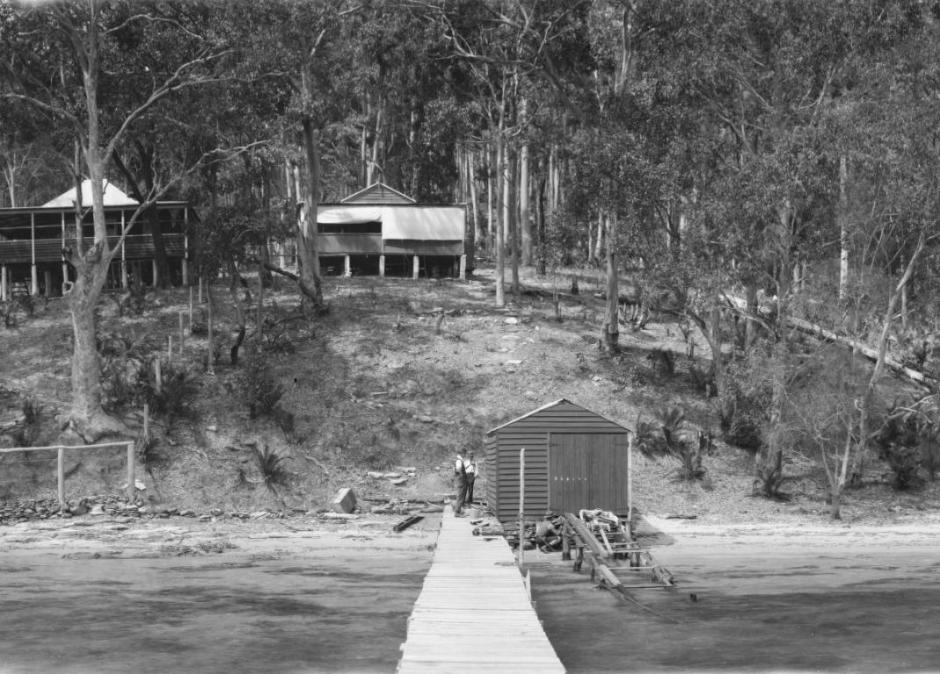
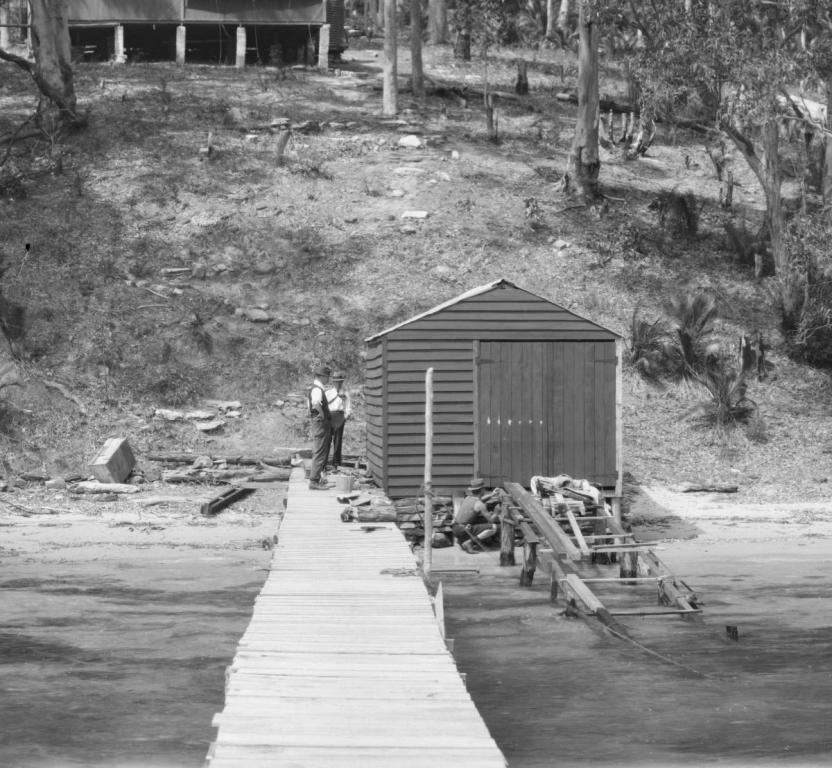
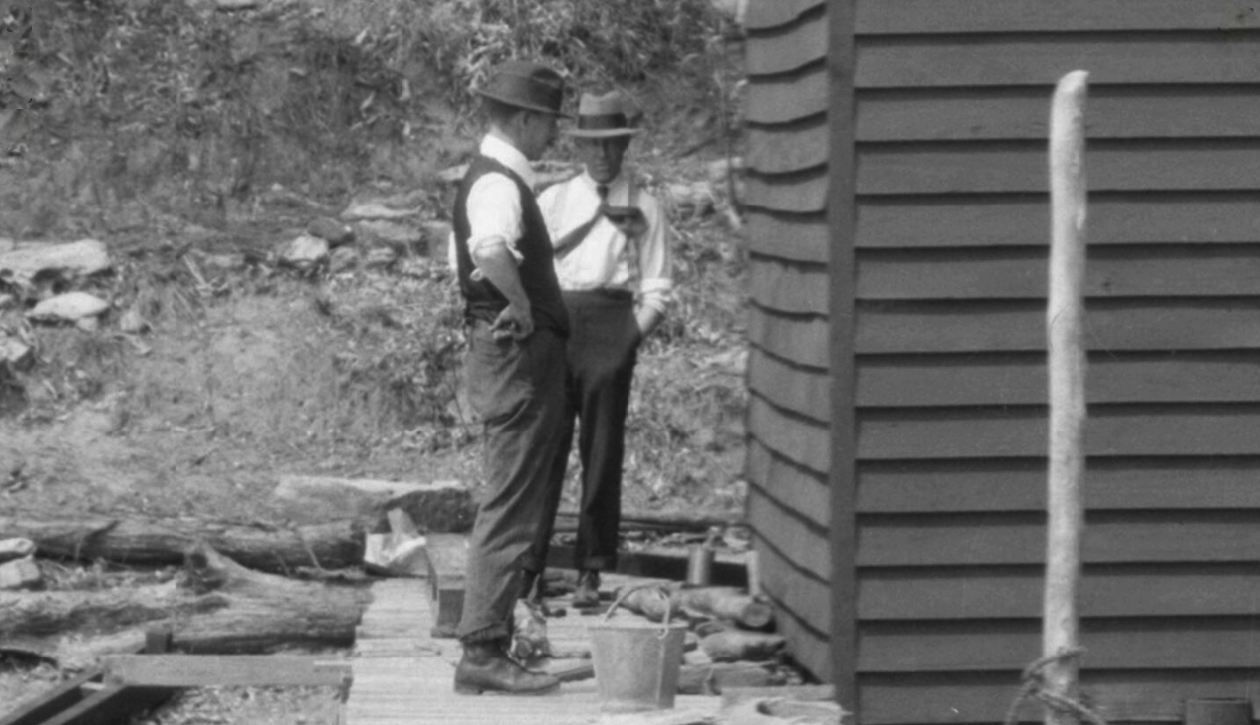
%20Close%20up%20of%20House.png?timestamp=1553978860656)
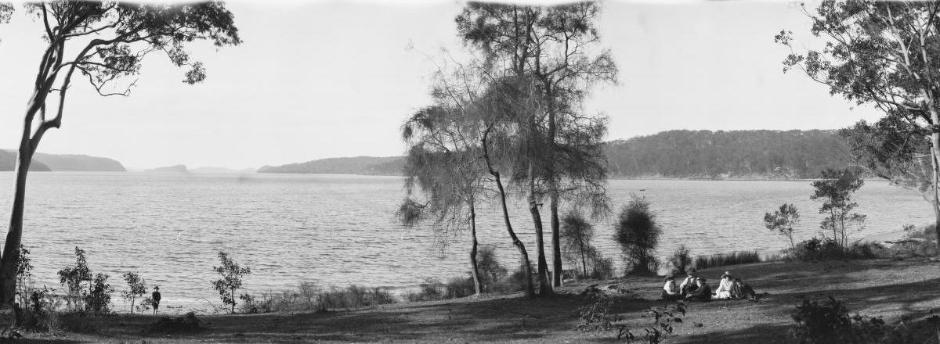
'Panorama of Taylors Point' - 2, Pittwater, New South Wales circa 1917-1921, courtesy National Library of Australia, Image No.: nla.pic-vn6149430 - Part of Enemark collection of panoramic photographs [picture] [1917-1946] . Below: Sections from above panorama
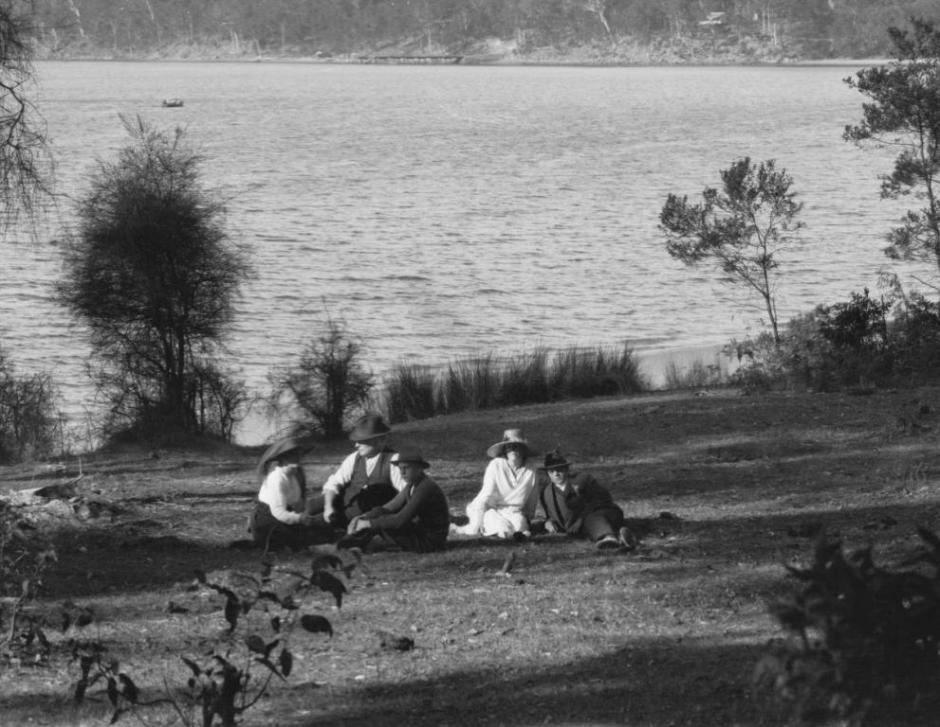
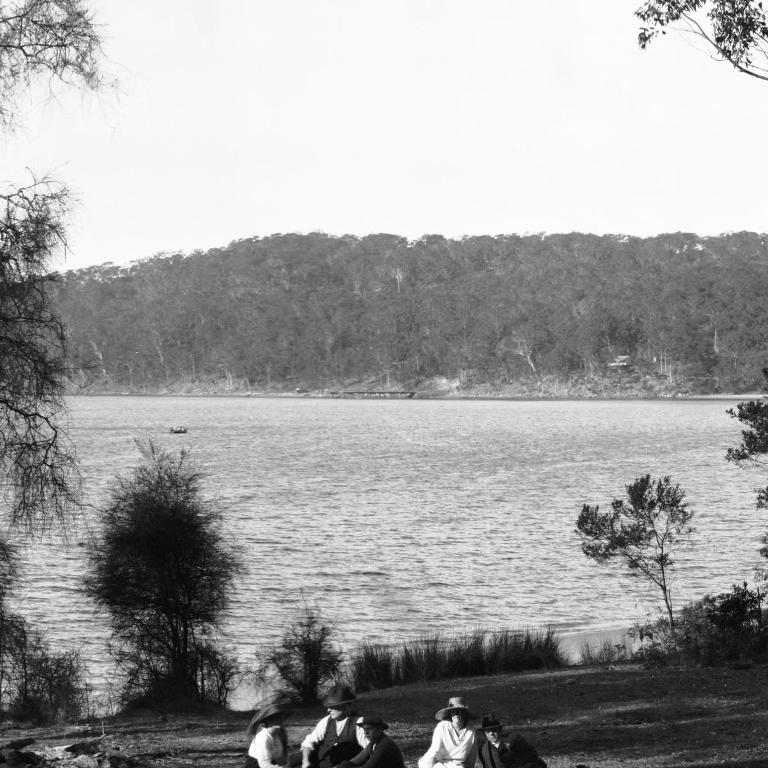
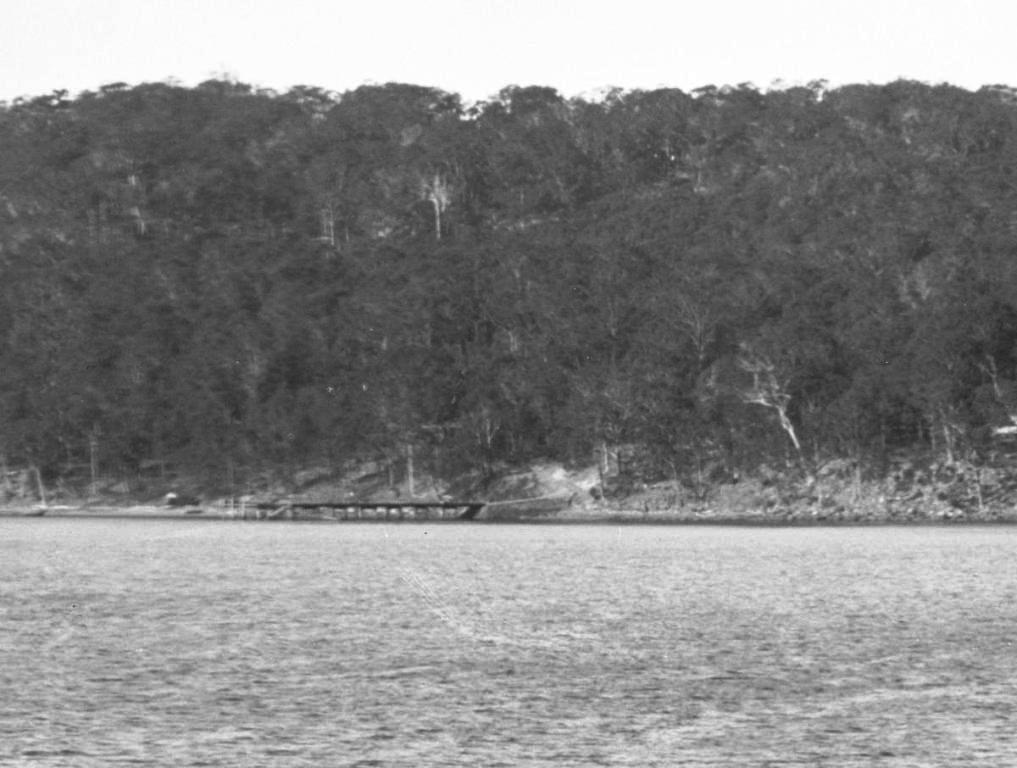
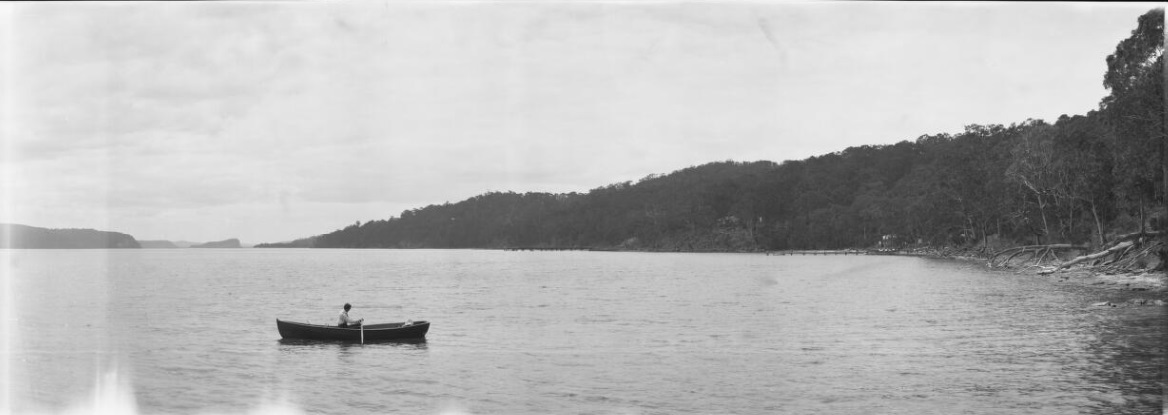
.png?timestamp=1553911134529)
.png?timestamp=1553911167142)
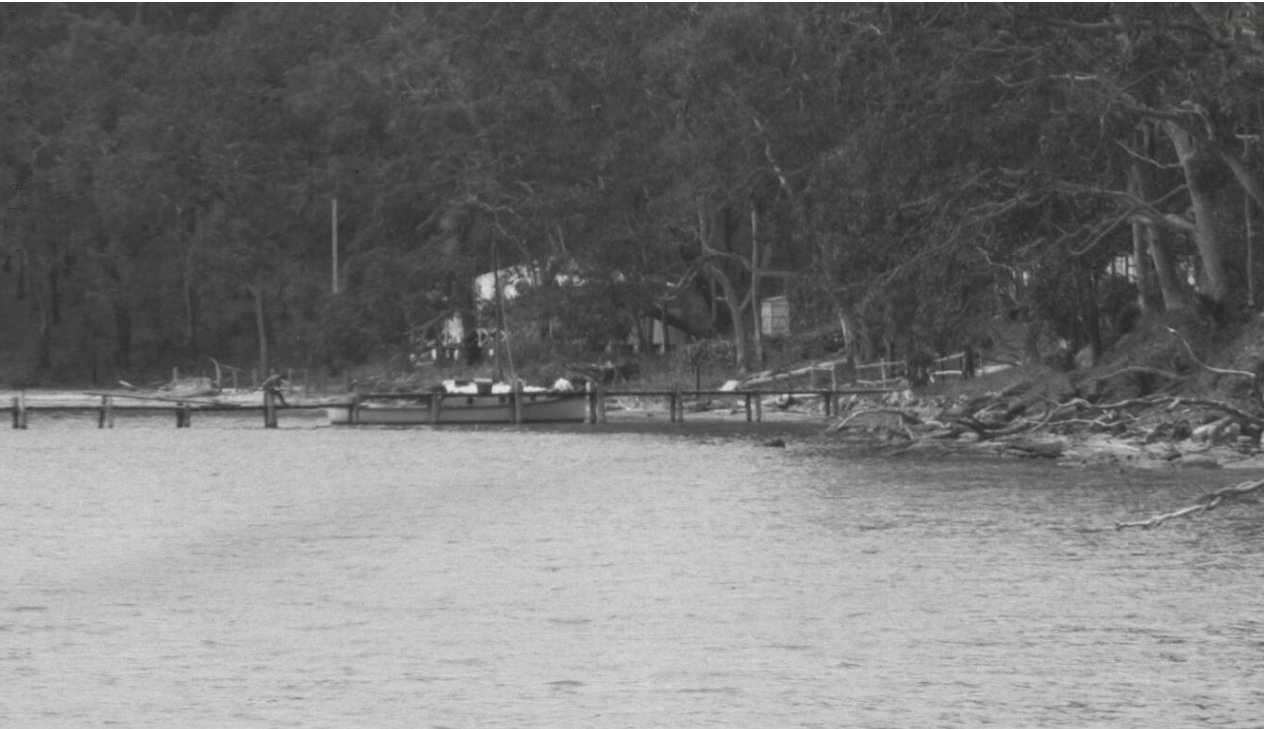
EB Studios (Sydney, N.S.W.). (1917). Panorama of Taylors Point, Pittwater, New South Wales, 1 Retrieved from http://nla.gov.au/nla.obj-162388852
Taylor's Point, Pittwater - Hudson Pde, Wandeen Rd, 1922
The residue 58 allotments were advertised the following year, again using one of those wonderful Enemark panoramas to set the scene:

Pearl of Pittwater Estate, Pittwater - Hudson Parade, Delecta Ave, 1923
The next allotments advertised were sold by Rickards and were further along. First they put in access roads including 'Delecta' Avenue. There was also 30 acres (12 hectares) set aside for a reserve which was originally known as 'Hudson Park' in honour of the gentleman who bequeathed this land and saw having green space being a permanent feature among suburbia as being important - especially since so many koalas once lived there.
Hudson Park was dedicated as a public reserve in 1957. The two reserves were formally known as 'Hudson Park' and 'Angophora Reserve' (area of 18.5 hectares) in 1993. They were referred to under the one title of 'Angophora Reserve' via the Pittwater Council Angophora Reserve Plan of Management adopted on October 21st, 2002. At least his name is still retained in 'Hudson Parade'. Unfortunately the koalas are all gone as that same 2002 POM notes on page 35;
A major problem for the koala population on Barrenjoey Peninsula is attack by dogs, particularly large dogs and dogs working in packs. Dogs appear to be the chief cause of death in this koala colony (Smith & Smith 1990). Dogs should not be allowed to roam free, particularly at night, or where koalas are likely to be on the ground such as where there is a discontinuous tree canopy. More rigorous enforcement of the Companion Animals Act is needed, and frequent evening patrol of the area. However, this should be accompanied by a public education program. It is essential that residents be made aware of the threat posed to koalas by dogs. Cats are less of a threat to koalas being a major predator of smaller animals, such as long-nosed bandicoots and squirrel gliders.
Some information about this on Clareville Beach land sale:
ROAD CONSTRUCTION. Tenders are invited for the Clearing and Forming of about 25 Chains of Roads between Taylor's Point and Clareville, Pittwater, Shire of Warringah. TENDERS CLOSE on WEDNESDAY, 21st instant. No tender necessarily accepted. Plans and Specifications may be inspected at the office of Arthur Rickard and Co., Ltd.. Rickard House.64 Pitt-street. Sydney. Tenders to be addressed; Surveyor, Box 2524, G. P.O., Sydney. Advertising. (1923, March 17). The Sydney Morning Herald(NSW : 1842 - 1954), p. 12. Retrieved from http://nla.gov.au/nla.news-article16062331
THE PEARL OF PITTWATER.
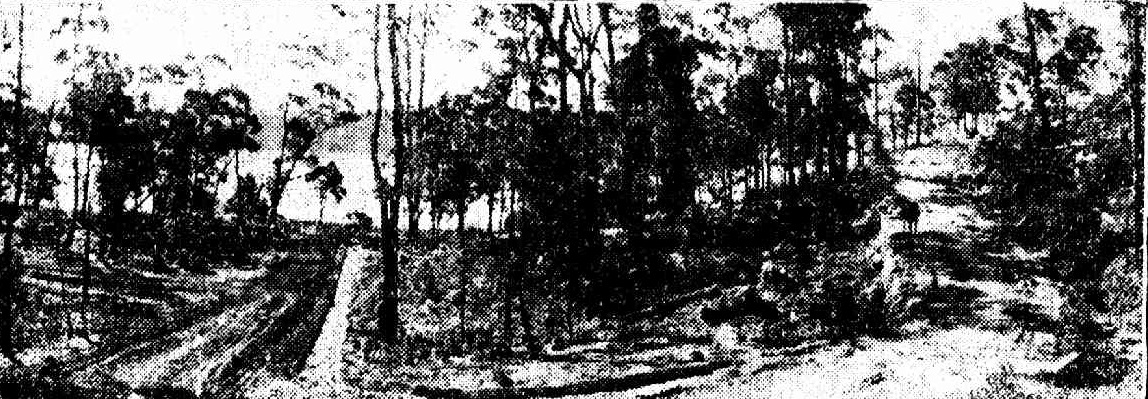
View of portion of the Pearl of Pittwater Estate, which is to be auctioned by Arthur Rickard and Co., Ltd., at Pittwater next Saturday. There is a fine selection of land to choose from, and the views from every block are delightful. THE PEARL OF PITTWATER. (1923, November 24). The Daily Telegraph (Sydney, NSW : 1883 - 1930), p. 10. Retrieved from http://nla.gov.au/nla.news-article245988634
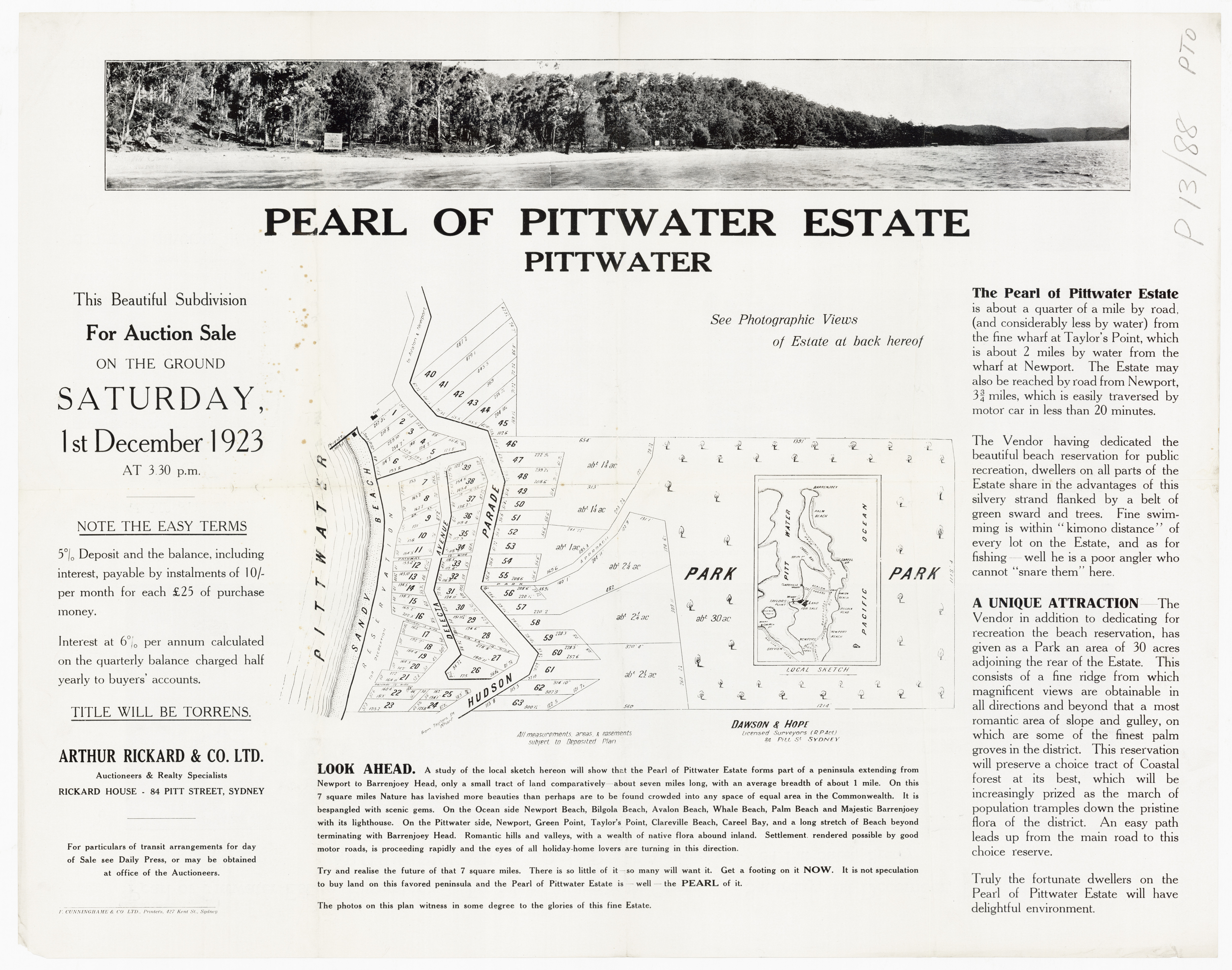
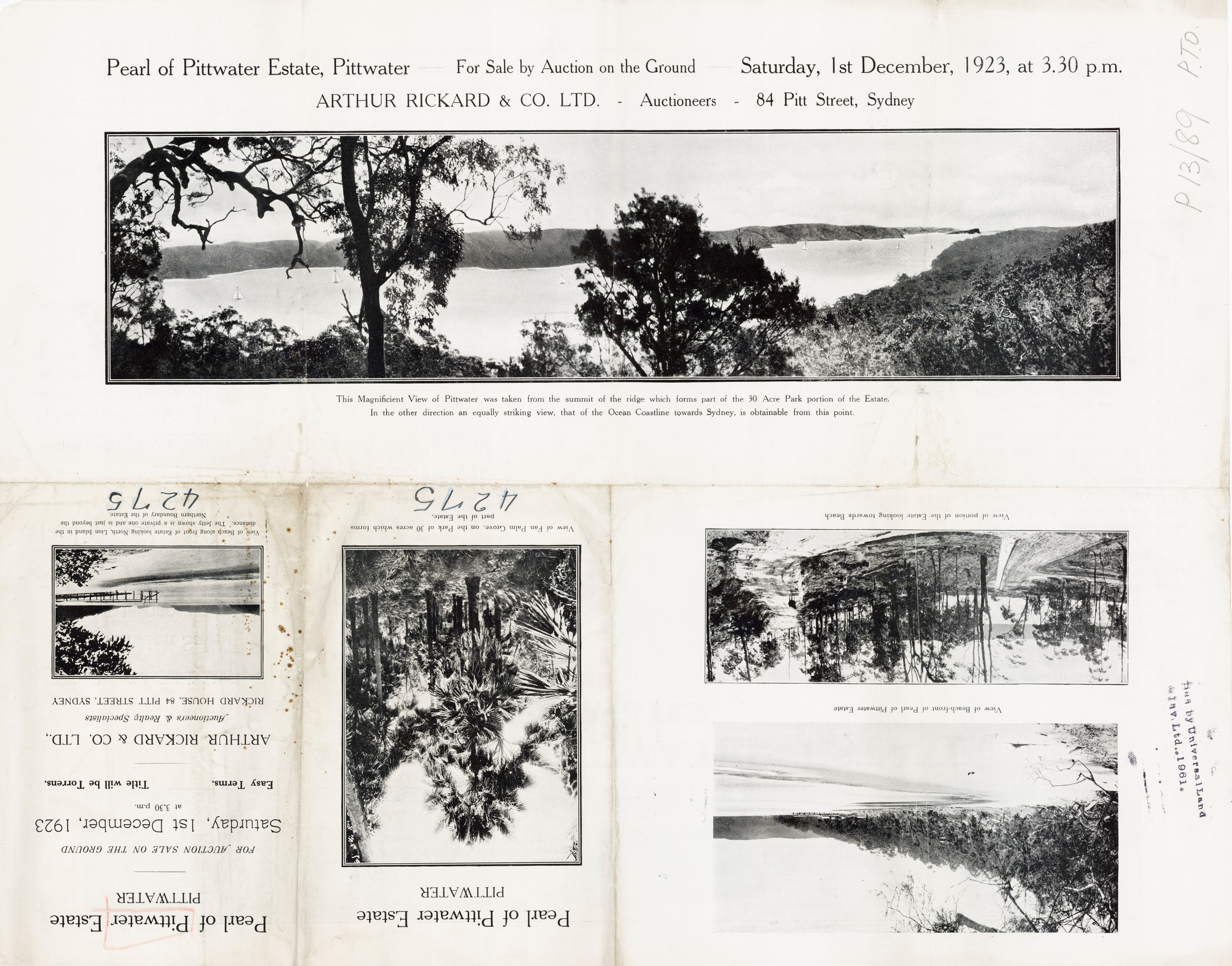
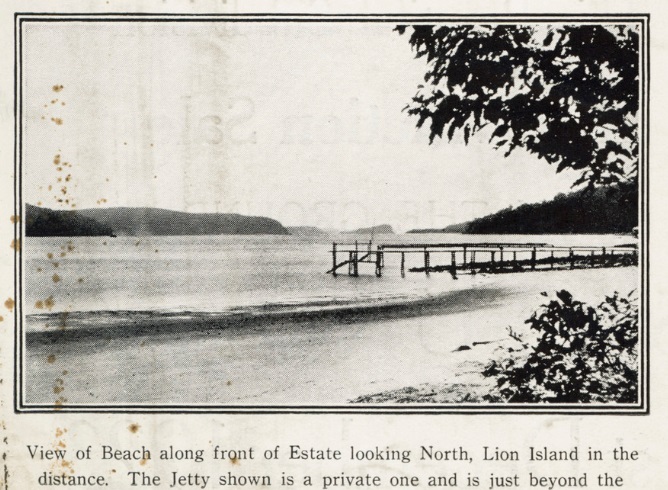
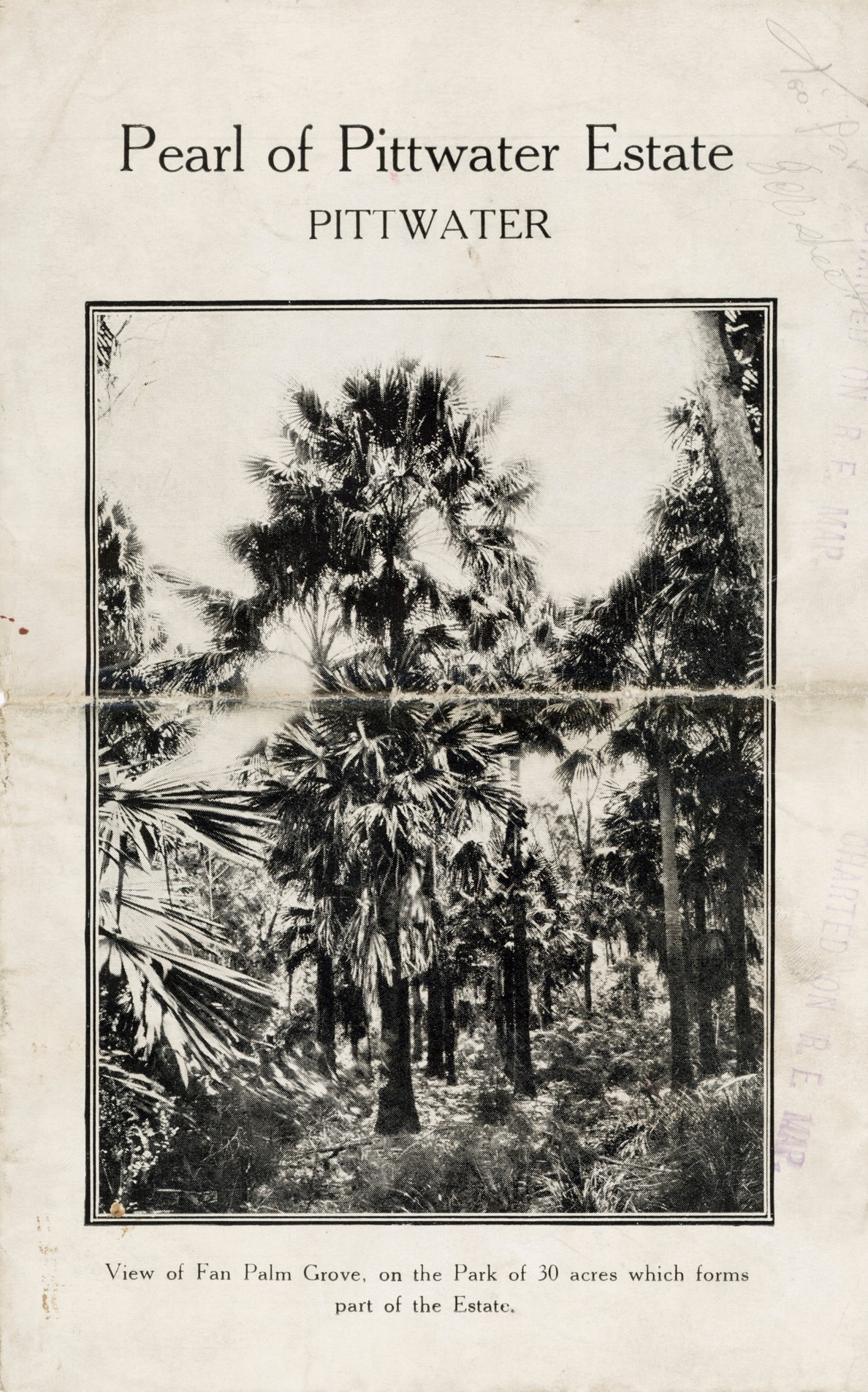
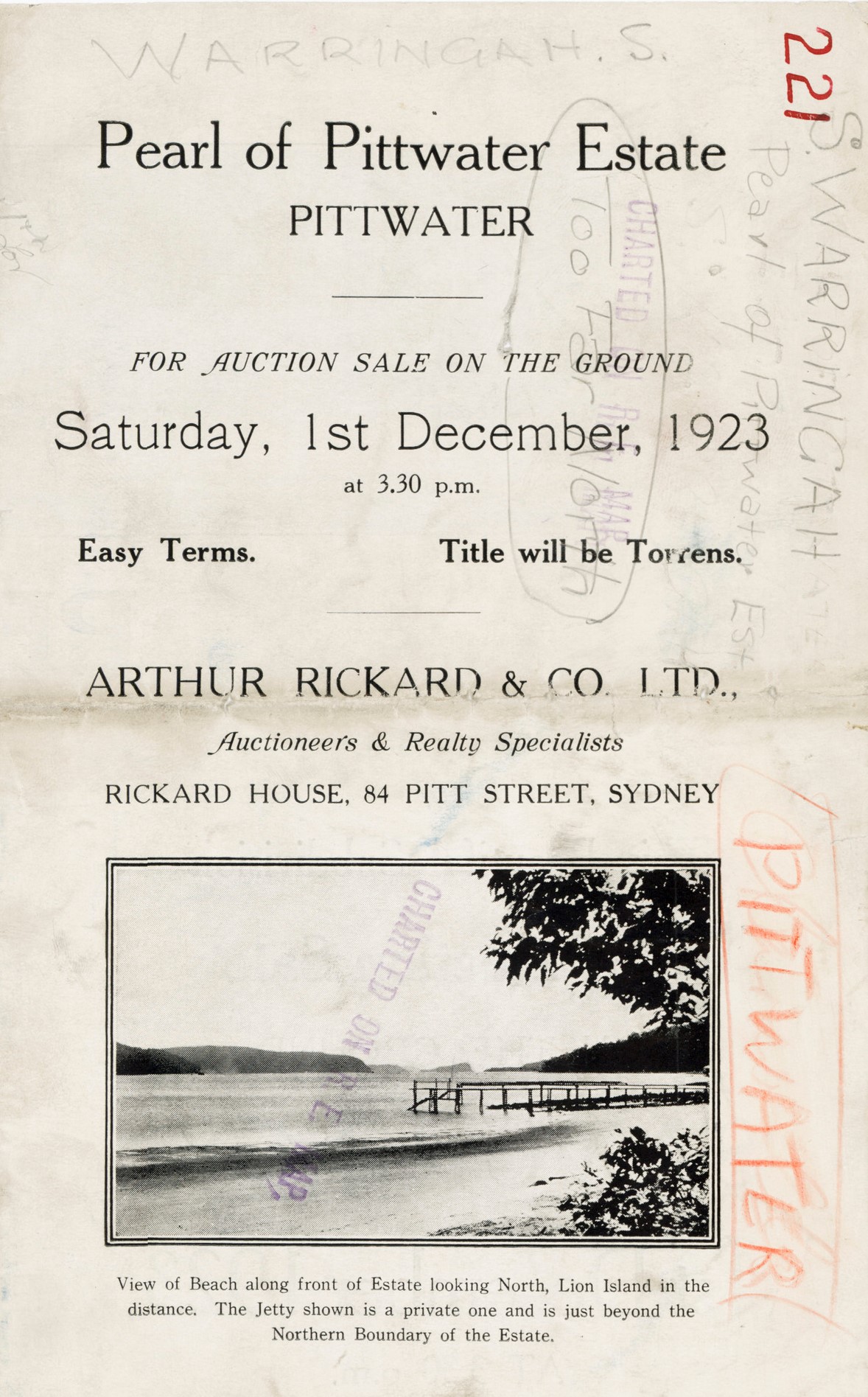
.jpg?timestamp=1553912991011)
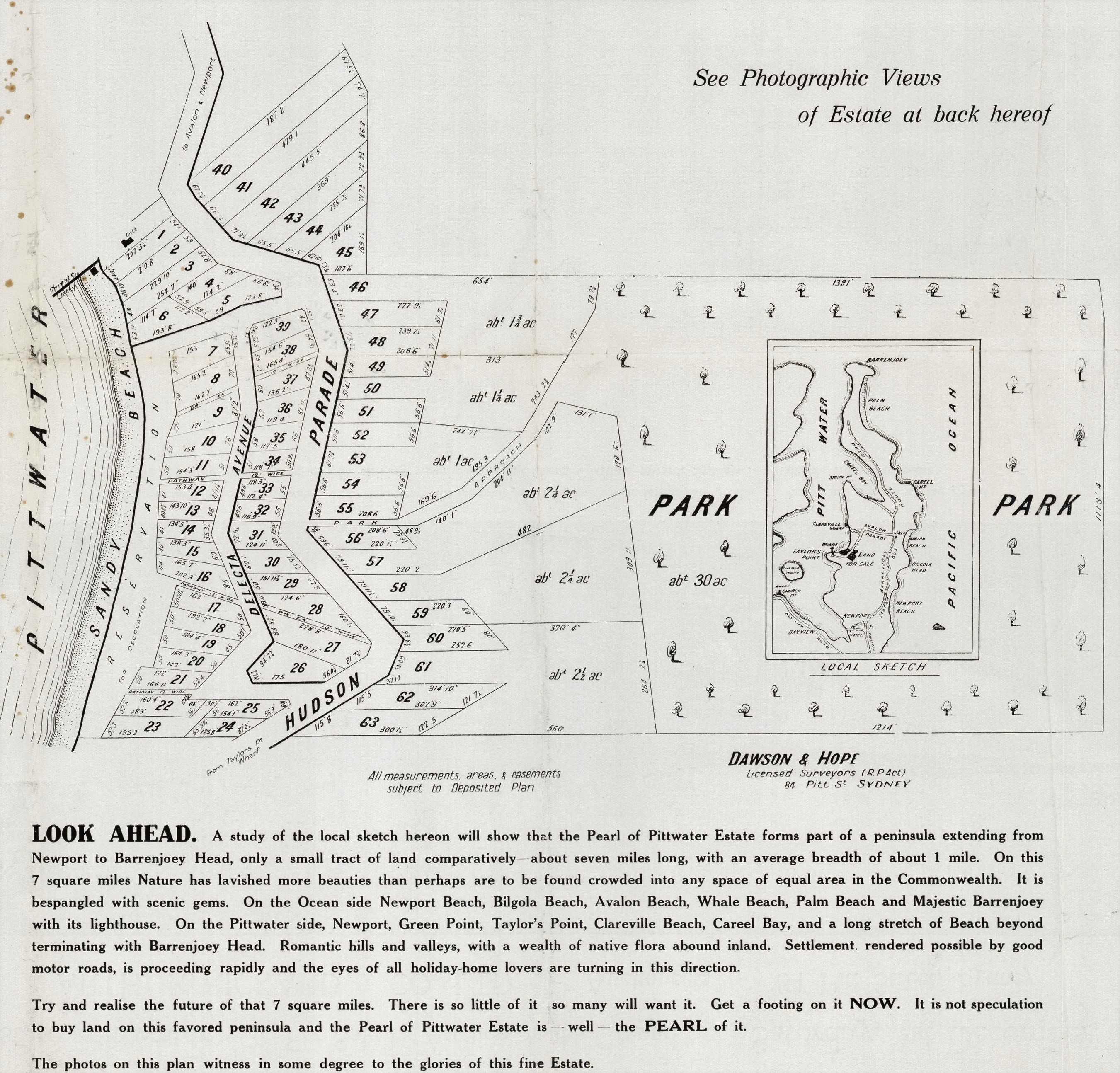
.jpg?timestamp=1553913035145)


Above Pearl of Pittwater Estate, 1922, (and enlarged sections from to show detail). Items: c053460106 and c053460107, courtesy State Library of NSW
The lots of land were still advertised and selling a few years later:
Messrs. Arthur Rickard and Co. report having sold during the week: Pittwater: Pearl of Pittwater, lot 1, £318/10/. SOLD PRIVATELY (1924, January 26). The Daily Telegraph (Sydney, NSW : 1883 - 1930), p. 10. Retrieved from http://nla.gov.au/nla.news-article245897717
ON PITTWATER
TUESDAY'S PICNIC SALE
Scenic charm which is a rare blend of sea and bush, an insurance of beauty by a generous reservation and park, and a situation which makes it a normal week-end resort one of the attractive points of the Pearl of Pittwater Estate, which Messrs. A. Richard and Co., will sell on the land next Tuesday. The wide magnificence of Pittwater fronts the estate, while a belt of beautiful trees thrusts down to the edge of the wide sandy beach. This long strip of timbered land has been reserved permanently for recreation, and another, a park of 30 acres, straddles the ridge at the rear of the estate.
Situated Just past Taylor's Point, and about two miles north of Newport, the estate Is easily reached by road. Motorists, to whom it is more accessible, should turn left at tho cross roads at Avalon, and keep to the left. The whole Barrenjoey peninsular Is one big holiday resort. And the Pearl of Pittwater Estate has many attractions to offer. Fishing, swimming, sailing, boating, all the aquatic sports are at the door. Across the peninsular are the surf beaches. By arrangements with Messrs. Rickard, a de luxe 'bus service will carry picknickers from Manly wharf to the estate and back at a reduced fare. It Is' to be a picnic sale, as befits a holiday. Motorists are expected to join in at any time of the day for lots will be sold privately, not by auction. ON PITTWATER (1926, January 22). The Sun (Sydney, NSW : 1910 - 1954), p. 12 (FINAL EXTRA). Retrieved from http://nla.gov.au/nla.news-article224062005
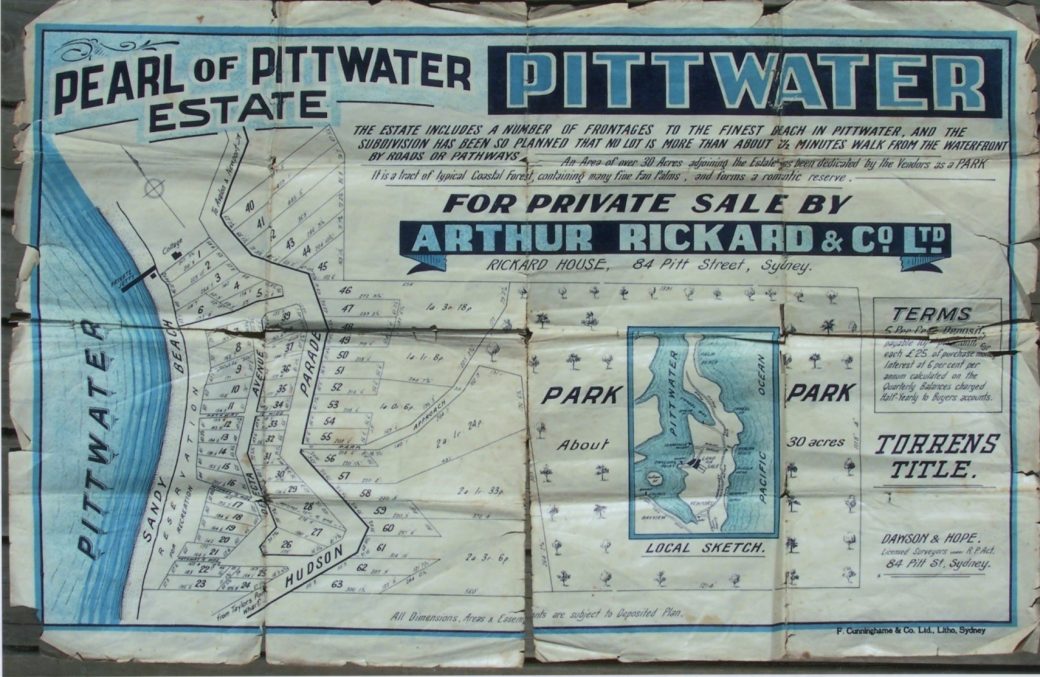
ON PITTWATER
PICNIC SALE TO-MORROW
Allotments overlooking Plttwater, on the sloping shores at .Newport, will be sold' to-morrow by Messrs. Arthur Rickard and Company- at a special picnic sale. These allotments are In the P.earl of Plttwater estate, 'much of which sold rapidly at the end of lust summer, and they consist of blocks suitable for camps, week-end houses or permanent homes. All blocks are generously sized, many having frontages of 72 feet with adequate depths,, Newport is the . starting point for all the fishing parties on Pittwater, and the home "port" of the large fleet of launches which noses around the bays and headland every week-end. The land will be sold on the usual easy terms accorded buyers by Messrs. Rlckard and Co. ON PITTWATER (1926, October 29). The Sun (Sydney, NSW : 1910 - 1954), p. 15 (FINAL EXTRA). Retrieved from http://nla.gov.au/nla.news-article224122127
More land sales - at Clareville or ??:
At Clareville, Pittwater, six good sea side blocks, about 400 yards from Clareville wharf. REAL ESTATE, CITY SUBURBAN AND COUNTRY (1927, December 14). The Daily Telegraph (Sydney, NSW : 1883 - 1930), p. 37. Retrieved from http://nla.gov.au/nla.news-article246206925
List of Streets in Clareville:
Although the above land subdivisions indicate how those first Clareville byways were named, others acquired what we now know to get around by far more recently.
At the Warringah Council Ordinary Meeting of June 25th 1979 Council resolved to re-name the southern section of Hilltop Road, Clareville (off Wandeen Road) "Illangi Close". The names submitted for consideration were:- (a) Aboriginal Illangi (Close) - "Camp on a hill" Mia (Close) - "Native shelter" Ilaroo (Close) - "Track by the sea" Broula (Close) - "Place of trickling water" (b) Other Hillend (Close)
In accordance with prescribed procedure Council had advertised the proposed re-naming on April 7th, 1979. The four property owners affected by the proposed re-naming were written to on April 4th, 1979 and their comments invited concerning the proposed re-naming. Only one reply was received, within the month allowed for the lodging of objections, from the owners directly affected.
In response to Council's notification to residents of the proposal to rename that section of Hilltop Road off Wandeen Road, two replies were received. A letter from Mr. F. Howitt, of Wandeen Road, suggested the name 'Mia Close' (Native shelter). Mr. G. H. Mills of Hilltop Road advised that he and other affected residents, with whom he discussed the proposed renaming, favoured the name 'Illangi Close' (Camp on a Hill). The recommendation was then put forward that the southern part of Hilltop Road, Clareville (off Wandeen. Road) be renamed 'Illangi Close' in accordance with the provisions of Section 249(a) of. the Local Government Act.
Mr. Mills initially drew Council's attention to the fact that it would be desirable to have the subject part of Hilltop Road re-named. Mrs S. Caines, one of the affected property owners written to, advised by letter that she wrote to Council within the month stipulated and requested that the section of Hilltop Road to be re-named be called "Wandeen Place". However her letter did not appear on Council's files. Accordingly that southern section of Hilltop Clareville (off Wandeen Road) was to be re-named Wandeen Place
On June 18th 1991 the Public Works Committee Meeting, delved into the matter again at the behest of council from an early 1991 discussion.
On February 19th 1991, Council resolved:- "That Council acknowledge the objection to the renaming of Wandeen as "Yeramba Place" as valid, and approve the renaming of Wandeen Place as "Tarpeena Place" subject to the appropriate advertising and action required under Section 249(a) of the Local Government Act.
Following the advertising of the proposed name change and notification of residents adjoining the subject road, Council received a letter of objection from Mr B Johnson, objecting to the name change from Wandeen Place to "Tarpeena Place". Mr Johnson did not put forward any other suggested names.
Mrs Susan Caine of Wandeen Road, Clareville, a corner block adjoining the subject road, also objected to the proposed name change and suggested that the name "Mia Place" would be more appropriate. In addition to these written objections, a number of telephone objections to the proposed name change were received, however, no name was proposed by these objectors.
There was no clear agreement between the various residents whose properties adjoin the subject road as to a name that would be acceptable to both them and Council. Council proceeded to rename Wandeen Place as "Mia Place" (Aboriginal for "small") on the basis that it was proposed by one of the residents and is not currently used within Warringah Shire.
The name was approved and the renaming of Wandeen Place as "Mia Place" occurred. So "Mia" with a meaning of both "small" and "Native shelter", according to which record you read, became the name.
Bilwara Avenue: 'Trees' - which sort? . Has been used as a name for a house/home from at least late 1890's -1900's - once instance at 1900 industrial Pyrmont found.
Clareville instance is from February 1958 Bilgola Plateau Pty. Ltd - owners. Part Block 5 - 21 allotments and new road - Bilwara Avenue. In October 1960 Warringah shire Council records list 'Transfer to BILGOLA PLATEAU PTY. LIMITED in respect of Public garden and recreation space in a subdivision at Bilwara Avenue, Bilgola Plateau;' In 1967, Frank M. Mason & Co. owner, Bilgola Plateau Pty. Ltd. was applying to progress Part of 'Lot 5' Zoning Residential A(33 allotments): Council had approved.this application on Februray 27th, 1967, subject to certain conditions and resolved that "decision concerning the amount of land to be provided as a Public Reserve being deferred until Council can obtain a legal ' opinion as to its entitlements following the decision of the Board of Subdivision Appeals concerning an earlier submission for part of this land".
In March 1968 ,with 40 allotments now occurring council suggested the following names for the new roads in this subdivision; "Loblay Crescent" and "Mark Place"- nearby 'Bilga Avenue' in present day Bilgola Plateau has a meaning of 'Bees nest'.
With each language/dialect in each place different, and so much of the language for the 'songlines' of Pittwater lost, were the use of these words as accurate as those who thought of them wanted them to be?
Compare: Bilerong; 'Place of Swamp Oak', Bilinga; 'Magpie', Bilkurra; 'Narrow-leaved Box Tree', Billang; 'To push or roll', Billara; 'Dead leaf', Billeang; 'Bat', Billeroy; 'Running creek', Billinudgel ; 'good view', Biloola; 'Cockatoo', Bilyan; 'To throw off cloak', Bilyara; 'Eaglehawk' - sourced from Grandpa Pencil finds some 'B' Australian Aboriginal Words - website. Retrieved from http://www.grandpapencil.net/austral/abword/abb.htm
Delecta Avenue: Latin - Form of the verb dēlectō (“delight”). Verb[edit]. dēlectā (for attaining high standard) picked, chosen, select.
Georgia Lee Place:
Hansford Parade: Hansford is a surname and rare male given name, which originates from the Old English, meaning "'Ford near protected temple'".
Hilltop Road: 'Hill' + 'Top' - top of the hills road!
Hudson Parade: named for George Inglis Hudson, landowner. Was extended in 1955:
SHIRE OF WARRINGAH.—Naming of Roads.—Ordinance 30, Clause 53, Local Government Act.—Notice is hereby given that the undermentioned roads have been renamed in accordance with section 249 (a) of the Local Government Act:—
Past Name or Location and New Name. 1. Koskull-avenue, Forestville—Elizabeth-avenue.
2. Avalon-parade, west of its intersection with Central-road and Beach-parade, Clareville—Hudson-parade.
3. Main Road No. 529, sometimes known as Pymble-road— Forest Way.
4. Lane running south off Palm Beach road, Palm Beach, at the rear of properties fronting Pacific-road and Florida road, d.p. 18,074—Livistona-lane.
5. Unnamed road leading north from Mona Vale road past portions 208, 207, 206, 205 and 201, parish of Narrabeen— Chiltern-road.
6. Road leading south from the junction of Haig-street and Pringle-avenue, Belrose, to south of Blackbutts-road, known from this junction to Glen-street as Haigh-avenue—Pringle-avenue.
7. Road leading from Warringah-road to Tristram-road, Beacon Hill, just east of Oxford Falls road—Daines-parade.
8. Road curving between Myoora-road and Booralie-road, Terrey Hills—Bindook-crescent.
9. Road recently opened by Lands Department, running west" from Thuddungra-road, Terrey Hills,' between lots or portions J.H. 318, F. and K.L.M. 319, N.O.—-Namba-road.
10. Road recently opened by Lands Department, running west from Thuddungra-road, Terrey Hills, between lots or portions P./U. and P.P.; U.W., A.A. and H.H.—Wyong-road.
13. Road recently opened by Lands Department, running south-west from proposed Wyong-road along western boundaries of lots P.P., Q.Q., R.R., S.S. and T.T.—Anembo-road.
12. Road recently opened by Lands Department, running south-west from proposed Wyong-road, between lots H.H., J.J., and A.A., B.B. and C.C.—Bibbenluke-avenue.
13. Unnamed road running west and north-west from Powder works-road along part of northern boundary of portion 80, and through portion 83, parish of Narrabeen—Wilson-avenue.
J. MORGAN, Shire Clerk, Shire Hall, Brookvale. 16th June, 1955. 1792—£3. SHIRE OF WARRINGAH.—NAMING OF ROADS.—Ordinance (1955, June 24). Government Gazette of the State of New South Wales (Sydney, NSW : 1901 - 2001), p. 1777. Retrieved from http://nla.gov.au/nla.news-article220302395
Lisa Place:
Lower Plateau Road: the lower part of the Bilgola 'Plateau road' - Bilgola Plateau and Bilgola Beach street names will run as a dedicated stand alone page.
Mia Place: both "small" and "Native shelter" - to honour original custodians last seen gallivanting on the bay and eating oysters in 1788
Mirrabooka Street: Mirrabooka is an Aboriginal name for the constellation most commonly known as the Southern Cross.
Riverview Road: view of the river - Pittwater!
Stromboli Place: Is an Italian pastry with cheese and meat, rolled! But in this instance
Taylors Point Road: named for early landowner
Wandeen Road: Optimistic, Peacemaker, Cheerful, Lofty (?)
Yarrabee Place: 'Gum Forest' - aboriginal word - refers to eucalypt trees
WARRINGAH SHIRE COUNCIL.—Notice of Road Renaming at Clareville.—
Past Name and New Name
Southern part of Hilltop Road, Clareville (off Wandeen Road).—Illangi Close.
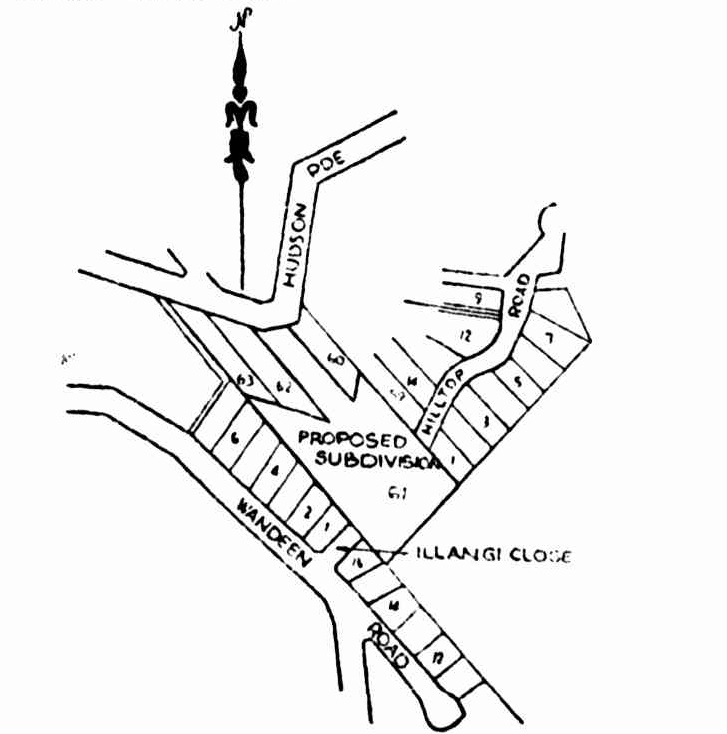
R. M. STUCKEY, Shire Clerk.
Civic Centre, Dec Why. 9668—$34.20
WARRINGAH SHIRE COUNCIL.—NOTICE OF ROAD RENAMING AT CLAREVILLE.— (1979, July 20). Government Gazette of the State of New South Wales (Sydney, NSW : 1901 - 2001), p. 3581. Retrieved from http://nla.gov.au/nla.news-article219963111
Clareville—F. dwlg., Riverview Rd.—A. Hanson, 283 Clarence St., Sydney, Owner/Builder; £550. BUILDINGS & WORKS APPROVED (1941, April 16). Construction (Sydney, NSW : 1938 - 1954), p. 3. Retrieved from http://nla.gov.au/nla.news-article222860855
Geoff Searl, president of the Avalon Beach Historical Society, shared some insights into the Hanson family in:
Avalon Beach SLSC 90th Anniversary Exhibition And Celebrations, May 1-3, 2015
Riverview Road, although considered part of Avalon Beach, also stretches into the Clareville environs and is considered by many to be part of where Clareville and Careel Bay link. Riverview will be included in the Avalon Beach Street Names page.
Some Early Clareville - Paradise Beach Houses
Ashlar
32 Hilltop Road
Constructed in 1930 by Clareville landscape painter Robert Johnson, 'Ashlar' is one of the earliest homes built in Clareville. Considered one of the finest examples of late 19th century sandstone architecture in Pittwater, this home is Heritage listed, and retains its original charm with ashlar dressed sandstone walls, enormous open hearth fireplace, and broad verandahs, three bedrooms and wide opne rooms with windows that let in the light - perfect for a painter!
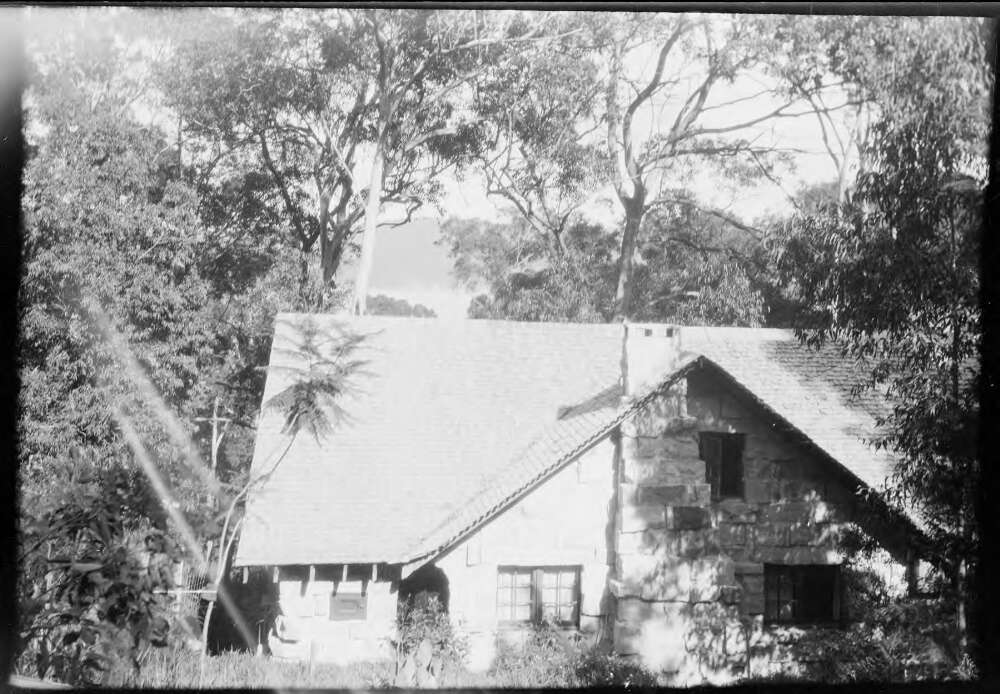
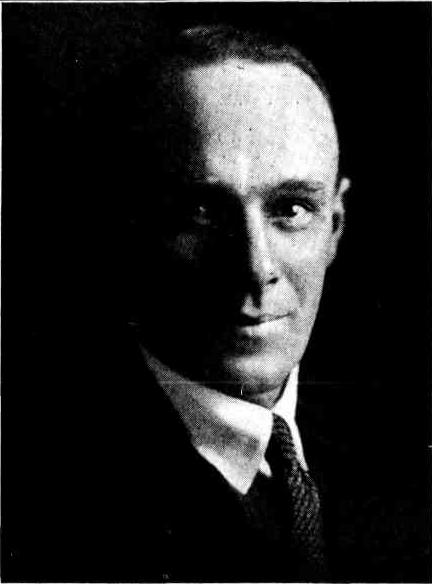
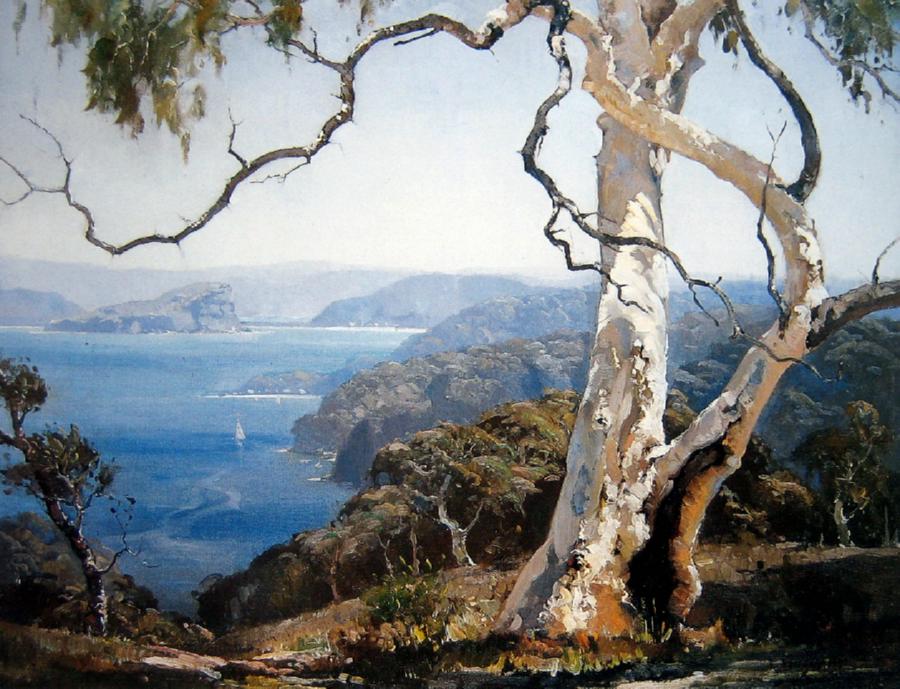
In a Bush Setting
Canadian Log Cabin Fits Into Australian Scenery
SET in the bush on a sloping hill that runs down to Pittwater at Clairville, and fitting exactly into the surroundings without a single jarring note, is a real Canadian log-cabin, and one has only to see it to wonder why the shores of our beautiful seaside resorts do not contain more of them instead of the ugly weatherboard and iron structures on their unsightly piles that now disfigure the landscape. White ants? Yes, but even the white ant can be defeated if you put a determined woman on his track.
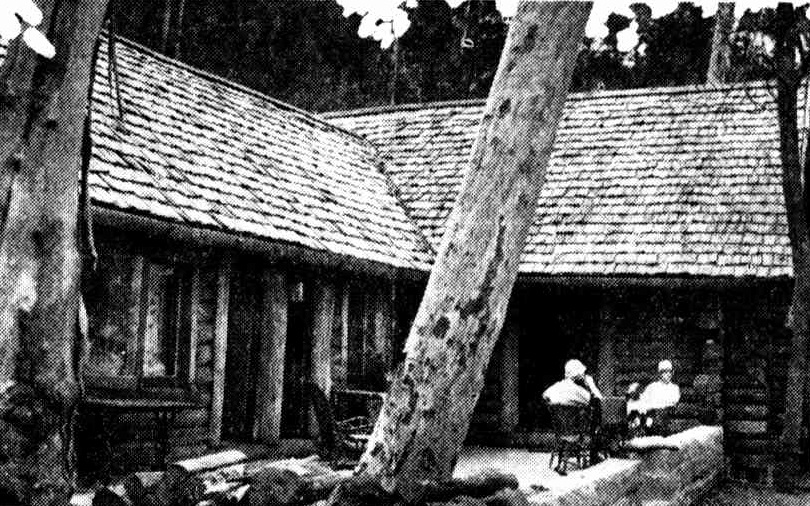
Barley Water and orange juice with reaI American doughnuts, make a fitting repast served on the terrace of a real Canadian log cabin. Mrs. Sibley entertains on a Sunday morning.
When Mr. and Mrs. L. P. Sibley, American residents in Sydney, decided to build for themselves a weekend shack, they didn't get an architect to draw a plan and a builder lo carry it out — for Mrs. Sibley had her own ideas about a log- cabin, gleaned . mostly from the Canadian backwoods cabins she had seen at home, and she first chose a spot that would .fit. into the picture, and, at the same- time, supply the necessary relaxation and quietude for her husband.
Having picked on Clairville, she next engaged the services of a couple of local woodsmen, showed them her plan, and said. "Can you do it?" They could — and did. Within seven months of buying the land, timber, selected from the surrounding hills, and some of it from over by Kareel Bay, had been chosen, felled, and stripped; and was drying for the job.
As little as possible of the bush was cleared to allow for the foundations, and local tallow-wood, black butt, stringy-bark, and" red walnut, with a couple of tall palm trunks thrown in, Messrs. McDonald and Gilhome built the first bungalow of its kind that has graced those picturesque shores. As the work progressed, Ted and Mac (they very soon became part of the family scheme) grew more interested in the job, until when it was finished Ted inquired anxiously about the curtains.
So perfect was the natural effect that he was afraid Mrs. Sibley, might spoil it with colorful chintze. But But Mrs. Sibley's taste in such matters couldn't err with the curtains. The bushland effect was carried to completion with eucalyptus green net curtains, quite plain, backed up with plain green serge ones for coolness sake. No machine-handled timber has been used in this rough-hewn cabin. The axeman's marks are visible on every jutting end of timber, bolted to its brother with stout bolts in place of nails. Hand-split shingles cover the roof, and where a tree jutted into It at the corner of the house/the roof has been built to accommodate its growth. Nor has the conventional tin guttering been allowed to enter the picture, and here Is where the palm tree was used. Split down the centre and hollowed out, it makes excellent guttering, fitted to the eaves with strips of hand -turned iron, screwed into position.
The massive doors have been carved out of black-butt, the living room (main entrance) door being particularly attractive In Dutch style, in two sections, the lower one fastening on a hasp, the upper one swinging back on a great hinge and locked with a giant bolt and key that once adorned a church door.
.jpg?timestamp=1553653914001)
Above : Interior of the living-room, with its rough log walls and magnificent mantelpiece of solid blackbutt on two stone elbows. A couple of quaint green ginger jars lend a colorful note. This room has windows fore and aft and at the side, while the other side opens on to the terrace — a kind of indoor verandah.
.jpg?timestamp=1553653881170)
Just a glimpse of the living-room door, with its giant boll and key that once graced on old church door. Showing the solid proportions of the doors, with their slab sashes and window sashes in keeping.
The deep-pitched roof is unlined as yet, and strips of bark are still hanging from the straight saplings used in its construction. To, the bare log walls, in corners and such places where one is likely to come in contact with it, quaint Indian rugs and tapestries have been nailed. The tallow-wood floors, unspoiled with paint or polish, but in their natural state, only sandpapered for smoothness, are covered here and there with cream washable wool rugs, and the odd bits of furniture, those that could be spared from the town house, are mostly lovely old bits of cedar, with a couple of Chinese red lacquered cabinets to add color.
The mantelpiece and fireplace lend a splendid dignity to this unconventional living room. The latter has been fashioned out of solid slabs of sandstone, deep and with always a log or two smouldering on it, and is surmounted by a solid slab of black-butt, four inches through and 12 feet long. No plane or sandpaper has been used on this, for the marks of the adze are plainly visible on its surface, as they are on the split shelves that appear over the windows and support quaint sets of plates and mugs.
All the doors work on the latch system, with a hole drilled through them above the wooden handle, through which a leathern thong is passed through to the outside. Pull the hasp and push the door to get in — and when you want to lock he door, simply pull through the thong is the inside, and it cannot be operated from the outside. A refrigerator supplies a modern touch to the kitchen with its wide windows opening out on to the terrace, ind its red checked gingham cover on the table. All the rooms— there are only three —open on to this porch or terrace of green concrete, and a giant bluegum has not been sacrificed to the scheme of things. It is carefully skirted by the concrete, and continues its majestic way to the skies— a natural shade for the bungalow.
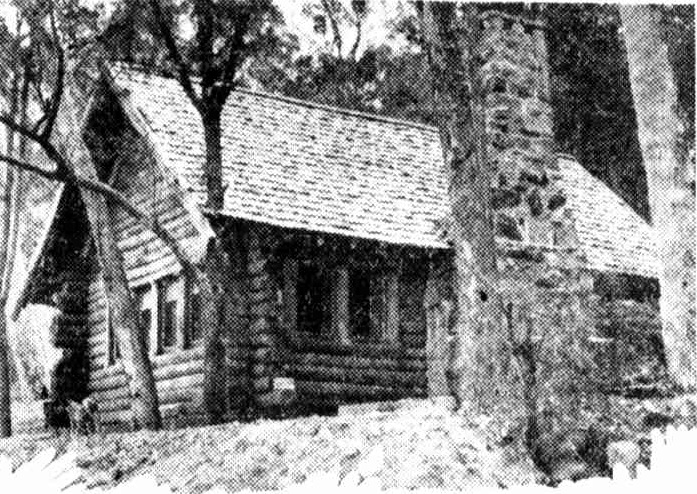
The log cabin from the road, showing the solid stone chimney hewn from the properly.
A couple of marble-topped tables that might once have graced a restaurant, give to it the quaint charm of a wayside inn, while the touch of color necessary to liven up the Australian landscape is provided by colorful lacquered cane chairs. No brush has touched the rustic simplicity of this simple abode, though, of course, stringent and effective methods have been taken with creosote to check a white-ant invasion, and Mrs. Sibley keeps an eagle eye on the foundations to make sure that this enemy of the wooden structure gets no opportunity to- begin his devastating work. In the same way has she set about systematically to destroy that other menace of the seaside or bush home —the blowfly.
"When we first came here, we could not move for flies— now we have scarcely any," she will tell you, pointing with pride to what look like miniature beehives hanging on all the surrounding trees. They are specially constructed fly traps, and they have been responsible for the slaughter of literally thousands of flies. But the birds— the kingfisher and the kookaburra and the butcher-bird, and all the smaller fry that make waking in the morning such a joy in the bush, are encouraged by means of wire sieves full of barley and such delectable food, placed on handy trees. Within a year, when the weather has mellowed the timbers to a soft grey, and the trailing creepers which have been set, grow up over the roof, this log cabin will be just a bit of the landscape, exactly as it is intended to be. "I do feel that here in Australia, where people have so many natural beauties, they do little to enhance them, and so much to spoil them," says Mrs. Sibley, in justifiable pride of her achievement, "and I want this place to show what can be done to enhance the natural beauties of one of the beauty spots of the world." In a BUSH SETTING (1932, December 11). The Sun (Sydney, NSW : 1910 - 1954), p. 27. Retrieved from http://nla.gov.au/nla.news-article230579376
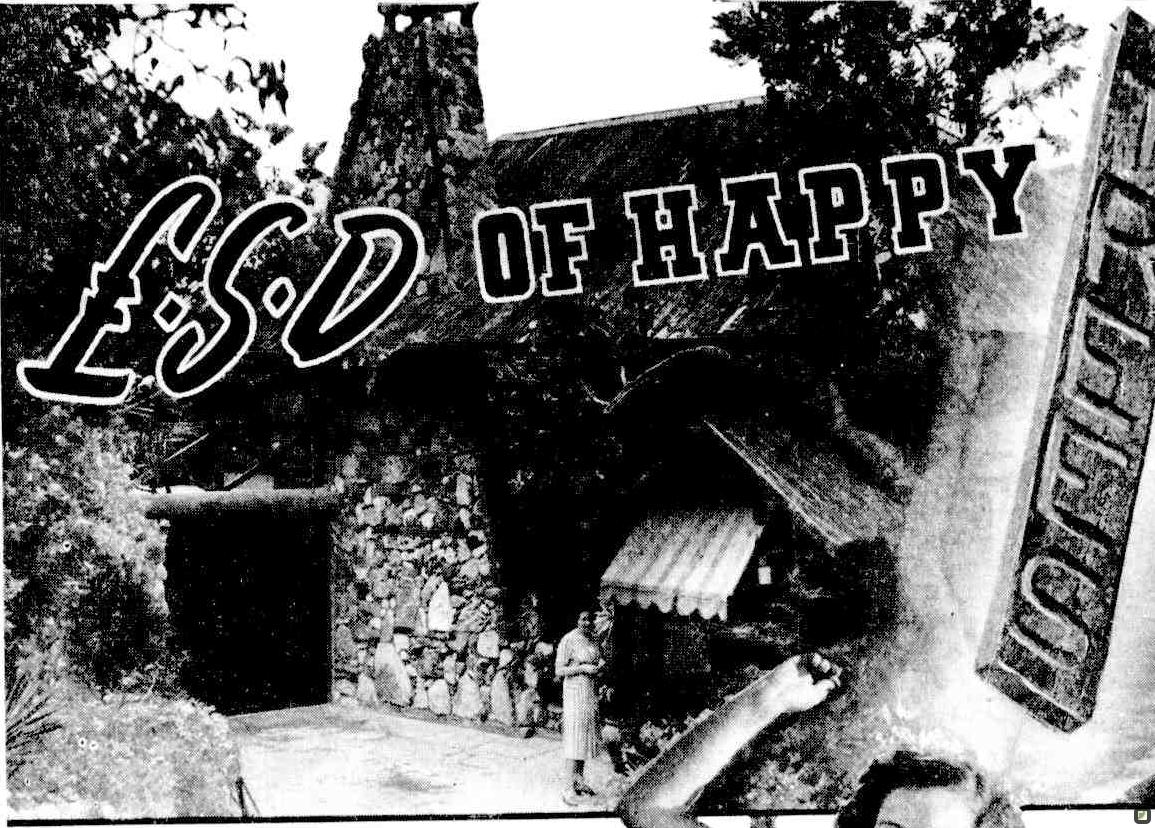
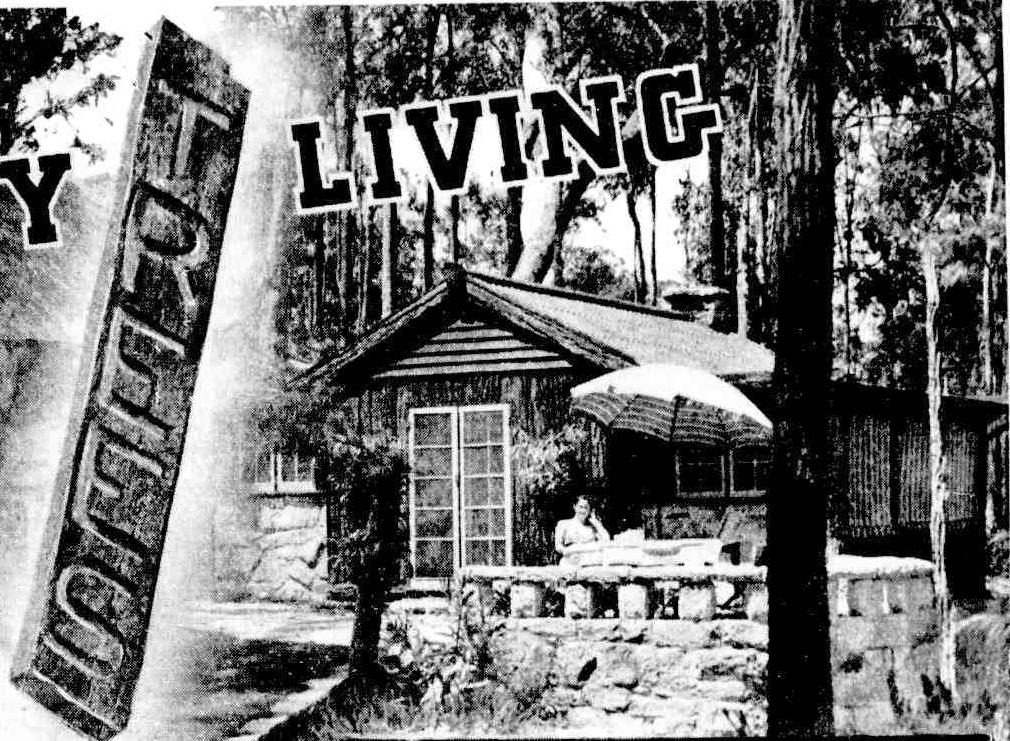
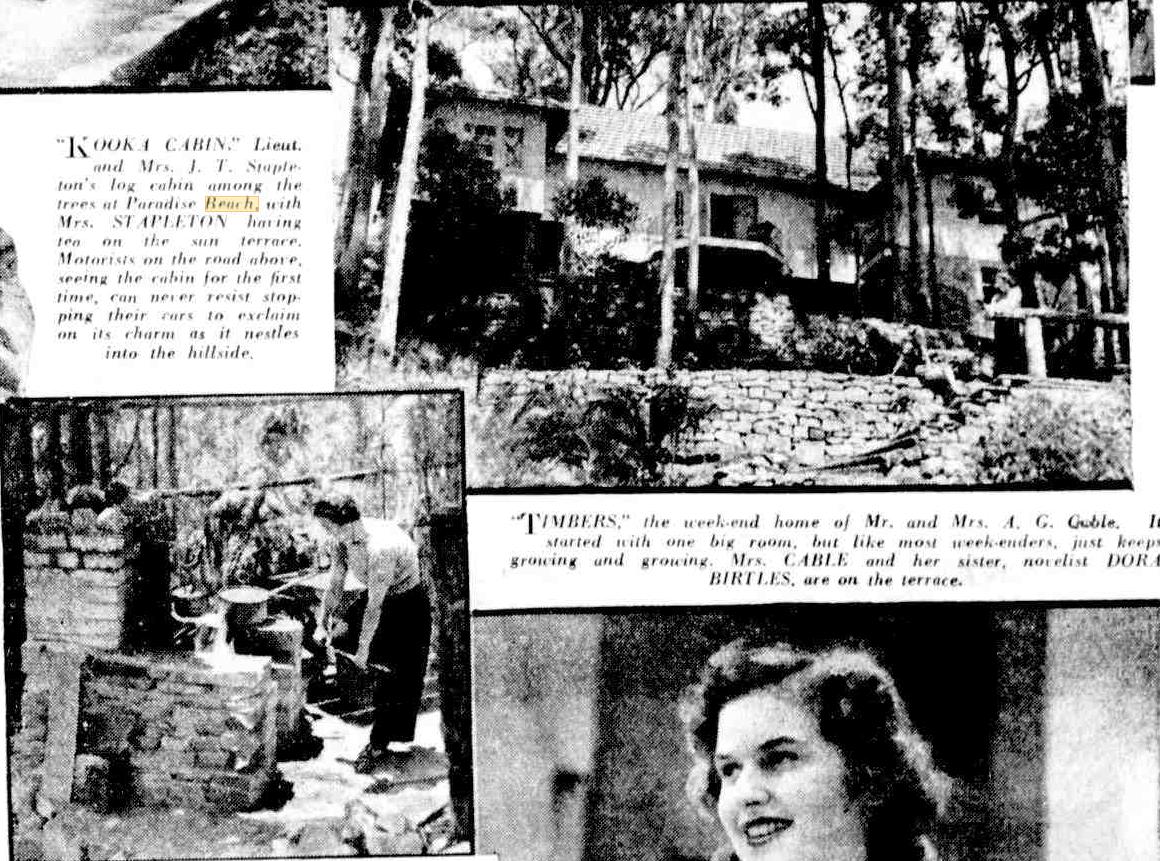
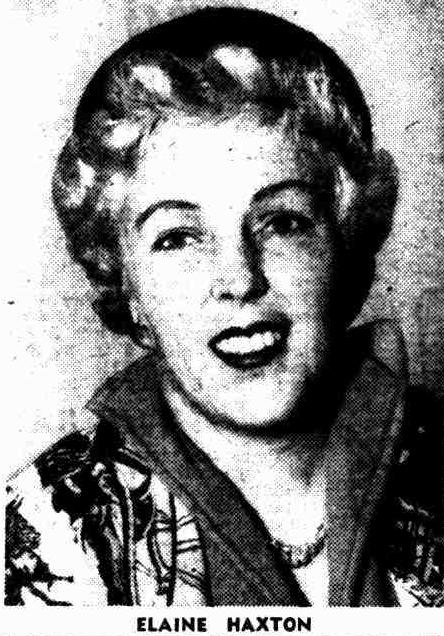 Although Miss Haxton is fond of dogs she has no pet to tie her to her home. She has always travelled wherever she wished and likes to combine her painting trips with the thrill of seeing new countries. Her most recent trip was to Italy, where she found both the art and the people "exciting." Other favorite countries are Mexico, which she visited not long ago, France and England. She has lived in New York and has painted in most parts of the world. Her work Is hung in the National Galleries both in Sydney and Melbourne, at the Metropolitan Museum in New York and in private collections in England, the United States and Italy.
Although Miss Haxton is fond of dogs she has no pet to tie her to her home. She has always travelled wherever she wished and likes to combine her painting trips with the thrill of seeing new countries. Her most recent trip was to Italy, where she found both the art and the people "exciting." Other favorite countries are Mexico, which she visited not long ago, France and England. She has lived in New York and has painted in most parts of the world. Her work Is hung in the National Galleries both in Sydney and Melbourne, at the Metropolitan Museum in New York and in private collections in England, the United States and Italy. 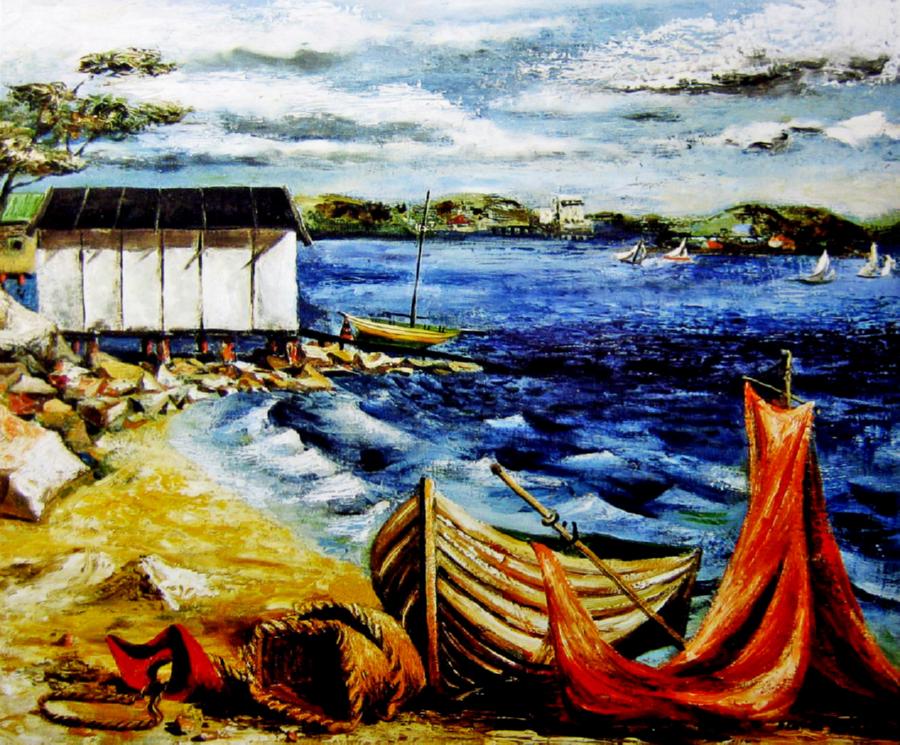
Pittwater, 1949 Oil on board, 50 x 60 cm - Visit previous page on Elaine Haxton HERE 1950 Wynne Finalist for Elaine Haxton - King Tide - showing Torpedo Wharf and Building
THIS DREAM CAME TRUE
IN A SYLVAN SETTING: High on the hill overlooking Pittwoter at Clareville, this lovely timbered house is set amid tall gum trees. On the morning that these pictures were taken a baby koala was asleep in the fork of one of the highest gum trees in the picture.
.jpg?timestamp=1553650880359)
LIKE most country folk who have spent long years of their lives out in the hot, dry north-west, M r. and Mrs. A. E. Brown, whose station home was at Collarenebri, dreamed, when they thought of retirement, of sparkling water dancing on a sunlit bay, of the cool, deep green of tall gum trees and lots of undergrowth; of a lovely garden where there was always plenty of water in the taps, and where there was never a flood to cover everything with that sticky grey-red film of mud.
The Dream
They used to plan, during drought years and flood times on their station property, when the sheep either died for lack of water or were swept away when the Barwon flooded for miles on those flat, open plains, of the wonderful time they would have when they found their dream-home; when the things they fought so hard to acquire on the land would come on a silver salver, so to speak, in the near city suburbs and when there was no "plant" on which electricity for the house and shearing machines . depended, but just a switch on the wall, which never failed for want of fuel — excepting, of course, during blackout spells.
But, of course, they never, in their wildest dreams, expected to find this dream-home for their retirement — and certainly not on the Saturday afternoon on which the agent took them through a shady road from Avalon, to the foreshores of Pittwater, just at the spot on the bay called Clareville.
The Reality
There were the trees —the tall, blessed gums bedded deep in damp leaf mould and growing tall and straight on the steep hills sloping down to the sea.
There were the sparkling waters, glimpsed through the trees at intervals as the car climbed a steep little ascent and left the surface behind, wandering off round the side of the hill, no more than a sandy track.
"This is lovely," they told each other, "but there'll be nothing for us here — there just couldn't be."
But just to prove that dreams sometimes do come true—there, where the road ended in a wide circular sweep of sand and rock —was the house of their dreams.
There it was — a timbered house looking like a log cabin as they glimpsed it through the arching fronds of a small banana grove — varnished like bamboo canes, and with its green tiled roof blending in perfectly with the timbered slope on which it stood.
.jpg?timestamp=1553650917960)
THROUGH AN ARCH OF BANANAS: Another enchanting view of this charming home with Mrs. Brown sitting on the porch, which is protected from the sun by striped green and orange awnings.
.jpg?timestamp=1553650949043)
TWO VIEWS of the interior of the living room. Mrs. A. E. Brown sits with her work basket in a comfortable chair by the fireplace in tho living room. Walls are a cool, pearl grey, carpeting in muted tones of green, and a natural brick fireplace and ovormaniet is linked up with bookcases. (Left): No unnecessary walls divide the little study from the living room. This opens out onto the sundeck beyond and through tho doorway a glimpse of the dining alcove can be seen. By the clever use of giants panels and mirrors, the illusion of great space Is obtained in the interior of this charming house.
And there beyond it, dancing and glistening- in. the afternoon sun, was the bay, with white sails dipping to the breeze as small craft skimmed over its surface, and faintly on the beach below, came the voices of children as they played on the golden sands.
"But this is not for sale?" they asked, incredulous, disbelieving.
"Walk in, walk out," the agent told them.
And that's just what it was— one of those incredible things that happen once in a blue moon.
Digging in
And for the past five months, the far north-westers, happy as a couple of sandboys in their wonderful "find," have been digging in with both feet—and their hands, too — snugging down into the prettiest little house on the bay, just big enough to hold all their treasures, just small enough to be managed without help — just near enough to the city to be within easy reach of a day's shopping — just far enough away to be able to forget there ever was such a place as Sydney.
Until the last annual conference, Mrs. Brown was State honorary secretary of the Country Women's Association.
She thought she was going to miss it badly, but ever since they moved into the new house, she has scarcely had time to come up to the city; and when she does it's always with an anxious eye on the clock, to haste back again to her bayside, bushland retreat.
And always, there is an armload of plants to be carried to the car, and hours of fun and planning and planting the next day where the precious slips and bulbs are lovingly placed in their new surroundings.
Already, though they have been in it less than six months, the garden is a blaze of color; paths that were bordered with bottles, upended, are now laid out, paved with stone and bordered with rockeries; lawns have been terraced, flower-beds built up to hold the moisture, unwanted stuff dragged ruthlessly out, new shrubs carefully chosen with an eye to their ultimate part in the general landscape scheme, planted and tended until they take hold on that steep hillside.
Piece de resistance in this enchanting garden is the picnic piazza (not to be confused with a barbecue, if you please.) This paved courtyard certainly contains all the necessary ingredients for the preparation of outdoor meals — an open fireplace in one corner, with a grilling grid; stone stools for which Mrs. Brown has made attractive cushions, a stone table shaded with a gay umbrella awning arid a bird-bath where kingfishers and kookaburras, magpies and peewits call regularly every morning and evening for their drink; and a lovely view of the bay through the spreading gums overhead.
Here, on the sundeck facing the bay, if one lies fairly quiet on one of the cane lounges, it is possible to see the koalas descending from the trees and ambling up the garden paths on their way to higher ground further up the hill.
Inside, the house could scarcely be more attractive than it is. One large living-room has been divided with low-walled divisions into a study alcove (this separated from the main room by a built-in china cabinet) , a cocktail bar; which once contained the stairwell leading down to the small self-contained . flat on the lower level; and, beyond, divided by a glass partition from waist-high level, the dining alcove which adjoins the tiny, compact kitchen, where everything is built-in and tucked away in handy cupboards.
Electric stove,and refrigeration bring every, convenience right to the seaside, and the kitchen opens back onto the .front piazza, roofless, but sheltered against glare with, gay striped awnings in tangerine and green striped canvas.
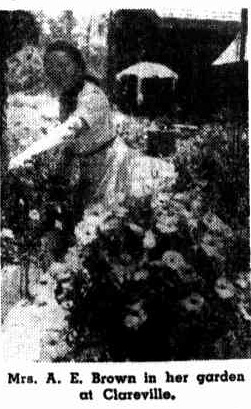
Mrs. A. E. Brown in her garden at Clareville.
Walls inside have been painted in flat oil in a cool shade of pearl grey, and the artistry of Mrs. Brown is evident in curtains, coverings, rugs, .and in the placement of every treasured piece of ornament, brass and copper in a room; planned for comfort and relaxation.
"Of course, we're not finished yet—there is still ever so much to be , done." Mrs. Brown will tell you when you visit "Wirrabilla"—the name that has been transferred from Collarenebri ,to Avalon and means "little white butterflies."
And, of course, they're not finished—for the work and the interest and the fun they're having will last a lifetime while ever there's gardening to be done.
For that's a way we have in retirement — we leave off work to carry bricks, not to mention stones. -V.H. THIS DREAM CAME TRUE (1952, January 4). The Land (Sydney, NSW : 1911 - 1954), p. 19. Retrieved from http://nla.gov.au/nla.news-article105986223
References And Extras
- TROVE - National Library of Australia
- Shelagh Champion OAM and George Champion OAM, in their Profiles of the Pioneers in Manly, Warringah and Pittwater (1996 - revised 2013)
- Archpriest John Joseph Therry
- John Collins of Avalon - Pittwater Patriarchs Series I
- Maria Louisa Therry - Pittwater Matriarchs Series I
- Careel Bay Steamer Wharf And Boatshed
- The Mulhalls Of Broken Bay And Barrenjoey - Australian Champions
- Light Keepers of Barrenjoey Lightstation
- Captain Francis Hixson
- The Collaroy Paddle Steamer: New Ephemera Added To Public Accesible Records - Her Connections To Pittwater
- Albert Thomas Black
- John Black
- Pittwater Reserves, The Green Ways: Clareville Wharf and Taylor's Point Jetty
- Early Pittwater Paddlers, Oarsmen, Rowers And Scullers: The Green Family
- Early Pittwater Paddlers, Oarsmen, Rowers And Scullers: The Fox Family
- Early Pittwater Paddlers, Oarsmen, Rowers And Scullers: The Paddon Family Of Clareville (Or Clairville)
- Hy-Brasil: Avalon Beach - Pittwater's Summer Houses
- Pittwater's Torpedo Wharf And Range
- The Roads And Tracks Of Yesterday: How The Avalon Beach Subdivisions Changed The Green Valley Tracks
- Roads In Pittwater: The Barrenjoey Road
Also Available:
- Pittwater Roads II: Where the Streets Have Your name - Scotland Island
- Pittwater Roads II: Where the Streets Have Your Name - Newport Beach
- Roads In Pittwater: The Bay View Road
- Motor Car Tours To And In Pittwater Show Us The Way This Place Once Was
- Roads To Pittwater: The Wakehurst Parkway Along Old Oxford Falls Track
- Roads To Pittwater: The Pittwater Road
- Roads To Pittwater: The Sandspit Punt and Spit Bridge
- Roads To Pittwater: The Mona Vale Road
- My Holiday by Charles de Boos – 1861
PITTWATER.
VALUABLE AGRICULTURAL & GRAZING ESTATE.
in area about
2000 ACRES.
Subdivided into
FARMS.
SUBURBAN BLOCKS,
and
VILLA SITES,
as per Lithographs.
It is bounded on the east by the PACIFIC OCEAN, on the west by the BEAUTIFUL Bay of PITTWATER, on the SOUTH partly
by a GOVERNMENT RESERVE and FARRELL'S FARM, and on the north by the BASSETT DARLEY PROPERTY.
The Estate, as regards quality of soil, is equal to any other in this rapidly improving and truly attractive district.
It is 11 miles distant by a good road from the PIER at MANLY BEACH, and only 2 miles from Custom-house Station at BARRENJOEY.
Also,
THE UNSOLD PORTIONS OF THE TOWN OF BRIGHTON.
RICHARDSON and WRENCH have received Instructions to sell by public auction, at the Rooms, Pitt street, Sydney, on
MONDAY, 3rd May, at 11 o'clock,
THE PITTWATER ESTATE,
subdivided as follows : —
NORTH DIVISION.
FIVE CHOICE FARMS.
No. I., area 101a. lr. 22p.
II., ditto 76a. 2r. 30p.
III., ditto 128a. lr. 34p.
IV., ditto 65a. Or. 32p.
Each of these have frontages to the Pacific Ocean and the main road to Barrenjoey.
On Lot III. is the Homestead and Residence now in the occupation JOHN COLLINS, Esq., and also the Celebrated Cave.
No. V., area 61a, 3r. 32p., has frontage to the Central Road which passes from the coast-line to Pitt, water, crossing the main road at the Recreation Reserve.
Nos. 1 to 21 are SUBURBAN BLOCKS and VILLA SITES, surrounding the TOWNSHIP of BRIGHTON, in areas from 2 ACRES 3 ROODS 35 PERCHES, to 18 ACRES 3 ROODS 3 PERCHES, having frontages to MAIN PITTWATER ROAD and other ROADS and STREET all one chain wide.
No. 22, a Farm of 38a. 3r. 37p. on the CENTRAL ROAD, about midway between PITTWATER and the OCEAN.
SOUTH DIVISION.
No. I., area 63a 3r. lDp. fronting the coast and the main road. On this lot is the COAL BORE, 400 FEET DEEP.
Nos. II., III., IV., and V. — 4 FARMS, areas from 63 ACRES 3 ROODS 38 PERCHES to 101 ACRES 3 ROODS 37 PERCHES, having frontages to the MAIN PITTWATER ROAD, the CENTRAL ROAD, and OTHER ROADS.
Nos. 1 to 8, and Nos. Ia to 8a. — 16 CHOICE VILLA SITES in PITTWATER fronting LONG BEACH; areas from 4 ACRES 2 ROODS 8 PERCHES to 17 ACRES 27 PERCHES.
Nos. 9 to 15, — 7 Small FARMS in REFUGE COVE, SOUTH BEACH and SALT-PAN COVE, PITTWATER ; areas, from 9 ACRES 2 ROODS 2 PERCHES to 25 ACRES 1 ROOD 6 PERCHES.
16 to 25. — 10 Small FARMS in CABBAGE-TREE VALE, on BILGOLA BEACH. Areas from 5 ACRES 2 ROODS 36 PERCHES to
21 ACRES 1 ROOD.
No. 26. — A Small FARM fronting the RECREATION RESERVE on OCEAN BEACH. Area,12 ACRES 3 ROODS 8 PERCHES.
TOWN OF BRIGHTON.
THE WHOLE of tho UNSOLD LOTS of this TOWNSHIP. Areas from 1 ROOD to 1 ACRE, in CAREEL BAY, at the STEAMERS'
WHARF. - .
This subdivision is well worthy of attention, as there is not the shadow of a doubt that PITTWATER will become an important and attractive resort for our BUSINESS MEN requiring CHANGE, QUIET, and REST from tho buoy turmoil of the CITY
THE COMMUNICATION between the city and Pittwater is now more frequent than formerly. Besides having the COACH DAILY
from MANLY BEACH, there are now COMMODIOUS STEAMERS PLYING REGULARLY three days per week, viz., TUESDAY, THURSDAY, and SATURDAY, FROM THE CIRCULAR QUAY, at a quarter-past 7 a.m.
NOTE THE LIBERAL TERMS:
ONE QUARTER CASH DEPOSIT, and the residue in '3 years from day or' sale, interest 6 percent, per annum, payable quarterly.
A large auction plan of the subdivision is now in course of completion, and will be for inspection in a few days, at the rooms, Pitt-street, and LITHOGRAPHS are now ready for distribution.
Messrs. ELLIS and MAKINSON, Elizabeth street, are solicitors of the vendors. A large sum of money has been voted by the Government to complete the main road, which passes through the above estate, from Manly to Careel Bay, at the town of Brighton Pittwater.
Advertising (1880, May 1). Freeman's Journal (Sydney, NSW : 1850 - 1932), p. 22. Retrieved from http://nla.gov.au/nla.news-article133485645

Circa 1880 Subdivision Map showing Clareville Sections and lots - courtesy State Library of NSW
Marine Village of Brighton - John St, William St, George St (the Parade), Joseph St, Therry St, Patrick St, Elizabeth St, Queen St, [1871].Item No: c05346004, courtesy State Library of NSW. - Map 1
Sections from (showing sales/owners) Marine Village of Brighton - John St, William St, George St (the Parade), Joseph St, Therry St, Patrick St, Elizabeth St, Queen St, [1871]. Item No: c053460043, courtesy State Library of NSW. Map 2
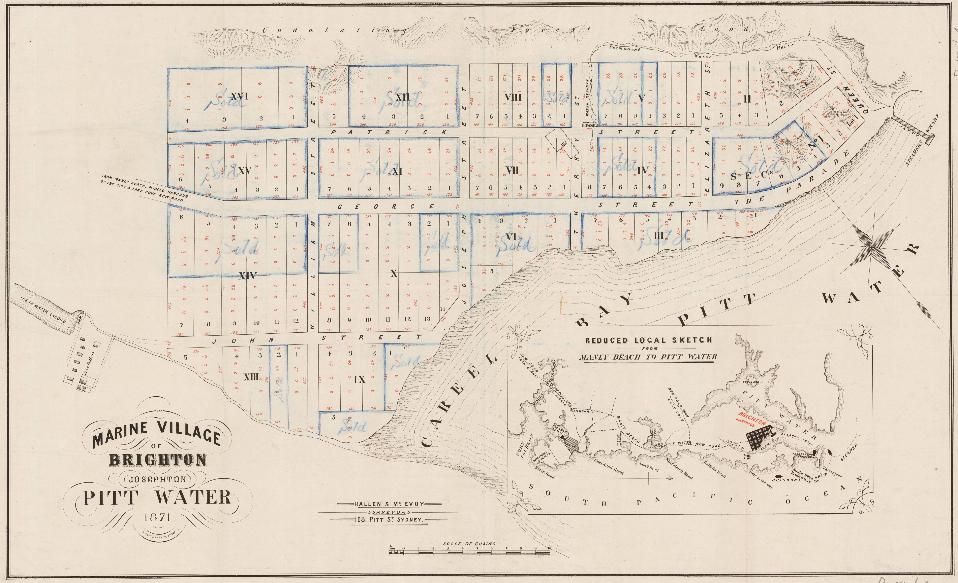
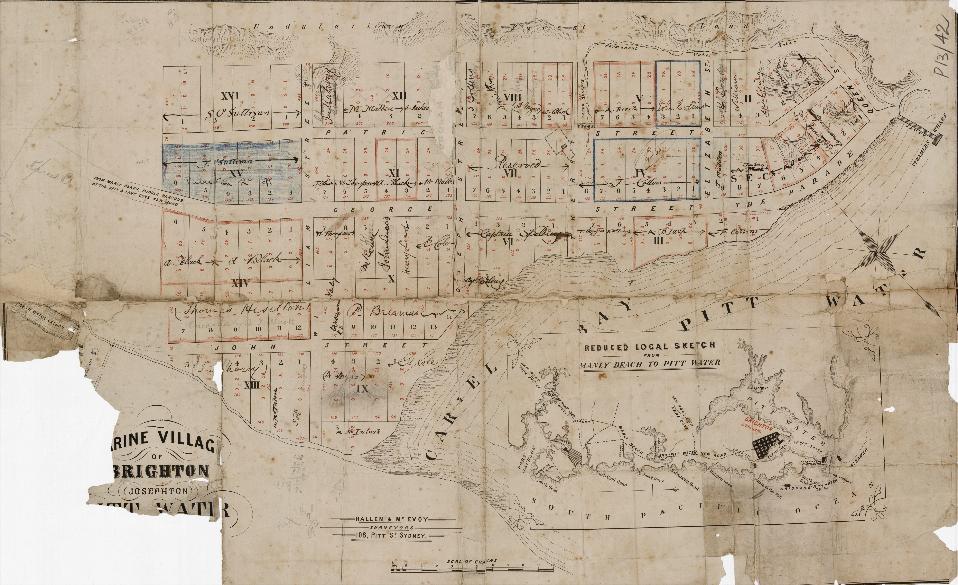
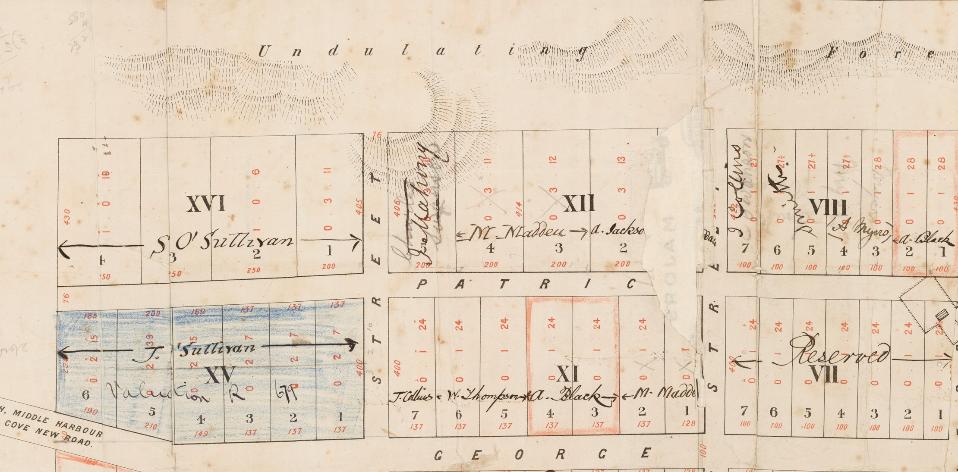
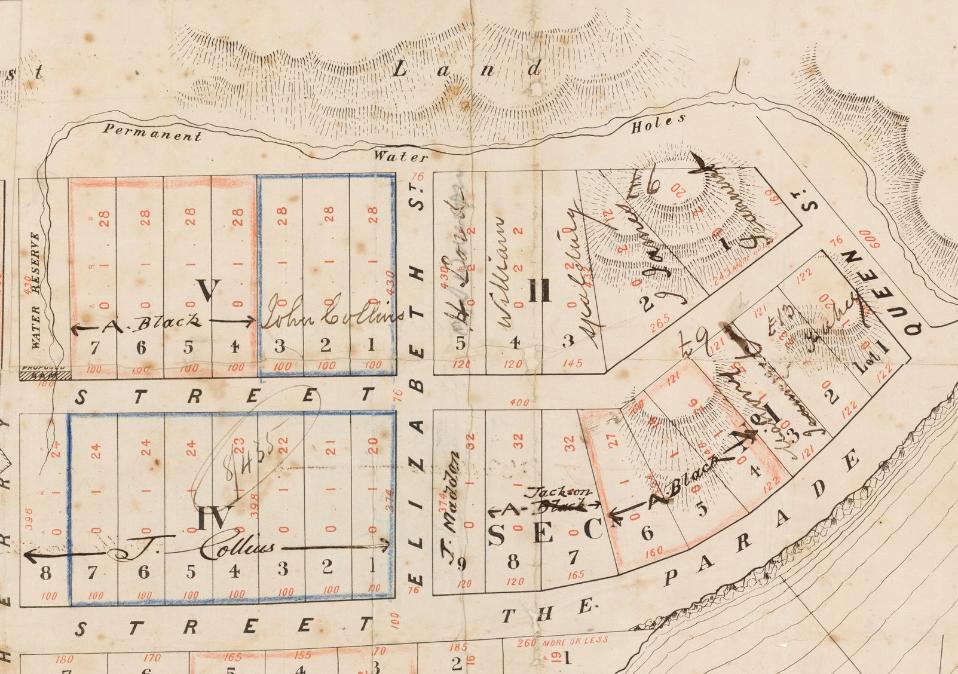
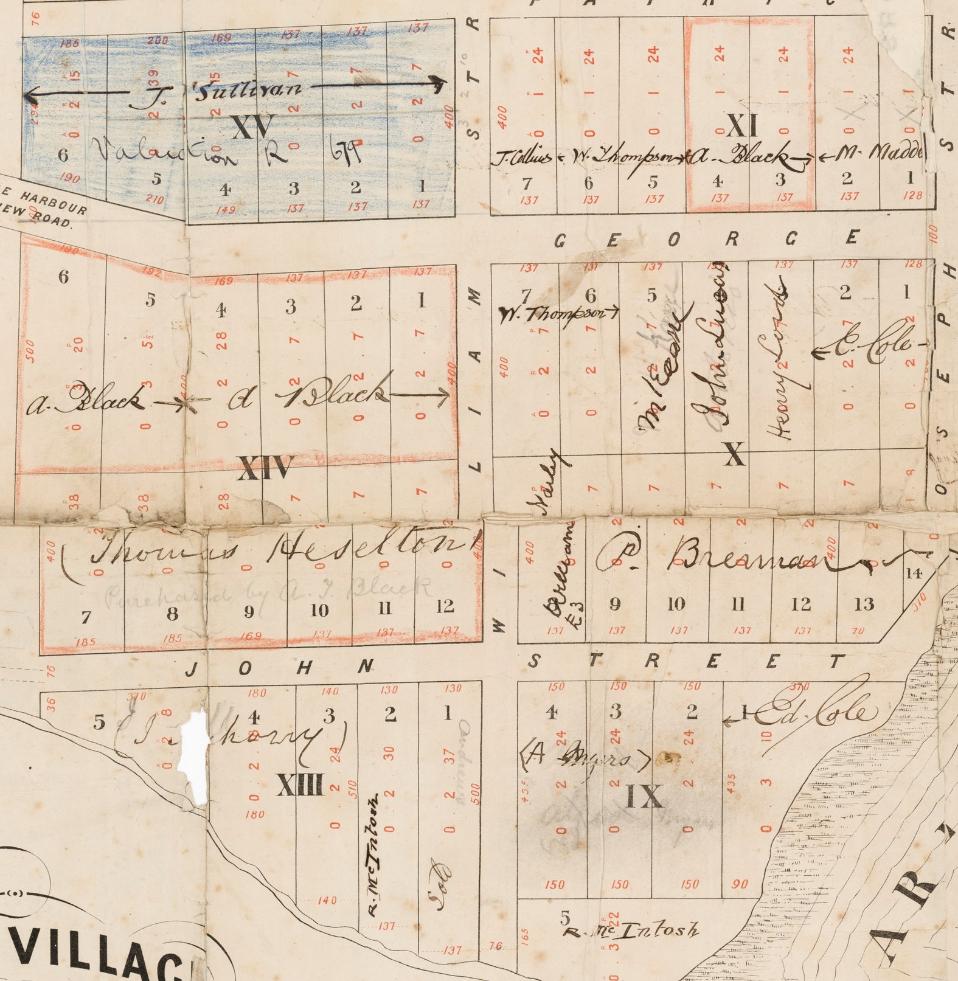
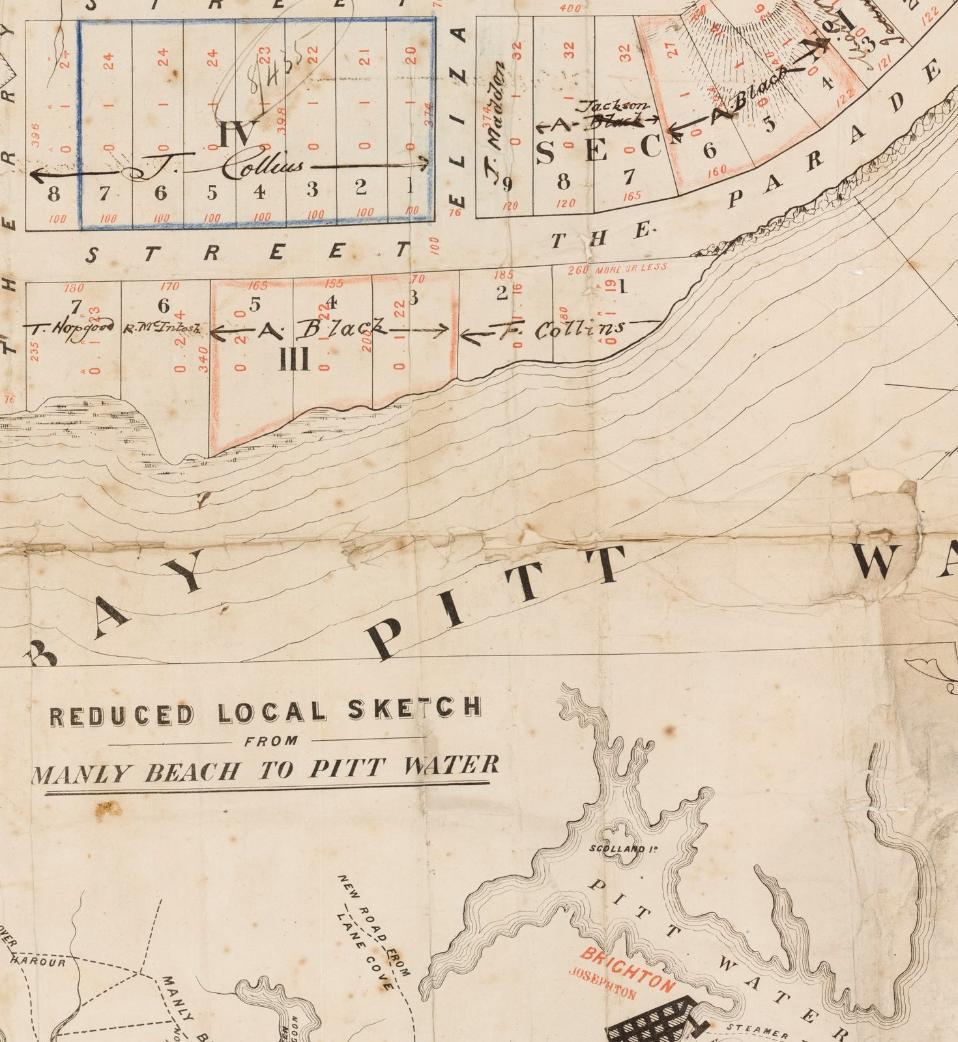
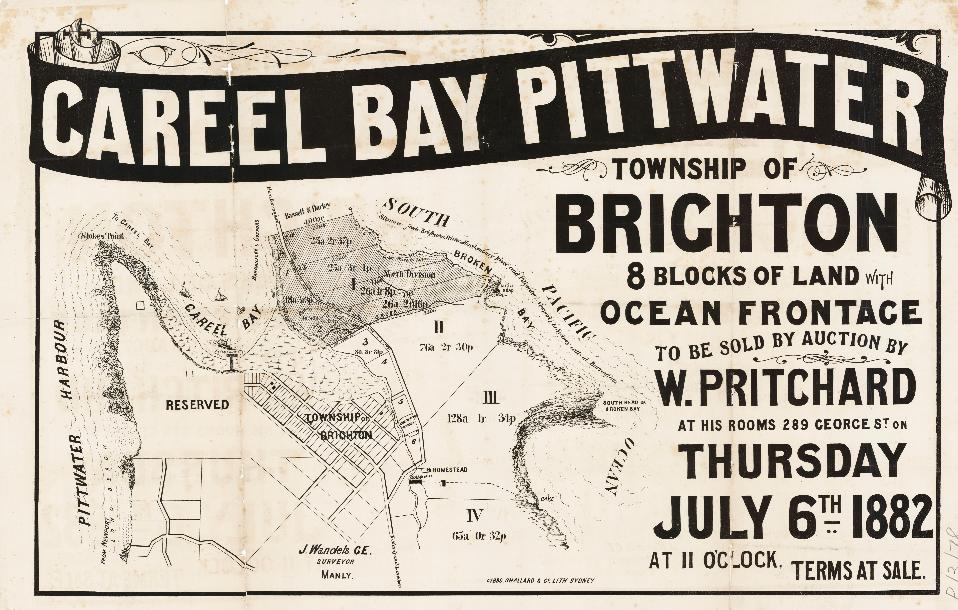
Careel Bay Pittwater - No boundaries shown, 1882. Item No: c053460084, courtesy State Library of NSW.
Moving Those Acreage Lands Into Saleable Lots Under The Real Property Act:
A few of the 'lots' (Sections) of portion 20 being brought under the Real Estate Act - refer to Sections map above:
No. 13,259. County of Cumberland, parish of Narrabeen, 101 acres 1 rood 381 perches, situated on Clareville Wharf Road, Clareville,—is Block No. 3, South Subdivision, Pittwater Estate, and is part of 1,200 acres (portion No. 20 of parish) granted to John Joseph Therry; adjoining the properties of F. Burne, J. Robertson, S. Smith, and G. A. Smith, Trustees of Mrs. Evans, or J. G. Cousins, G. Holland, The London Bank of Australia, and J. H. Parry. – Applicant: Margaret Allan, Mosman. Day until which Caveats may be lodged: 17th February, 1905. NOTICE UNDER REAL PROPERTY ACT. (1904, December 30). Government Gazette of the State of New South Wales (Sydney, NSW : 1901 - 2001), p. 9437. Retrieved from http://nla.gov.au/nla.news-article226488010
NOTICE UNDER REAL PROPERTY ACT
APPLICATIONS have been made to bring the lands hereunder described under the provisions of the Real Property Act, Certificates of Indefeasible Title will issue, unless Caveats be lodged in accordance with the Third Schedule to the said Act ON OR BEFORE THE 6th JANUARY 1909: -
No 15,531 APPLICANT Frank Henry Burt, Sydney LAND -County Cumberland, parish Narrabeen, shire Warringah, 18 acres 1 rood 20 perches, at Pitt Water, lot 18, villa sites. Pitt Water Estate, and part 1200 acres (portion 20 of parish) granted to John Joseph Therry, adjoining properties of A E Wickham and W H Holt Advertising (1908, December 12). The Sydney Morning Herald (NSW : 1842 - 1954), p. 6. Retrieved from http://nla.gov.au/nla.news-article28149677
No. 17 749. APPLICANT:—Frederick Burne, Forest Lodge. _ LAND:—County Cumberland, parish Narrabeen, shire Warringah, 61 acres 13 perches, on road from Manly to Barranjoey and Central-road, Pittwater,—lot 2, south division, Pittwater Estate, and part 1,200 acres (portion 20 of parish), granted to John Joseph Therry; adjoining properties of City Mutual Insurance Society and executors of late J. Tomkins. NOTICE UNDER REAL PROPERTY ACT. (1912, June 12). Government Gazette of the State of New South Wales (Sydney, NSW : 1901 - 2001), p. 3669. Retrieved from http://nla.gov.au/nla.news-article221608291
No. 18,217/ APPLICANTS:—John George Cousins, Amess Bissett Coleman, and Thomas Hardy, all Sydney. LAND: —County Cumberland, parish Narrabeen, shire Warringah, 96 acres 3 roods, on the road from Manly to Barrenjoey, being Block IV, South Division, Pittwater Estate, and part 1,200 acres (portion 20, parish), granted to John Joseph Therry; adjoining properties of F. Burne, estate late John Tomkins and A. Bowen, G. Crowley, and J M. Taylor. NOTICE UNDER REAL PROPERTY ACT. (1913, June 25). Government Gazette of the State of New South Wales (Sydney, NSW : 1901 - 2001), p. 3845. Retrieved from http://nla.gov.au/nla.news-article221596335
No. 18,923. APPLICANT: James McKinlay, Marrickville. LAND: County Cumberland, parish Narrabeen, shire Warringah, 8 acres 1 rood 12 1/2 perches, on Pittwater. near Refuge Cove,—part lot 11, Villa Sites Pittwater Estate, and is part 1.200 acres (portion 20, parish), granted to John Joseph Therry ; adjoining properties of A. E. Wickham and — Kilminster. Diagrams delineating these lands may be inspected at the land Titles Office, Sydney.
W. G. H-WILLIAMS,
Registrar-General.
10th December, 1913. NOTICE UNDER REAL PROPERTY ACT. (1913, December 10). Government Gazette of the State of New South Wales (Sydney, NSW : 1901 - 2001), p. 7336. Retrieved from http://nla.gov.au/nla.news-article228061585
No. 18,867. APPLICANT:—Mackenzie, Goulding, & Co., Limited. LAND:—County Cumberland, parish Narrabeen, shire Warringah, 10 acres 1 rood, 38 ½ perches, in William-street,,—lots 17 and 13 north division, Pittwater Estate, and part 1,200 ares (portion 20, parish), granted to John Joseph Therry. NOTICE UNDER REAL PROPERTY ACT. (1914, January 21). Government Gazette of the State of New South Wales (Sydney, NSW : 1901 - 2001), p. 316. Retrieved from http://nla.gov.au/nla.news-article228096801
No. 18.843. APPLICANTS:—Louisa Little, Wallendbeen, Henry John Little, and William Augustus Little, both Sydney. LAND:—County Cumberland, parish Narrabeen, shire Warringah, 27 acres 3 perches, at Pittwater.—lots 5, G, 7, and 8, villa sites, in the Pittwater Estate, and part 1200 acres (portion 20, parish), granted to John Joseph Therry; adjoining properties of P. A. Temple, A. Robinson, W. Robinson. J.D. Fletcher, J. Smith, and J. Gregg. NOTICE UNDER REAL PROPERTY ACT. (1914, May 27). Government Gazette of the State of New South Wales (Sydney, NSW : 1901 - 2001), p. 3104. Retrieved from http://nla.gov.au/nla.news-article226768146
No. 19,362. APPLICANT: —John Henry Parry, London. LAND:—County Cumberland, parish Narrabeen, shire Warringah. 2 acres 1 rood 15 1/2 perches, 3 roods perches, 2 roods 24i porches, and 14 acres 1 rood 29 perches, in William, John, and Patrick streets and Central-road.—lots 3, 4, and 5, section 13. lot 5, section 12, lot 2, section 9, Marine village of Brighton "Josephton," Pittwater, and lots 5a and 6a, villa sites in Pittwater Estate, and parts 1,200 acres (portion 20, parish), granted to John Joseph Therry; adjoining properties of estate late R. Mcintosh, Mrs. Madden, E. Cole, J. T. Taylor. London Bank of Australia Ltd., G. Crowley, J. M. Taylor, and A. J. Small. NOTICE UNDER REAL PROPERTY ACT. (1914, September 9). Government Gazette of the State of New South Wales (Sydney, NSW : 1901 - 2001), p. 5456. Retrieved from http://nla.gov.au/nla.news-article228098990
No. 18,395. APPLICANT :—John Stevenson, Gladesville. LAND:—-County Cumberland, parish Narrabeen, shire Warringah, 26 acres 5 perches, on Bilgola Creek and road leading to road from Manly to Barrenjoey,—lot 19, and part lot'18, South Division, Pittwater Estate, and part 1.200 acres (portion 20, parish), granted to John Joseph Therry; adjoining properties of W. J. Hollins, C. W. B. King, — Humphrey, and Crown Land. NOTICE UNDER REAL PROPERTY ACT. (1914, December 9). Government Gazette of the State of New South Wales (Sydney, NSW : 1901 - 2001), p. 7291. Retrieved from http://nla.gov.au/nla.news-article227425078
No. 18,259. APPLICANTS:—Harley Usill Mackenzie and John George Cousins, both of Sydney. LAND:—County Cumberland, parish Narrabeen, shire Warringah, 161 acres 1 rood 16 perches, on road from Manly to Barren joey and Careel Creek, at South Head of Broken Bay and Hole-in-Wall on South Pacific Ocean,—lots 3 and 4, North .Division, Pittwater Estate, also part 280 acres (portion 49, parish), and 1,200 acres (portion 20, parish), granted to Reverend John Joseph Therry; adjoining properties of H. R. Nolan, E. Darvall, F. M. Callaghan, estate late J. Lucas, Warringah Shire Council, and applicants. NOTICE UNDER REAL PROPERTY ACT. (1914, December 16). Government Gazette of the State of New South Wales (Sydney, NSW : 1901 - 2001), p. 7405. Retrieved from http://nla.gov.au/nla.news-article227425339
No. 20,282. APPLICANTS:—Percy Charles Lucas, Ingleburn; John Hector Lucas, Five Dock; and Edgar Lucas, Waverley.LAND:—County Cumberland, parish Narrabeen; shire Warringah, 12 acres 12 perches, on road from Manly to Barren joey, and on Central-road,—lots 10 and 11, North Division, Pittwater Estate, and part 1,200 acres (portion 20, parish), granted to John Joseph Therry; adjoining properties of Mrs. E. Darval, E. M. Callaghan, and Careel Ocean Beach Estate, Limited. NOTICE UNDER REAL PROPERTY ACT. (1916, December 29). Government Gazette of the State of New South Wales (Sydney, NSW : 1901 - 2001), p. 7818. Retrieved from http://nla.gov.au/nla.news-article225966054
No. 29636 Katherine Mary Roche 6 a. 38 ½ p. pts. sees. 4 and 5 and lot 7 sec. 8 Brighton Village Est. and lot 8 sec. E. Stokers Point Est. George, Therry, Patrick, Elizabeth, Queen's and Joseph Sts. Pittwater. REAL PROPERTY ACT NOTICES. (1949, July 1). Government Gazette of the State of New South Wales (Sydney, NSW : 1901 - 2001), p. 1851. Retrieved from http://nla.gov.au/nla.news-article224754756
No. 36,092. Louis Forster, 2 a. 2 r. 20 p., lots 1 to 5 incl., sec. VI, village of Brighton, in George, Joseph and Therry sts., and on Careel Bay, Pittwater. NOTICE UNDER REAL PROPERTY ACT. (1947, May 16). Government Gazette of the State of New South Wales (Sydney, NSW : 1901 - 2001), p. 1152. Retrieved from http://nla.gov.au/nla.news-article224768760
No. 42754 Avalon Heights Estate Pty. Limited 3 ac. 14 per. part of lot V North Division of the Pittwater Est. in the vicinity of Therry and Riviera Sts. Avalon. REAL PROPERTY ACT NOTICE (1963, July 26). Government Gazette of the State of New South Wales (Sydney, NSW : 1901 - 2001), p. 2141. Retrieved from http://nla.gov.au/nla.news-article220334894
The 'A. Black' shown as an owner/purchaser above is Albert Thomas Black (1840 - 1890), of Barrenjoey Lighthouse. He also bought land on the opposite side of the Pittwater estuary which was bequeathed to his wife and daughters, where the 'Little's' also are shown to have holdings. Interestingly a relative of his is still in Pittwater in John Black, who also gallivanted at Clareville as a youngster and along with wife and author Frances, are still firm supporters and volunteers of the Avalon Sailing Club (ASC) and the Bayview Yacht racing Association (BYRA):
Albert Thomas Black, courtesy John Black, great grandson of A T Black.
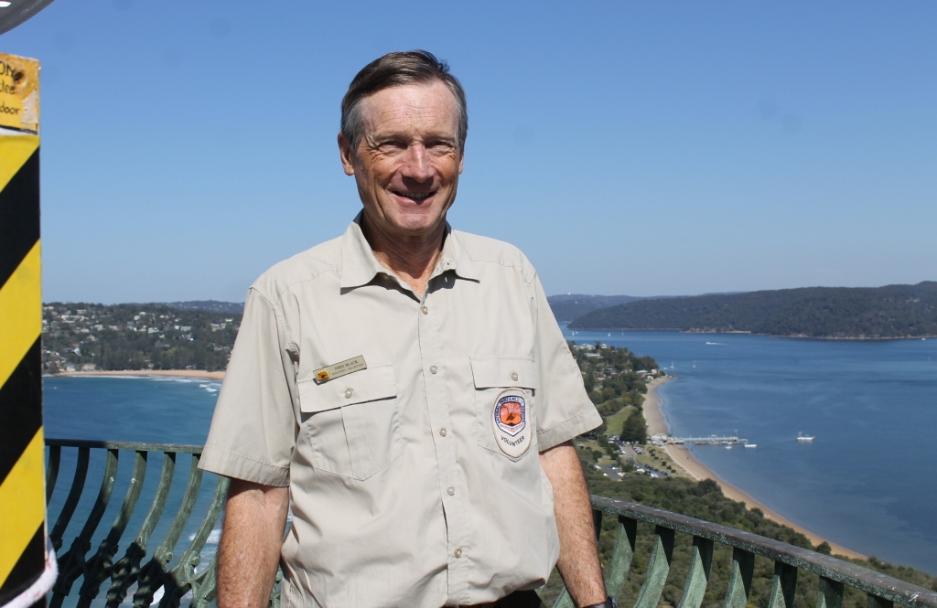
John Black, also a volunteer member of the Chase Alive team, at Barrenjoey Lighthouse during International Lighthouse Lightship Weekend- 2013 at Barrenjoey. Picture by A J Guesdon.
Primary Application - Ada Louisa Ethel Black & Mabel Daisy Black Bay View Road Pittwater Shire Warringah Parish Narrabeen Volume 2284 Folio 1 Date range: 30/08/1911 to 20/08/1912 and Primary Application - Mabel Daisy Black 8 acres 26 perches at Pittwater on Bay View Road & road 50 links wide in Shire Warringah Parish Narrabeen County Cumberland Volume 2524 Folio 81, Date range:24/03/1914 to 17/10/1914 – daughters of Albert Thomas Black of Barrenjoey Lighthouse
No. 17,898. APPLICANTS:—Ada Louisa Ethel Black, Auckland, New Zealand, and Mabel Daisy Black, Annandale. LAND: —County Cumberland, parish Narrabeen, shire Warringah, 18 acres 2 roods 244 perches, on Bay View road, at Pittwater,—part 40 acres (portion 43 of parish"), granted to George Weller; adjoining properties of D. Millar, A. M. Simpson, and J. Ware. NOTICE UNDER REAL PROPERTY ACT. (1912, April 10). Government Gazette of the State of New South Wales (Sydney, NSW : 1901 - 2001), p. 2230. Retrieved from http://nla.gov.au/nla.news-article227591158
Henry John Little
Property. No. 11,191. County of Cumberland, parish of Narrabeen, 14 acres 2 roods 22 perches at Pittwater, adjoining the property of Mrs. Black,— is part of 40 acres granted to George Weller ... Applicants: Louisa Little (Residence: Homebush), William Augustus J Phillips (Residence: Moonee Ponds, Victoria), Henry John Little (Residence: Sydney), Mary Jane Hanslow (Residence: Ryde). Caveats may be lodged until 5 April, 1901. NOTICE UNDER REAL PROPERTY ACT. (1901, February 15). Government Gazette of the State of New South Wales (Sydney, NSW : 1901 - 2001), p. 1163. Retrieved from http://nla.gov.au/nla.news-article226375397
Mr. Henry Little's obituary lends insight into why he may have had Pittwater land holdings:
OBITUARY.
MR. H. J. LITTLE.
Mr. Henry John Little, formerly a managing director of Richardson and Wrench, Ltd., land agents, died yesterday, aged 73 years. He retired in March, 1927, after more than 50 years' continuous service, and went for a health trip abroad.
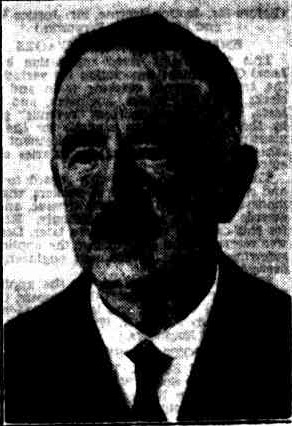
During his long service with Richardson and Wrench, Mr. Little kept his finger on the pulse of the land market. He saw values of city land jump from £35 to £1000 a foot, and land bought for £240 resold for £10,000. In the suburbs he saw land bought for 30/ a foot sold for from £20 to £100 a foot. He is survived by Mrs. Little and two sons, Messrs. Bruce Ure and Wilfred Little. The funeral will take place at Rookwood Cemetery to-morrow. OBITUARY. MR. H. J. LITTLE. (1936, August 19). The Sydney Morning Herald (NSW : 1842 - 1954), p. 12. Retrieved from http://nla.gov.au/nla.news-article17262046
In the Supreme Court of New South Wales.
PROBATE JURISDICTIONS
In the will of Henry John Little, late of Sydney, in the State of New South Wales, retired auctioneer, deceased.
PURSUANT to the Wills. Probate and Administration Act, 1898, the Testator's Family Maintenance and Guardianship of Infants Act, 1916, and the Trustee Act, 1925: Notice is hereby given that all creditors, widow, child, or children and other persons having any debts, claims or demands of what kind soever upon or affecting the estate of the abovenamed deceased, who died on or about the 18th day of August, 1936, and probate of whose will was granted by the Supreme Court of New South Wales, in its Probate Jurisdiction, on the 3rd day of February, 1937, to the Permanent Trustee Company of New South Wales and Wilfred de Cardi Little, the executors named in the said will, are hereby required to send in particulars of such debts, claims and demands to the said executors at 23-25 O'Connell-street, Sydney, on or before the 14th day of April next, at the expiration of which time the said executors will proceed to distribute the assets of the said deceased among the persons entitled thereto, having' regard to the debts, claims and demands only of which they shall then have had notice,* and the said executors will not be liable, for the assets so distributed to any person of whose debt, claim or demand they shall not have had notice at the time of such distribution.—Dated this 10th day of February, 1937.
For the Permanent Trustee Company of New South Wales Limited,
J. W. BARNES, Manager.
T. Michell and Gee, Proctors for Executors, 02 Pitt - street, Sydney. 23C8 £1 12s. PROBATE JURISDICTION. (1937, February 12). Government Gazette of the State of New South Wales (Sydney, NSW : 1901 - 2001), p. 743. Retrieved from http://nla.gov.au/nla.news-article224742409
NSW Births, Deaths, Marriage records Death record: LITTLE HENRY JOHN 13411/1936 parents - JOHN LOUISE CHATSWOOD
MARRIAGES.
LITTLE--PHILLIPS-On the 28th August, at Newtown, by the Rev. S. C. Kent, Mr. John Little, son of John Little, Esq., late of Balmain, to Louisa, only daughter of Henry Phillips, Esq., of Newtown. Family Notices (1861, August 31). The Sydney Morning Herald (NSW : 1842 - 1954), p. 1. Retrieved from http://nla.gov.au/nla.news-article13058203
Louisa was born in Sydney in 1842 to Henry and Mary Phillips.
On the 3rd instant, at her residence, Balmain, Mrs. John Little jun., of a son. Family Notices (1862, June 5). The Sydney Morning Herald (NSW : 1842 - 1954), p. 1. Retrieved from http://nla.gov.au/nla.news-article13229695 - Henry John
LITTLE—On the 11th August, at her residence, Balmain, Mrs. John Little, senior, of a daughter, surviving only about seven hours. Family Notices (1862, August 14). Empire (Sydney, NSW : 1850 - 1875), p. 1. Retrieved from http://nla.gov.au/nla.news-article60479561
Jane Watson Murray and John Little Snr. (his second marriage) married in 1855:
88/1855 V185588 46 LITTLE JOHN MURRAY JANE W
By special license, at Lower Fort-street, on the 23rd instant, by the Rev. Alexander Salmon, of the Free Church, Sydney, John Little, Esq , Balmain, to Jane Watson, daughter of the late Matthew Murray, Esq. of Glasgow. Family Notices (1855, April 24). The Sydney Morning Herald (NSW : 1842 - 1954), p. 8. Retrieved from http://nla.gov.au/nla.news-article12968501
LITTLE.-On Wednesday, 19th November, at his residence, Burwood, Mr. John Little, late of Balmain. Family Notices (1862, November 21). Empire (Sydney, NSW : 1850 - 1875), p. 1. Retrieved from http://nla.gov.au/nla.news-article60519245
At his residence, Burwood, on the 19th instant, after a long and protracted illness, which he bore with christian fortitude, patience and resignation, John Little, Esq., late of Balmain, in the fifty-eighth year of his age, the beloved father of Mrs. Wm. Johnston, Clarence Town. Family Notices (1862, November 25). The Maitland Mercury and Hunter River General Advertiser (NSW : 1843 - 1893), p. 1. Retrieved from http://nla.gov.au/nla.news-article18692149
LITTLE JOHN 2050/1862 Parents - GEORGE MARY death registered at - CONCORD
In the Supreme Court of New South Wales.
ECCLESIASTICAL JURISDICTION.
In the will of John Little, late of Balmain, near Sydney, in the Colony of New South Wales, land owner, deceased. NOTICE is hereby given, that Edward Alexander Rennie, of Balmain near Sydney, in the Colony of New South Wales, Esquire, Jane Watson Little, of Balmain, aforesaid widow, and John Little, of Balmain aforesaid, gentleman the Executors named in and appointed by the will of the abovenamed deceased, intend after the expiration of fourteen days from the publication hereof, to apply to the Supreme Court, in its Ecclesiastical Jurisdiction, that probate of the last will and codicil of the said John Little, deceased, may be granted to them.— Dated this 26th day of November, a.d. 1862.
STENHOUSE & HARDY,
Proctors for the Executors,
49, Hunter-street, Sydney.
ECCLESIASTICAL JURISDICTION. (1862, November 28). New South Wales Government Gazette (Sydney, NSW : 1832 - 1900), p. 2383. Retrieved from http://nla.gov.au/nla.news-article225238397
Jane Watson Little (nee Murray) remarried:
422/1864 LONGMUIR ALEXANDER LITTLE JANE WATSON SYDNEY
LONGMUIR—LITTLE—May 16th, by the Rev. Dr. Steel, Captain Alexander Longmuir, of Sydney, to Jane Watson, relict of the late John Little, Balmain, and daughter of the late Matthew Murray, Glasgow. Family Notices (1864, May 21). The Sydney Morning Herald (NSW : 1842 - 1954), p. 7. Retrieved from http://nla.gov.au/nla.news-article13087925
Louisa Little of Wallendbeen, widow, Henry John Little and William Augustus Little both auctioneers, were the investors in and sellers of land. Children of John Little and Louisa Little (nee Phillips):
LITTLE HENRY J 2328/1862 JOHN LOUISA BALMAIN
LITTLE MARGARET 2479/1864 JOHN LOUISA BALMAIN
LITTLE CHARLES E 2507/1866 JOHN LOUISA BALMAIN
LITTLE BLANCHE V 4670/1868 JOHN LOUISA ST GEORGE
LITTLE JAMES 5125/1870 JOHN LOUISA ST GEORGE
LITTLE LOUISA M 4999/1872 JOHN LOUISA ST GEORGE
LITTLE WILLIAM AUGUSTUS 4302/1876 JOHN LOUISA NEWTOWN
LITTLE BESSIE 4601/1878 JOHN LOUISA NEWTOWN
LITTLE AMY ISABEL 5321/1880 JOHN LOUISA NEWTOWN
Also amongst this mix are other Phillips, Coopers and Little family members, entwined through generations of other Pittwater seasonal visitors and permanent residents. We won't give you that 'who's on first' headache here and now ...later!
There is one tragic incident of a member of a Victorian gentleman with 'Little' as his family surname at Clareville - the Artist known as David Little who had been born to David Armstrong and Annie May Little - Ada (nee Highfield) and David married in Sydney in 1929. The reports suggest he suffered from schizophrenia:
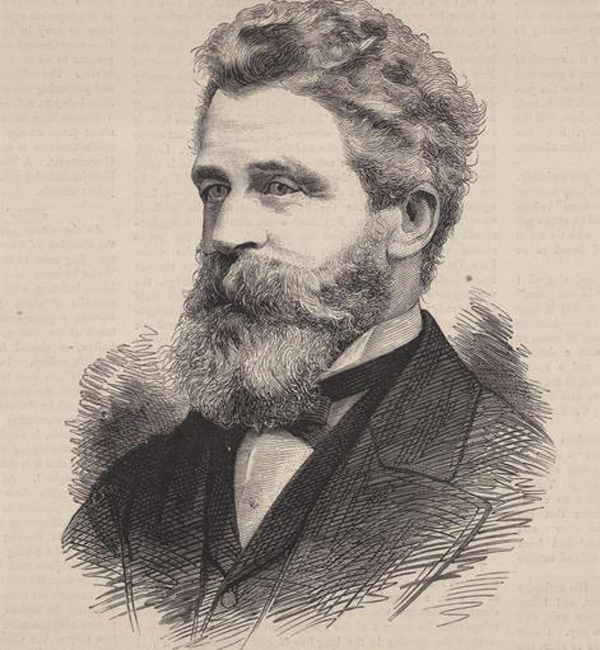
George Powell
As seen in the top map showing Farrell's Beach there is also a 'Powel's Beach'.
Although too late for the Farrell/Taylor times of that stretch of the estuary, there was a George Powell, a builder of Narrabeen who first moved into the area around 1895. He seems to have disappeared from view slightly so it's worth putting a few notes about him here, especially as he was among those who worked for Pittwater people. He was an active member of the Narrabeen Progress Association, his daughters and wife part of local musical concerts and was the school inspector for Pittwater from 1902. He stood for the second Warringah Shire Council in 1908, winning a seat in 'A Riding' and did much for the people of Pittwater during his years on council. More on him under 'Extras'.
Parents marriage:
1383/1848 V18481383 95 POWELL JOSEPH BECK MARY J VC (VC in NSW BDM's Early Church codes is Roman Catholic - Singleton (inc. New England), St Augustine's, Co. Northumberland)
Unclaimed Letters - William's River; Powell Joseph, Government Gazette Notices (1848, December 8). New South Wales Government Gazette (Sydney, NSW : 1832 - 1900), p. 1784. Retrieved from http://nla.gov.au/nla.news-article230151230
NSW BDM's Record of Birth: POWELL GEORGE S 3878/1859 Parents - JOSEPH MARY J Registered at - ST GEORGE
Siblings (those registered) in NSW BDM's:
POWELL THOMAS 3712/1857 JOSEPH MARY J ST GEORGE
POWELL GEORGE S 3878/1859 JOSEPH MARY J ST GEORGE
POWELL LUCY S 3931/1861 JOSEPH MARY J ST GEORGE
POWELL EMILY A 4240/1864 JOSEPH MARY A ST GEORGE
POWELL ADELINE M 4339/1867 JOSEPH MARY J PADDINGTON
POWELL. — February 21, at his late residence, 45, Bulla-naming-street, Redfern, Joseph Powell, after a lingering illness, aged 84 years. He fell asleep in Jesus. Family Notices (1885, February 24). Evening News (Sydney, NSW : 1869 - 1931), p. 4. Retrieved from http://nla.gov.au/nla.news-article111171224
THE FRIENDS of the late Mr. JOSEPH POWELL, are respectfully invited to attend his Funeral ; to move from his late residence, 48, Bullanaming-street, Redfern, THIS MORNING, at a quarter past 8 o'clock, to the Necropolis.
THE FRIENDS of JOSEPH, EDWARD, THOMAS and GEORGE POWELL are respectfully invited to attend the Funeral of their beloved FATHER ; to move from his late residence, 48, Bullanaming-street, Redfern, THIS MORNING, at a quarter past 8 o'clock, to the Necropolis. Family Notices (1885, February 24). The Sydney Morning Herald (NSW : 1842 - 1954), p. 12. Retrieved from http://nla.gov.au/nla.news-article13586275
George Powell is listed as a 'Builder' of Narrabeen when he stands for a position on Warringah Shire Council in 1908 - prior to that he had been active in the Narrabeen Progress Association in getting a tram to Narrabeen. He had married a Tasmanian girl, Eliza Cooper, at Leichhardt in 1891 and they had three children, two girls and a boy - the youngest child's birth registered at Manly:
POWELL KATE E 19111/1891 GEORGE ELIZA A LEICHHARDT
POWELL JESSIE E 33928/1893 GEORGE ELIZA ST PETERS
POWELL WILLIAM F 4826/1896 GEORGE ELIZA A MANLY
Jessie pops up in newspaper articles in 1913 for having been held up at the point of a gun at Narrabeen by a man who was subsequently sent to prison for his endeavours. A few notes from the pages of the past:
POWELL— COOPER.— On the 1st January, 1891, at Leichhardt Wesleyan Church, by the Rev. J. A. Jeffreys, Geo. Powell, of Leichhardt, Sydney, to Eliza, eldest daughter of Jas. Cooper, of Longford, Tasmania. Family Notices (1891, January 31). Daily Telegraph (Launceston, Tas. : 1883 - 1928), p. 4. Retrieved from http://nla.gov.au/nla.news-article150345983
James Cooper, her father brought the family to Australia in 1855. He was a painter and paperhanger (wallpaper). Her mother passed away in 1904:
DEATHS.
COOPER.—On the 20th January, at her residence, Longford, Eliza, the beloved wife of James Cooper (formerly of Nottingham, England), aged 76 years.
The funeral of the late Mrs. James Cooper will leave her late residence, Longford, on Friday afternoon, at 3 o'clock, for the Methodist Cemetery.—WRIGHT, Undertaker.
Longford Star Tent, I.O.R.—The members are requested to attend the funeral of the late wife of Bro. James Cooper, which leaves her late residence on Friday, 22nd inst. Family Notices (1904, January 21). Examiner (Launceston, Tas. : 1900 - 1954), p. 1 (DAILY.). Retrieved from http://nla.gov.au/nla.news-article35788469
NORTHERN LONGFORD
LATE MR. WILLIAM COOPER
The funeral of Mr. William Cooper took place at the Methodist Cemetery, Longford, on Tuesday afternoon, and was largely attended. Rev. R. G. Hunt officiated in the church and at the graveside. During the former service Mr. Hunt referred to Mr. Cooper's long association with the Longford Methodist Church and Sunday School and his activity in the Rechabite Lodge. The hymns "Abide With Me" and "Rock of Ages" were sung. Mr. W. H. Davis was at the organ. Bro. Robert Cook, C.R,, read the Rechabite oration at the graveside. The members of Longford Star Tent, I.O.R., were present. The chief mourners were Messrs. Percy, Leslie; Sydney, Charles, and Eric (sons); Mrs. A. G. Cooke, Mrs. R. Poole, Mrs. H. Blackburn, and Miss Jessie Cooper (daughters), and a number of sons-in-law and brothers-in-law. Many floral tributes were received, including wreaths from the railway goods and coaching staff, Longford Methodist Christian Endeavour Society, Inveresk Homing Society, officers and members of the Longford 'Star Tent I.O.R., and the Methodist Church choir.
Mr. Cooper was born at Nottingham, England, in 1855, and when still a boy came to Longford with his parents, the late Mr. and Mrs. James Cooper. He served his apprenticeship with his father as a painter and paperhanger.
Mr. Cooper married Miss Fanny Briggs, of Longford, years ago, and they were the first couple to be married in the present Methodist Church. He joined the Longford Star Tent I.O.R. In 1871. He was 64 years a member, and for some years prior to 1871 was a junior member of the lodge. He was secretary of the society for many years.
The widow and a family of five sons and four daughters survive him. One son, Louis, died on active service, and one daughter, Elsie, died many years ago. Country Interests and District News (1935, February 21). Examiner (Launceston, Tas. : 1900 - 1954), p. 5 (DAILY). Retrieved from http://nla.gov.au/nla.news-article51920784
POWELL.—July 28, at Pittwater, suddenly, John Powell, of Parkhurst, Macpherson St, Waverley, aged 64 years. Family Notices (1895, July 30). The Sydney Morning Herald (NSW : 1842 - 1954), p. 1. Retrieved from http://nla.gov.au/nla.news-article13988807
NARRABEEN PROGRESS ASSOCIATION.
At the last meeting of the Narrabeen Progress Association, the following office-bearers were elected for the ensuing year: — President, Alderman T. J. West; honorary secretary, Mr. T. H. Macpherson; honorary treasurer, Mr. George Powell; executive committee. Messrs. M'Lean, Gibbons, Macpherson, and Powell. A vote of congratulation was accorded to the president on his recent election as an alderman of the City Council.
Various other matters were dealt with, a good deal of discussion taking place concerning the proposal to build a hall at Narrabeen, the honorary secretary submitting plans and specifications, prepared by himself. A sub-committee, consisting of Messrs. Macpherson, Powell, and Gibbons was appointed to make further inquiries. NARRABEEN PROGRESS ASSOCIATION. (1900, December 22). The Daily Telegraph (Sydney, NSW : 1883 - 1930), p. 11. Retrieved from http://nla.gov.au/nla.news-article237123006
Department of Public Instruction,
Sydney, 29th August, 1902.
HIS Excellency the Governor, with the advice of the Executive Council, has been pleased to appoint the undermentioned to be members of the Public School Boards for the Sub-districts specified:— ...
Pittwater— George Powell, Esquire.
JOHN PERRY.
Government Gazette Appointments and Employment (1902, September 2). Government Gazette of the State of New South Wales (Sydney, NSW : 1901 - 2001), p. 6253. Retrieved from http://nla.gov.au/nla.news-article222045505
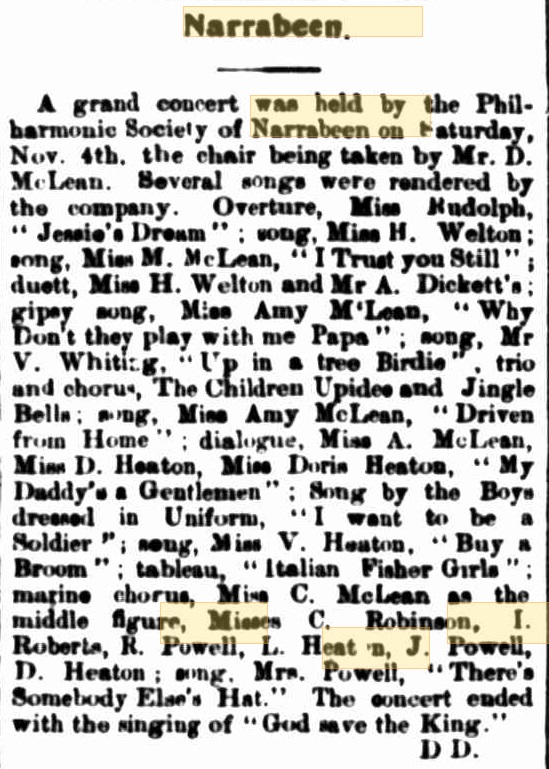
Narrabeen. (1905, November 11). The Mosman Mail (NSW : 1898 - 1906), p. 8. Retrieved from http://nla.gov.au/nla.news-article247012168
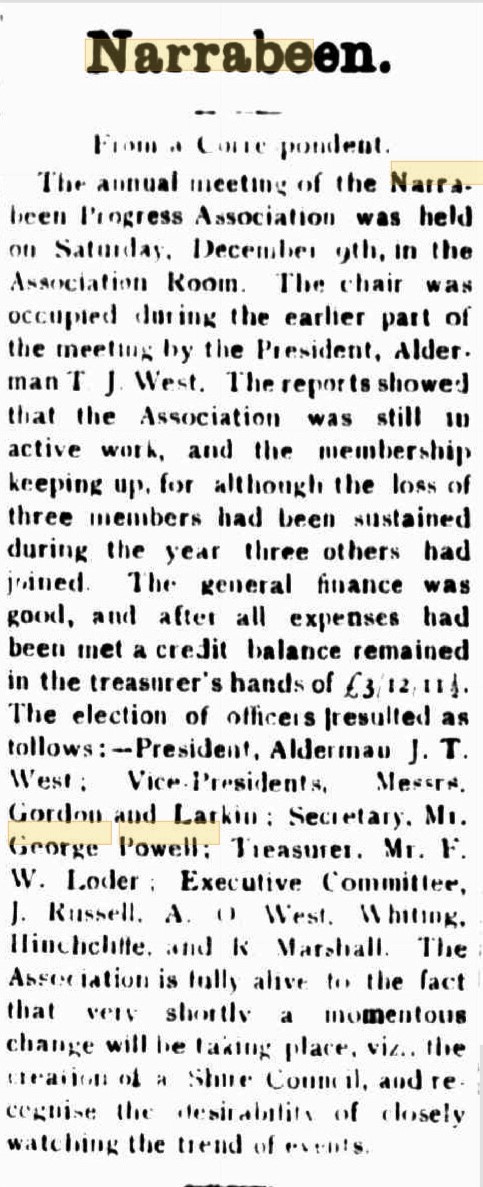
Narrabeen. (1905, December 16). Mosman, Neutral and Middle Harbour Resident (NSW : 1904 - 1907, 1919), p. 6. Retrieved from http://nla.gov.au/nla.news-article252191375
Narrabeen.
A grand concert was held at the Narrabeen Public School, Dec. 9th. under the management of Mr. J. McDonald, the local school teacher in aid of prizes funds. The Chair was taken by Alderman T. J. West. The concert opened with an overture by Miss McDonald. Two action songs by the children which were well performed (song by Miss M. McLean (Anona) a dialogue by the small boys) entitled "When I'am a man" caused great amusement. A coon song by Miss Amy McLean and chorus by the children came next. The wand drill by large girls of the school was very nice; also the dumb-bell exercises by the large boys was well performed, and two recitations by Miss K. Powell and Mr. Powell The first two were "The Baldheaded Man," and " Guilty Not." The next was "Christmas Day at the Work House." A dialogue by Master Corrie Wheeler and Joe Hansen, " King and the Miller." A recitation by Miss Ivy McDonald, " Somebody's Mother." Song by Mrs. Powell and Mrs. Heaton, "List to the Convent Bells." Song by Mr. Twight, " When the Roses Bloom Again." The concert ended by the singing of God Save the King. Narrabeen. Narrabeen. (1905, December 16). The Mosman Mail (NSW : 1898 - 1906), p. 8. Retrieved from http://nla.gov.au/nla.news-article247012651
On March 7th 1906, the Warringah Shire was proclaimed by the NSW Government Gazette, along with 132 other new Shires. The new council's boundaries ran roughly from Broken Bay in the north to Manly Lagoon to the south, and by Middle Harbour Creek and Cowan Creek in the west. It covered 264 square kilometres (102 sq mi) and had a population of around 2800, with 700 dwellings. Under the Shires Act, ratepayers with properties worth at least five pounds could vote for six Councillors for a three-year term, two from each Riding.
Upon its establishment a temporary council of nominated representatives was installed by the State member for Middle Harbour Dr. Richard Arthur: George Alderton, of Frenchs Forest, George Brock, of 'The Oaks' Mona Vale, Thomas Gibbons, of Narrabeen, David Skene, of Brookvale, and Prof. Anderson, of Bayview (husband of Maybanke, who resigned on 9 June 1906 and was replaced by Herbert Sturman, of Mona Vale).
The first meeting of this temporary council took place in the Narrabeen Progress Association's Hall at 10 a.m. on June 14th 1906, with George Brock in the chair. Mr. Brock was already wondering how so many absentee landowners would 'have their say':
VOTING FOR SHIRE COUNCILS.
TO THE EDITOR OF THE HERALD.
Sir,-I have Just been notified of my appointment on the temporary council of Warringah, anticipating more kicks than halfpence during my sojourn on this temporary council. I'm much concerned at the absurd expectations at election time of the property owners turning up to vote; it's certain we'll find the gas-bag-agitator-kerosene-tin humpy much in evidence; but what about the absent owners of all this vast magnificent residential site, untouched and unimproved land, that is much in preponderance in this Warringah shire? It is clearly evident that voting by post is the fairest for all concerned. If it is good enough for the A.M.P. Society with £20,567,134 of funds to have all the control done by post voting, it should be likewise for all those interested in the welfare and progress of this fairest spot on the terrestrial globe. This blot in the Local Government (Shires) Act 1905 will be the Waterloo of its successful working. True the municipalities have personal voting at the ballot box. What do we find? Mostly representation by park-spouters and fire-brand agitators. Result, 99 out of the 100 councils up to their necks in debt, it being made so easy to fling about other people's rates collected. Post voting will obliterate the professional failure. I am, etc.,
G. BROCK.
Pittwater, May 22.
VOTING FOR SHIRE COUNCILS. (1906, May 23). The Sydney Morning Herald (NSW : 1842 - 1954), p. 4. Retrieved from http://nla.gov.au/nla.news-article14773898
The election of the first Warringah Shire Council took place on Saturday November 24th 1906, and the first meeting of the six elected councillors took place on December 3rd. The six councillors elected in November 1906 were:
LOCAL GOVERNMENT.
THE FIRST SHIRE COUNCIL ELECTIONS.
The first elections of councillors took place on Saturday, in the 134 shires created in N.S.W. under the new system of local government. Although the number may afterwards be increased to nine, each shire council is at first to consist of six numbers— two each from three ridings. Many of the returns to hand up to this morning were not complete, but as far as they have been received they are given, below: —
WARRINGAH.— A Riding: E. W. Quirk, J. Duffey. B Riding: A. Ralston. T. Fishbourne. C Riding: J. Hews, E. A. Holden.
LOCAL GOVERNMENT. (1906, November 26). Evening News (Sydney, NSW : 1869 - 1931), p. 6. Retrieved from http://nla.gov.au/nla.news-article115673717
The new Councillors failed to elect a president so one was appointed for them - Thomas Fishbourne. Warringah wasn't the only newly formed council to do so:
WHEREAS the Local Government Act, 1905, provides that on some day between the first and fifteenth days of February in each year every Shire Council shall elect a President, and that if a Council fail to elect a President within the time so prescribed the Governor may appoint some member of the Council to be President: And whereas the Warringah Shire Council failed to elect a President within the period prescribed: Now, therefore, I, Sir Harry Holdsworth Rawson, the Governor aforesaid, in pursuance of the provisions of the said Local Government Act, 1903, and with the advice of the Executive Council, do hereby appoint Thomas Fishbourne, Esq., a member of the said Shire Council to be President. PROCLAMATION (1907, March 6). Government Gazette of the State of New South Wales (Sydney, NSW : 1901 - 2001), p. 1643. Retrieved from http://nla.gov.au/nla.news-article223089474
From the same year, on shaping the new area and road building, upon which so much of the formation of councils, and making them responsible for this, was based:
Access to Freshwater Beach.
Dr. Arthur, M.L.A., introduced a deputation to the Minister for Works from the Manly Council and Warringah Shire Council to ask for means of access to Freshwater Beach, near Manly. Mr. Lee said he must point out that the days for coming to a Minister for grants for special roads were over, if the department opened its doors to such applications now the provisions of the Local Government Act would be set at naught. The Warringah Shire would not be very badly off, and would have more money to spend on public works than had been spent previously. Hitherto the amount spent In Warringah had been about £1092 per annum, and the estimate of revenue available this year was £2020, of which over £1100 was Government endownment. They were now asking him to take the shire council's work out of Its hands, and he was not prepared to do this. ACCESS TO FRESHWATER BEACH. (1907, February 15). The Daily Telegraph (Sydney, NSW : 1883 - 1930), p. 4. Retrieved from http://nla.gov.au/nla.news-article238031328
Brookvale Shire Council.
At the last meeting of the Warringah Shire Council a motion by Councillor Quirk, recommending the re-subdivision of the shire was carried. The council recently wrote to the department upon the matter of securing a reduction in freight for the carriage of blue metal. In reply, it was stated that the Chief Commissioner, after having given the matter due consideration, regretted it would not be possible to give a general decision, as so much depended upon local circumstances. It was suggested, however, that councils having to bring road metal from a distance should approach the department, when claims will have every consideration. BROOKVALE SHIRE COUNCIL. (1907, May 24). The Daily Telegraph (Sydney, NSW : 1883 - 1930), p. 11. Retrieved from http://nla.gov.au/nla.news-article238042317
Mr. Sommerville, headmaster of the Brookvale Public School, received the visitors, who turned up in large numbers to witness the pleasing function of unfurling the flag. After the interesting ceremony patriotic, songs were sung by the pupils, speeches were delivered by Mr. Arthur, M.L.A., Mr. Scott Fell, Councillor Fishbourne (president of the Shire Council), and Councillors Quirk and Ralston. The remainder of the day was devoted to sports, a programme having been arranged for the children.
At the Narrabeen Public School there was also a large gathering, the visitors being received by Mr. Macdonald, headmaster. After the flag had been unfurled and saluted, addresses were delivered by Dr. Arthur, M.L.A., and several of the shire councillors. Sports were afterwards held.
At the Mona Vale School, the proceedings, which were of a very enthusiastic nature, were superintended by Mr. Morrison, the headmaster. There was considerable enthusiasm following the unfurling of the flag, and patriotic songs were sung and loyal speeches delivered. EMPIRE DAY - OTHER CELEBRATIONS. (1907, May 25). The Daily Telegraph (Sydney, NSW : 1883 - 1930), p. 10. Retrieved from http://nla.gov.au/nla.news-article238054898
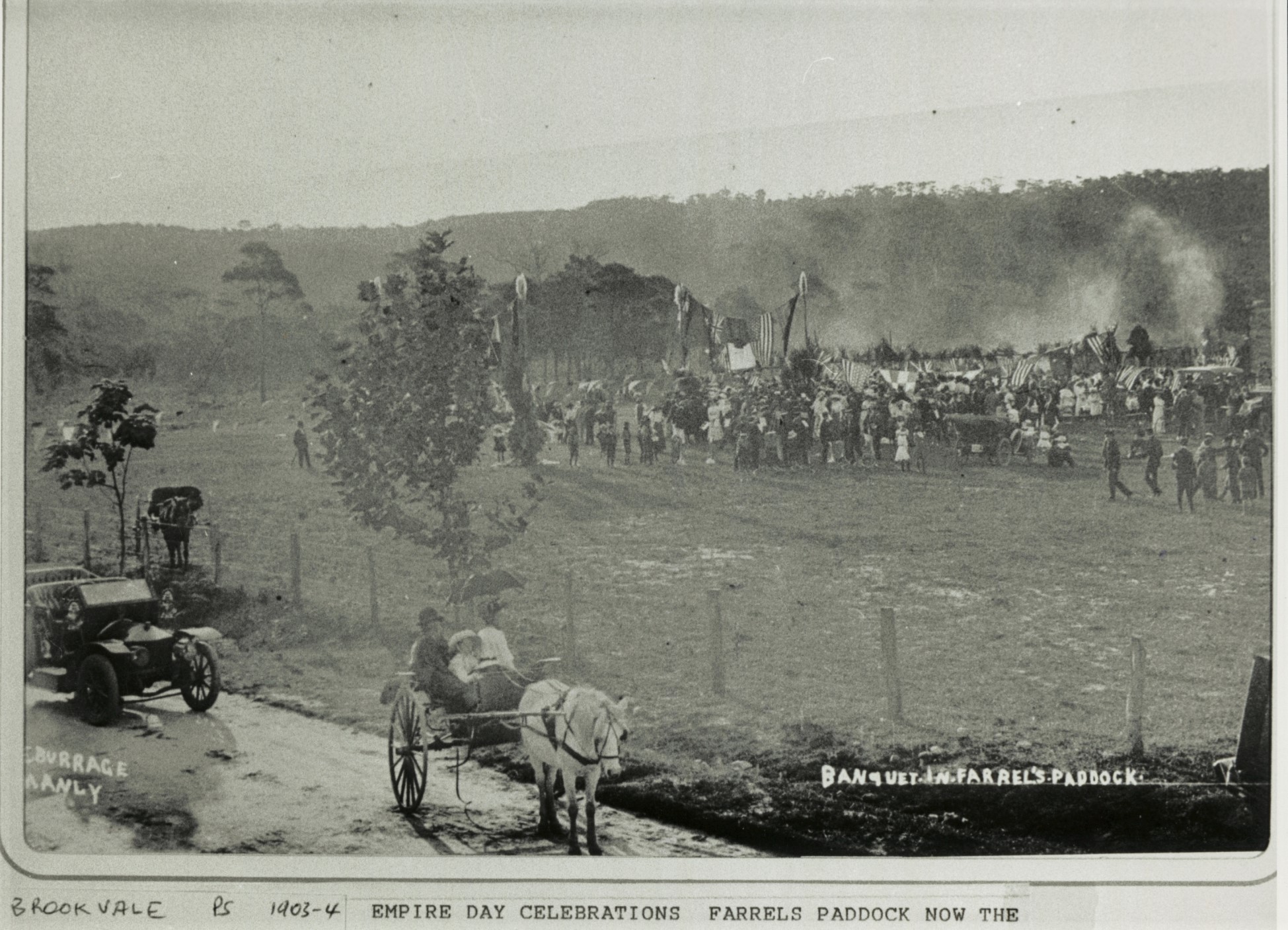
Brookvale Empire Day Celebrations circa 1903-1904 Image No.: a047-001921, courtesy State Library of NSW
WARRINGAH SHIRE COUNCIL.
At the last meeting of the Warringah Shire Council a communication from the Work Department was read, notifying the council of a grant of £250, which has been made for the purpose of starting nine road works. The wholesale cutting and removing of timber from the public reserves was recently brought under the notice of the Lands Department, with a request that the matter receive attention. The department has since taken action in the matter. The council agreed to co-operate with the Tintular body in their reques "that the money received from the sale of unused roads should revert to the shires." It was also agreed to support a proposal submitted by the Walgett Shire Council to the effect that a fee of one penny per head should be collected on all sheep inspected by the council inspector for the purpose of slaughter. WARRINGAH SHIRE COUNCIL. (1907, June 21). The Daily Telegraph (Sydney, NSW : 1883 - 1930), p. 6. Retrieved from http://nla.gov.au/nla.news-article238052975
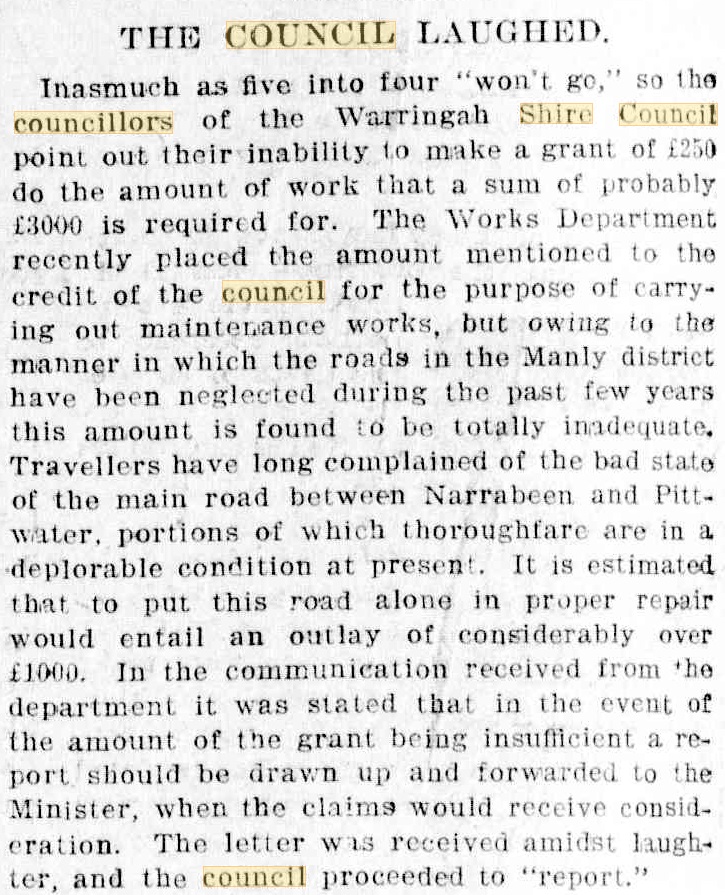
THE COUNCIL LAUGHED. (1907, June 26). The Daily Telegraph (Sydney, NSW : 1883 - 1930), p. 8. Retrieved from http://nla.gov.au/nla.news-article238051664
WARRINGAH.
At a meeting of the Warringah Shire Council the clerk presented a statement showing a credit balance of £538. He stated that although the ordinances and regulations were somewhat intricate, they proved of valuable assistance to him in his work. Contracts were let for the supply of 300 yards of metal, and for the clearing and forming of part of Gordon road, to Messrs. Oliver and Whitney respectively. WARRINGAH. (1907, July 17). The Sydney Morning Herald (NSW : 1842 - 1954), p. 7. Retrieved from http://nla.gov.au/nla.news-article14834033
In January 1908 George Powell was among those published as nominating for a Councillor position on the second Warringah Shire Council in A Riding:

MUNICIPAL SHIRE ELECTIONS. (1908, January 25). The Daily Telegraph (Sydney, NSW : 1883 - 1930), p. 10. Retrieved from http://nla.gov.au/nla.news-article238106170
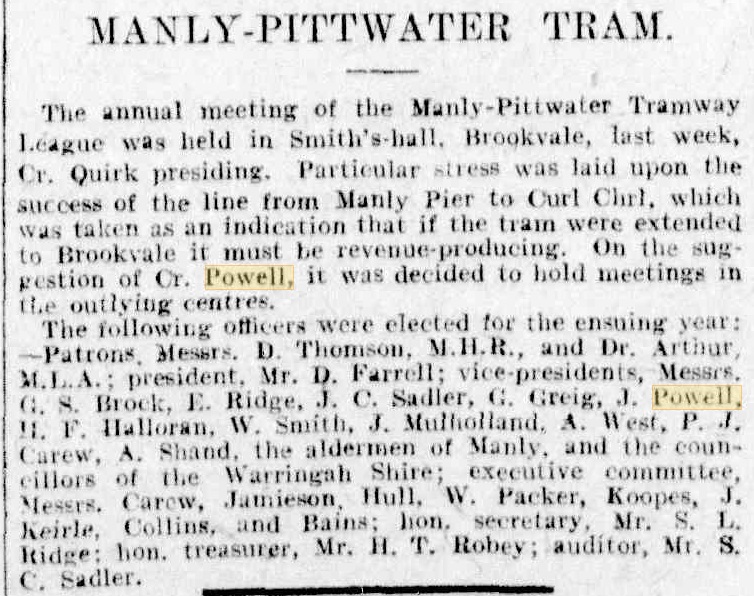
MANLY-PITTWATER TRAM. (1908, March 31). The Daily Telegraph (Sydney, NSW : 1883 - 1930), p. 4. Retrieved from http://nla.gov.au/nla.news-article238094188
IN THE SHIRES.
WARRINGAH.
At the last meeting of the Warringah Shire Council a communication from the Manly Council was read, drawing attention to the insanitary manner in which persons carrying on noxious trades' within the shire remove waste from the municipality; The letter was received, and inquiries are to be instituted. It has been almost decided to fix the shire headquarters at Brookvale, the erection of the comicil-chambers to be shortly carried out. The progress committees of Mona Vale, Church Point, Newport, and Narrabeen protested against the proposal, and strongly urged a reconsideration of the matter. The letter was received.
The council recently communicated with the Works Department for information regarding the time for appeals against valuations. A reply was read, stating that appeals would be allowed each year.
A communication was received from the Lands Department, giving a direct refusal for control of islands in the Narrabeen Lagoon. The council recently made application for the control of the islands. It was decided, on the motion of C. Quirk, seconded by Cr. Powell, "that representation be again made through Dr. Athur M.L.A."
On the motion of Cr. Powell, it was decided—' "That the Federal member for the district be requested to have a common charge of one penny per. call made for all telephones in the shire, and also to have the regulations amended so as to allow subscribers to ring up any bureau on the collect message system.".
The following motion by Cr. Quirk was carried "That a deputation wait on the Minister to urge the necessity for improving Powder Works-road, and failing this, to allow a portion of the Gordon-road grant to be spent on the said road"
The following tenders were accepted: Clearing, Mona-street C. J. Devlin, £10; culvert in Vineyard-street, C. Johnson, £12/10/; 400 yards of metal, C. J. Devlin, at 6d per yard. IN THE SHIRES. (1908, April 8). The Daily Telegraph (Sydney, NSW : 1883 - 1930), p. 7. Retrieved from http://nla.gov.au/nla.news-article238150326
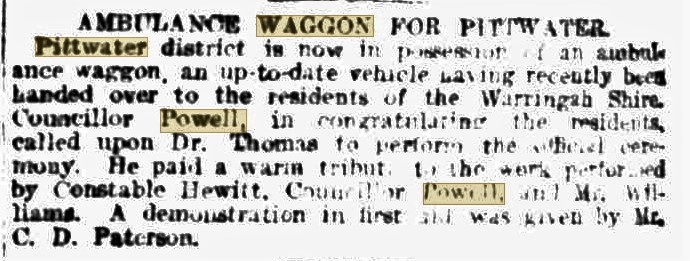
AMBULANCE WAGGON FOR PITTWATER. (1910, May 2). The Sydney Morning Herald (NSW : 1842 - 1954), p. 6. Retrieved from http://nla.gov.au/nla.news-article15119197
GIRL HELD UP.
COVERED WITH REVOLVER. -HIGHWAYMAN AT NARRABEEN.
Miss Powell; a resident of Narrabeen, was held up at the point of a loaded revolver on a bridge near her residence this afternoon and -a demand made for her money. She handed the highwayman £1 out of her purse and then hastened home, whilst the stranger made his escape into the bush. Word was sent to the Manly Police Station, and Constable Miller, who Is on special duty there, was communicated with. He set out to search for the man and made an In spite of her experience Miss Powell never lost her head, and coolly handed him all the coin she had. As soon as he lowered his revolver and bolted she hastened home and rung up the police. GIRL HELD UP. (1913, April 12). The Sun (Sydney, NSW : 1910 - 1954), p. 7. Retrieved from http://nla.gov.au/nla.news-article229837333
Narrabeen Hold Up,
YOUNG MAN COMMITTED FOR TRIAL.
SYDNEY, Friday.
George Richard Filby, aged 16, was committed for trial to-day on a charge of robbing Jessie Powell, of £1 while armed with a loaded revolver at Narrabeen. Constable Miller said that when accused was asked his name, he replied: "That you will never get. You are not going to drag my people into this disgrace." .
When asked why he committed the crime, he replied that he wanted the money to go up north and this was his only chance of getting it. He added he supposed he would get a few years' imprisonment. Narrabeen Hold Up, (1913, April 19). The Tamworth Daily Observer (NSW : 1910 - 1916), p. 2. Retrieved from http://nla.gov.au/nla.news-article109595410
The trial saw him being imprisoned for two years:
ROBBERY UNDER ARMS.
George Richard Filby, 16, pleaded guilty to a charge of assaulting Jessie Powell, at Narrabeen, on April 12, and robbing her of a handbag, one purse, and money, to the amount of £1, being then armed with a loaded revolver. Mr. Atkinson appeared for the prisoner, and said there was no doubt that the offence was the result of the evil influence of sensational picture show exhibitions. Evidence had been called as to the accused's bearing a good character, and being a regular attendant at Sunday-school.
In passing sentence of two years' hard labour in Goulburn Gaol, his Honor said the prisoner's conduct was the essence of cowardice. With a loaded revolver he had bailed up and robbed a defenceless young woman.
He was sure the young man had seen nothing of that kind at picture shows. QUARTER SESSIONS. (1913, May 6). The Sydney Morning Herald (NSW : 1842 - 1954), p. 6. Retrieved from http://nla.gov.au/nla.news-article15418286
Young George may not have seen such illegal behaviour at 'picture shows' but may well have seen the filming of such behaviour in his very own neighbourhood just a few years before:
BUSHRANGERS AT NARRABEEN.
REALISM FOR PICTURE SHOWS.
" Residents of Narrabeen and the Pittwater district are enjoying the exciting spectacle in their midst of stuck-up mail coaches, galloping bushrangers, and troopers, beauteous heroines on horseback, and other paraphertrialia of the good old bushranging days of New South Wales, while the hills around are .'resounding with the rifle and revolver shots of outlaws and police engaged m mortal combat on tho roads, and in the neighboring bush. Alas, it is all make-believe. It is nothing . more than the operations of the Australian ' Biograph Company, who are out on an expedition for film-making, and they have selected this beautiful and picturesque territory as a background for their pictures of ;Old Australian life and incident. A strong cast of leading actors and actresses are engaged In the strenuous work, including Miss Harrie Ireland, Mrs. and Miss Herbert, Messrs. Gaston Mervale, Godfrey Cass, and other well-known artists. Over -40 horses are employed in the operations, which are on an extensive scale. Mr. Clarke is in charge of the camera. The company work in, the district for a week. Out in French's Forest, in the vicinity of Oxford Falls, the Spencer Biograph Company are also engaged in the same class of task. BUSHRANGING AT NARRABEEN. (1911, January 21). The Sun (Sydney, NSW : 1910 - 1954), p. 10 (FINAL SPORTING). Retrieved from http://nla.gov.au/nla.news-article221589110
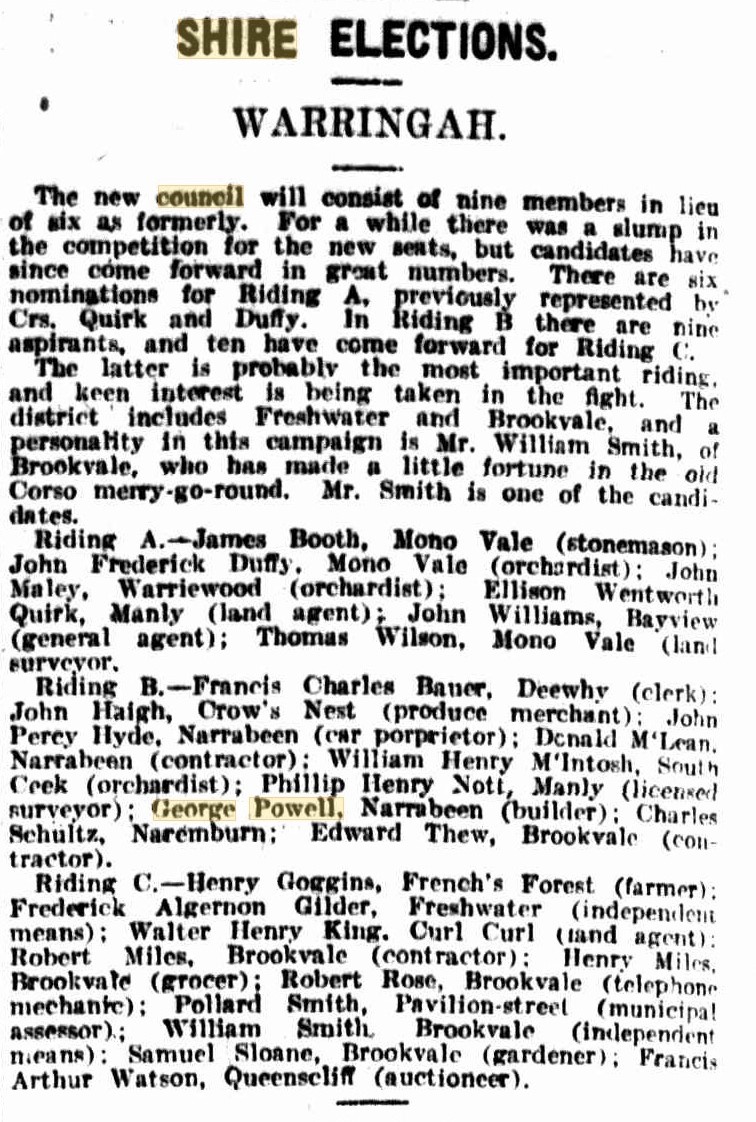
SHIRE ELECTIONS. (1914, January 23). The Daily Telegraph (Sydney, NSW : 1883 - 1930), p. 10. Retrieved March 28, 2019, from http://nla.gov.au/nla.news-article239020725
He was 66 years of age when he passed away - his name is perpetuated in Powells Road, Brookvale:
POWELL. — January 14, 1926, at Clyde-street, Granville, (suddenly), George, dearly beloved husband of Eliza Ann Powell, of Goodwin-street, Narrabeen, aged 66 years. At rest. Family Notices (1926, January 15). The Sydney Morning Herald (NSW : 1842 - 1954), p. 10. Retrieved from http://nla.gov.au/nla.news-article16283684
POWELL. —The Relatives and Friends of Mrs. G. POWELL and FAMILY, of Goodwin-st, Narrabeen, are respectfully invited to attend the Funeral of their dearly beloved HUSBAND and their FATHER, George Powell, to move from 143 Clyde-street, Granville, THIS DAY, at 12 noon, for Interment in the Methodist portion of the Manly Cemetery, at 3 p.m. By road, per Motor Service. Family Notices (1926, January 15). The Sydney Morning Herald (NSW : 1842 - 1954), p. 9. Retrieved from http://nla.gov.au/nla.news-article16283688
Eliza passed away in 1943
POWELL ELIZA ANN 28379/1943 parents: JAMES ELIZA Registered at - MANLY
Her father preceded her by just a few years:
George Inglis Hudson
This 'advertorial' appeared a few times during 1903 -and allows us to see the him of then:
HUDSON'S EUMENTHOL JUJUBES. Manufactured by Mr, G. Hudson, Ipswich.
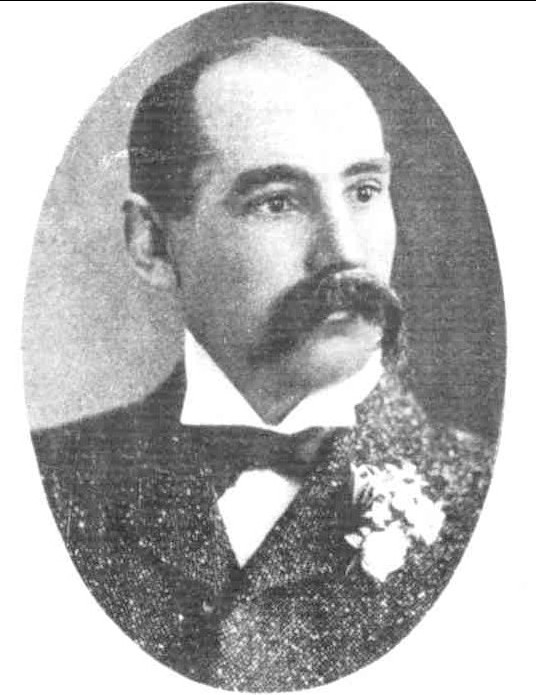 Illustrations herewith presented deal with a preparation that is extensively and favourably known in Australia. Mr. George Hudson, the inventor and manufacturer of Eumenthol Jujubes, has resided for some years in the Northern State.
Illustrations herewith presented deal with a preparation that is extensively and favourably known in Australia. Mr. George Hudson, the inventor and manufacturer of Eumenthol Jujubes, has resided for some years in the Northern State.
He was born at Hobart, 1863, and received his early education at the late H. M. Pikes's City School. Sydney attracted him in 1878, and seven years were there spent in the combined study of chemistry and dentistry. The diploma in the former was obtained at a special examination held by the Pharmacy Board in June 1884.
GEORGE HUDSON, Proprietor of Hudson's Eumenthol Jujubes.
After building up a successful business at the Glebe, Mr. Hudson found it necessary, on account of his health, to spend some time in travelling, finally establishing himself at Ipswich, where he is now one of the leading figures in business circles.
He is cosmopolitan in his ideas and sympathies, and, gathering material from all available sources, he has kept himself in the front rank of his profession. At the outset Mr. Hudson realised the far-reaching importance of antiseptics in the cure and prevention of disease, and was an enthusiastic admirer of Dr. (now Lord) Lister for his famous discovery. The dual experience as a chemist and dentist has impressed upon Mr. Hudson the wide utility of an antiseptic for keeping the oral mucous membrane in a healthy condition and preventing decay of the teeth.
Eumenthol Jujubes, the result of long and costly experiments, have been produced to attain this end, and the endorsement they have received from members of the medical profession and dentists in all the States emphatically marks their success. Prior to their introduction in 1891 there was no effectual yet harmless antiseptic which could be freely used by the public. The most powerful antiseptics were not only poisonous, but, like carbolic, strongly caustic. The proprietor of Eumenthol Jujubes, as an experienced pharmacist, decided to obtain his principal Ingredients from the vegetable kingdom. Even the best native oils contain a large percentage of deleterious matter, such as phillandrene, so often met with in eucalyptus. To avoid these impurities and achieve the best, results Mr. Hudson made arrangement with the largest firm of European distillers to extract only the active constituents (the inherent life) for his use.
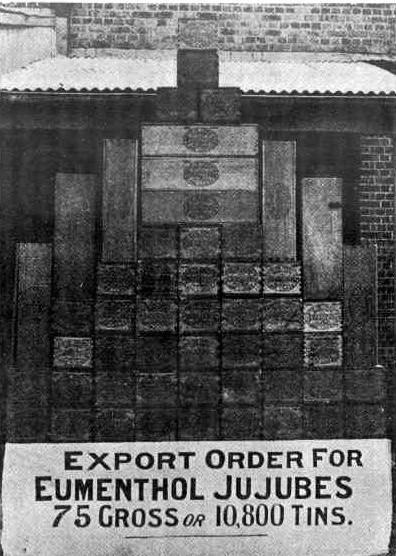
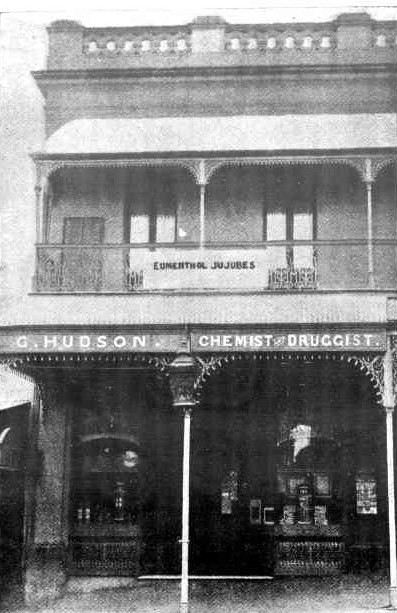 To this unique method and the scientific skill employed in treating each of the many ingredients of Eumenthol Jujubes are due their striking effectiveness. The merits of Eumenthol Jujubes once made known, their popularity soon spread, first in Queensland, then in New South Wales, and they are now rapidly growing in favour in all the States of the Commonwealth and New Zealand, whilst orders come to hand from different parts of the Old World.
To this unique method and the scientific skill employed in treating each of the many ingredients of Eumenthol Jujubes are due their striking effectiveness. The merits of Eumenthol Jujubes once made known, their popularity soon spread, first in Queensland, then in New South Wales, and they are now rapidly growing in favour in all the States of the Commonwealth and New Zealand, whilst orders come to hand from different parts of the Old World.
They have been found of great value to public speakers and singers, and several well known people have already testified to this effect. Eumenthol Jujubes were exhibited at the last Australian Medical Congress, held in Brisbane in 1899,and the 'Australasian Chemist and Druggist,' published in Melbourne, in its report of the them says : — ' Mr. G. Hudson, of Ipswich, had an exhibition of his Eumenthol Jujubes, which are put. up inelegant tin boxes, and are certified to be effective in the destruction of bacteria, and in the prevention of their growth. This proprietary has taken a hold upon public favour, and is certainly a good combination of medicaments in a convenient form.' The' Australasian Medical Gazette ' reports favourably on them, and concludes by saying : — ' They should prove of great service in affections of the throat and voice.' Mr. W. A. Dixon, F.I.O., F.C.S., the Public Analyst of Sydney, after an exhaustive test, says :' There is no doubt that Eumenthol Jujubes have a wonderful effect in the destruction of bacteria, and preventing their growth.'
Many dentists recommend the daily Use of Hudson's Eumenthol Jujubes. Dr. Leon Williams, of London, the great dental authority, says : ' I have repeatedly pointed out, that, in my judgment, the greatest hope for the future in the saving of human teeth lies in the direction of prevention of decay by the daily use of germicides, and I am, I believe, speaking with all due caution when I say that, in my judgment, two-thirds of the decay of teeth now going on is preventable. Conceding the fact that the chief cause of decay is the presence of bacteria, it is one's duty to apply some remedy for freeing the oral cavity of these destructive organisms, realising that in a scientifically clean mouth there can be no decay.' A small piece of Hudson's Eumenthol Jujubes held in the mouth destroys all forms of bacterial life, odours, and decomposing matter, and prevents the formation of the horn-like film of bacteria over the surface of the teeth which furnish a lodging for the acid-producing organisms of decay. The widespread popularity of Eumenthol Jujubes, whilst due undoubtedly to their intrinsic merits, must also be attributed to some extent to the tact and energy of the proprietor, and to the effective and carefully-planned methods Le has adopted in introducing them to the public.
Our illustrations include views of Rose Hill, Mr.Hudson's delightful residence on Limestone Hill, one of the most popular suburbs of Ipswich. The residence commands a fine view of the surrounding country.
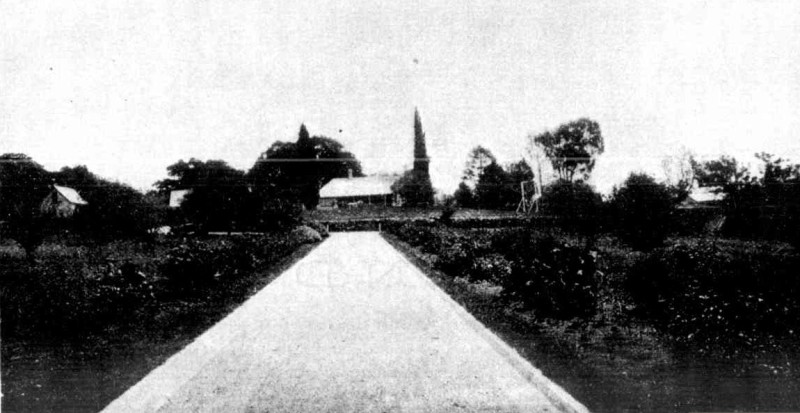
ROSE HILL, IPSWICH, RESIDENCE OF G. HUDSON.
HUDSON'S EUMENTHOL JUJUBES. (1903, June 17). The Sydney Mail and New South Wales Advertiser (NSW : 1871 - 1912), p. 1497. Retrieved from http://nla.gov.au/nla.news-article165188669
NSW BDM's Marriage: 1084/1889 HUDSON GEORGE MACCLOY MARY L SYDNEY
CLAIM FOR £2000
Alleged Breach of Promise Returned Officer Sued
Mary Blunt sought to recover £2090 damages from Andrew Edwin Olding, a returned soldier, In respect of alleged breach of. promise of marriage, in No. 2 Jury Court this afternoon, before Mr. Justice Ferguson and a jury of four. The defendant pleaded that the agreement alleged had been rescinded, and that he had been absolved and exonerated from the promise alleged. Mr. Milner Stephen (instructed by Messrs. Stephen, Jaques, and Stephen) appeared for the plaintiff; and Mr. Shand, ICC., and Mr. Curtis (Instructed by Messrs. Pigott and Stinson), for the defendant. The plaintiff, a young and good-looking girl, residing with her parents at Kensington,- said that in 1913 her father owned three butter factories in the Muswellbrook district. That year she was in Sydney, and met the defendant. During tne following year she was staying with the defendants people, and in August, 1914, when he was going to tho war, he asked her to marry him. He left for the front in October of tho same year, and while en active service she wrote him several times each week and sent him parcels. He asked her would she like to look after his military pay whilst away, but she refused, telling him that she felt certain ho would save ills pay for their future home. ...
MARRIAGE OF DEFENDANT
Subsequently, said the plaintiff, the defendant told her that he could not reciprocate her love, and she taxed him with having received letters from an other woman. He said: "She is only a friend."
When the defendant left for the war he was a lieutenant, but on his return he was a major. He was a master coachbuilder.
Mr. Stephen then tendered the certificate of marriage between Edwin Andrew Olding D.S.O, the defendant, and Eva Doris Louise Hudson, the daughter of George Inglis Hudson, manufacturing chemist.
The ceremony took place on August 27, 1919, at St. Stephen's Church, Phillip-street, Sydney.
Cross-examined by Mr. Shand, the plaintiff said that she was aware that the defendant had been wounded several times in action, and that he had complained about his health.
AN ANONYMOUS LETTER
The plaintiff admitted that on the return of the defendant to Sydney she and others were counselled not to worry him. She denied that she had worried him. When she spoke to him
about his changed attitude, he said that he was then medically unfit, and suggested the breaking of the engagement. He was receiving two and three letters a week from a married woman in West Australia. She was not aware that that woman was the wife of a doctor in West Australia, or that she had acted as a mother to the soldiers on board the Osterley... CLAIM FOR £2000 (1919, September 5). The Sun (Sydney, NSW : 1910 - 1954), p. 5 (FINAL EXTRA). Retrieved from http://nla.gov.au/nla.news-article221992817
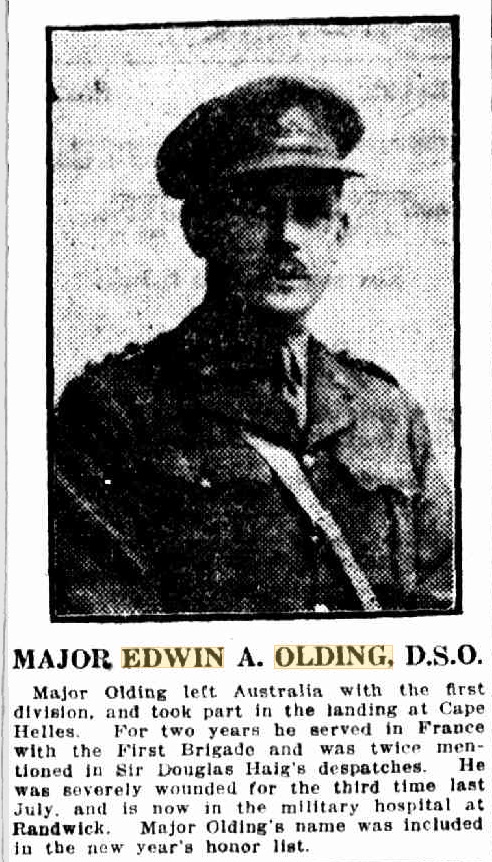
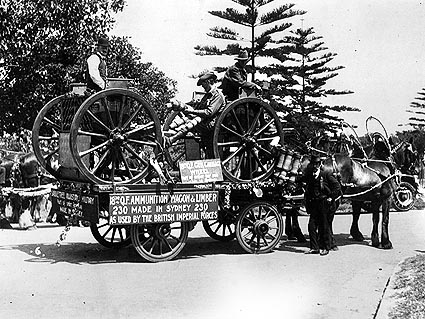
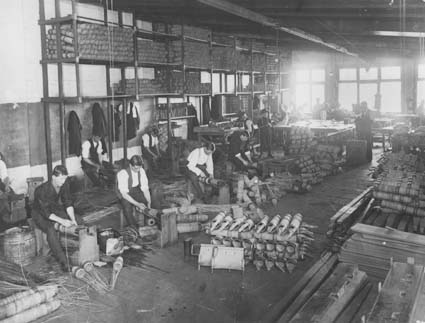
MR. G. I. HUDSON. The funeral took place yesterday of the late Mr. George Inglis Hudson, of Wunulla-road, Woollahra Point, who died at a private Hospital, Darlinghurst, late on Wednesday. He had been managing director of the Eumenthol Chemical Company, and had formerly resided in Ipswich, Queensland.
The remains were interred in the Waverley cemetery, following a service at St. Stephen's Presbyterian Church, Macquarie-street. The services at the church and the graveside were conducted by the Rev. P. Macdonald of Mosman.
The chief mourners were the widow and daughter (Mrs. Doris Olding). Among those present were Mr. P. Chaffey (Chief of Staff) Mrs. Chaffey, Dr. Wertz (Vice-Consul for Germany) Sir Allen Taylor, Lady Richards, Mr. W. H Childs (late Commissioner of Police), Dr. Hamilton Marshall, Dr. Evan Jones, Captain Carter, Messrs. Percival and Mackie (representing the Randwick Council). Messrs. Alpress, Linklater, W. Arnott, H. Campbell, Felix Booth jun., W. Hughes, George Olding, V. A. Haigh, F. Brown E. C. Pitt, J. Parram, Bruce Ryrie, Messers. Collis, Hubert Palmer, Herbert Palmer, Lintor Palmer, Baty, Joyce, Cridland, Norman Saywell, F. Adams, H. Ludowici, and Paton; Mr. and Mrs. B. Chew, Mr. and Mrs. S. McCloy, Mesdames Symons, Saywell, and Morrisby; Misses M. and N. McCloy, Abel, Lorking, and Chiplin. MR. G. I. HUDSON. (1936, April 18). The Sydney Morning Herald (NSW : 1842 - 1954), p. 23. Retrieved from http://nla.gov.au/nla.news-article27991758
In the Supreme Court of New South Wales. ,
PROBATE JURISDICTION.
In the will of George Inglis Hudson, late of Hereawai, 55 Wunulla-road, Point Piper, in the State of New South Wales, retired manufacturing chemist, deceased.
PURSUANT to the provisions of the Wills, Probate and Administration Act, 1898, of the Testator's Family Maintenance and Guardianship of Infants Act, 1916, and of the Trustee Act, 1925: Notice is hereby given that all creditors and other persons having any claim or demand upon or against the estate or otherwise interested in the property and assets of the abovenamed deceased, who died 'at Darlinghurst, on the 15th day of April, 1936, and probate of whose will was granted by the Supreme Court of New South Wales, in its Probate Jurisdiction, on the 21st day of August, 1936, to Mary Louisa Hudson, widow of the said deceased, of 55 Wunulla-road, Point Piper, George Arthur Parkliill, chartered accountant, of 375 George-street, Sydney, and Perpetual Trustee Company Limited of 33-39 Hunter-street, Sydney, are hereby required to send on or before the 31st day of October next, full particulars of their claims and demands upon the said estate or in respect of the said property and assets or any part thereof to Perpetual Trustee Company Limited, 33-39 Hunter-street, Sydney, at the expiration of which time the said Mary Louisa Hudson and the said George Arthur Parkhill and the said Perpetual Trustee Company Limited, as executrix and executors of the will of the said deceased, intend to proceed to administer the said estate and to convey and distribute the property and assets of the said deceased to and among the parties and persons entitled thereto, having regard only to the claims and demands of which they shall then have notice; and the said. Mary Louisa Hudson and the said George Arthur Parkhill and the said Company will not, in respect of the property and assets or any part thereof so conveyed or distributed, be liable to any person of whose claim they shall not have had notice at the time of such conveyance or distribution.—Dated this 24th day of August, 1936.
For Perpetual Trustee Company Limited,
B. COPLAND LETHBRIDGE,
Managing Director. PlGOTT, ST1NSON, MACGREGOR AND PALMER, PROCTORS.
483 £1 12s. PROBATE JURISDICTION. (1936, August 28). Government Gazette of the State of New South Wales (Sydney, NSW : 1901 - 2001), p. 3608. Retrieved from http://nla.gov.au/nla.news-article223039477
CHEMIST'S ESTATE SYDNEY, Friday. An estate valued at £162, 672 was left by George Inglis Hudson, manufacturing chemist, of Woollahra, who died in April last. Included in the bequests was £1000 to the University of Sydney to encourage further investigation of the science of organic chemistry. The bulk of the estate was bequeathed to the widow and children. CHEMIST'S ESTATE. (1936, August 22).Newcastle Morning Herald and Miners' Advocate (NSW : 1876 - 1954) , p. 10. Retrieved from http://nla.gov.au/nla.news-article140506388
PROBATE OF WILL. GIFT TO UNIVERSITY. Mr. George Inglis Hudson, manufacturing chemist, who died on April 15, left £1000 by his Will to the University of Sydney, on trust to apply the Income for the benefit of students of organic chemistry. He also left a legacy of £100 to the Congregational Church, Pitt-street. The residuary estate passes on trust for testator's wife and daughter, with remainder to grandchildren. Mr. Hudson appointed his wife. Mr. G. A. Parkhill, and the Perpetual Trustee Co., his trustees and executors. The estate has been sworn for probate at £162,673. PROBATE OF WILL. (1936, August 22). The Sydney Morning Herald (NSW : 1842 - 1954), p. 14. Retrieved from http://nla.gov.au/nla.news-article17263351
His wife passed away soon after him:
NSW BDM's HUDSON MARY LOUISA 19620/1938 JAMES SARAH WOOLLAHRA
INGLIS HUDSON.—July 26, 1938 at her home Herewai Woollahra Point Mary Louise widow of the late G Inglis Hudson and mother of Doris (Mrs. D Olding) Family Notices (1938, July 27). The Sydney Morning Herald (NSW : 1842 - 1954), p. 14. Retrieved from http://nla.gov.au/nla.news-article17478388
MRS. LOUISE HUDSON. Mrs. Louise Inglis Hudson, who died at her home, Herewai, Woollahra Point, was born at Sunny Corner, in the gold mining district, outside Bathurst. She was the widow of the late George Inglis Hudson, founder of the Hudson Eumenthal Chemical Co. She was a foundation member of the Randwick Red Cross and worked as a VAD during and after the war. She was also a member of the N.S.W. Victoria League and the Queen Victoria Club. MRS. LOUISE HUDSON. (1938, August 3). The Sydney Morning Herald (NSW : 1842 - 1954), p. 9. Retrieved from http://nla.gov.au/nla.news-article17496032
BATHING AT COOGEE. TO THE EDITOR OF THE HERALD.
Sir,-With reference to the regulations about to be adopted for the control of bathing at Coogee, it does not seem likely that much good will result there from unless public bathing is prohibited during certain hours of the day, say from 10 a.m. to 5 p.m.; at any rate, this should be so, at least, on Sundays, for that seems to be the principal day for the disgraceful exhibitions referred to in the daily press by different correspondents. A place so conveniently situated to the city as Coogee is should be principally for the use of children, and this was so a few years ago; where-as a visit to the place now shows that instead of being visited by parents who wish to give the little ones an outing, it is monopolised, especially on certain days, by the larrikin element of the city; and Coogee has such an unenviable reputation that parents have carefully to avoid this delightful seaside resort. There is no reason why Coogee should not be like Margate and other seaside places in the old country, and to make it so the only loss would be that of a few tram fares; but I have no doubt that if early morning trams were run conveniently there would be a large increase in the traffic during those hours. I am, etc, GEORGE INGLIS HUDSON. BATHING AT COOGEE. (1908, February 7). The Sydney Morning Herald (NSW : 1842 - 1954), p. 4. Retrieved from http://nla.gov.au/nla.news-article14954370
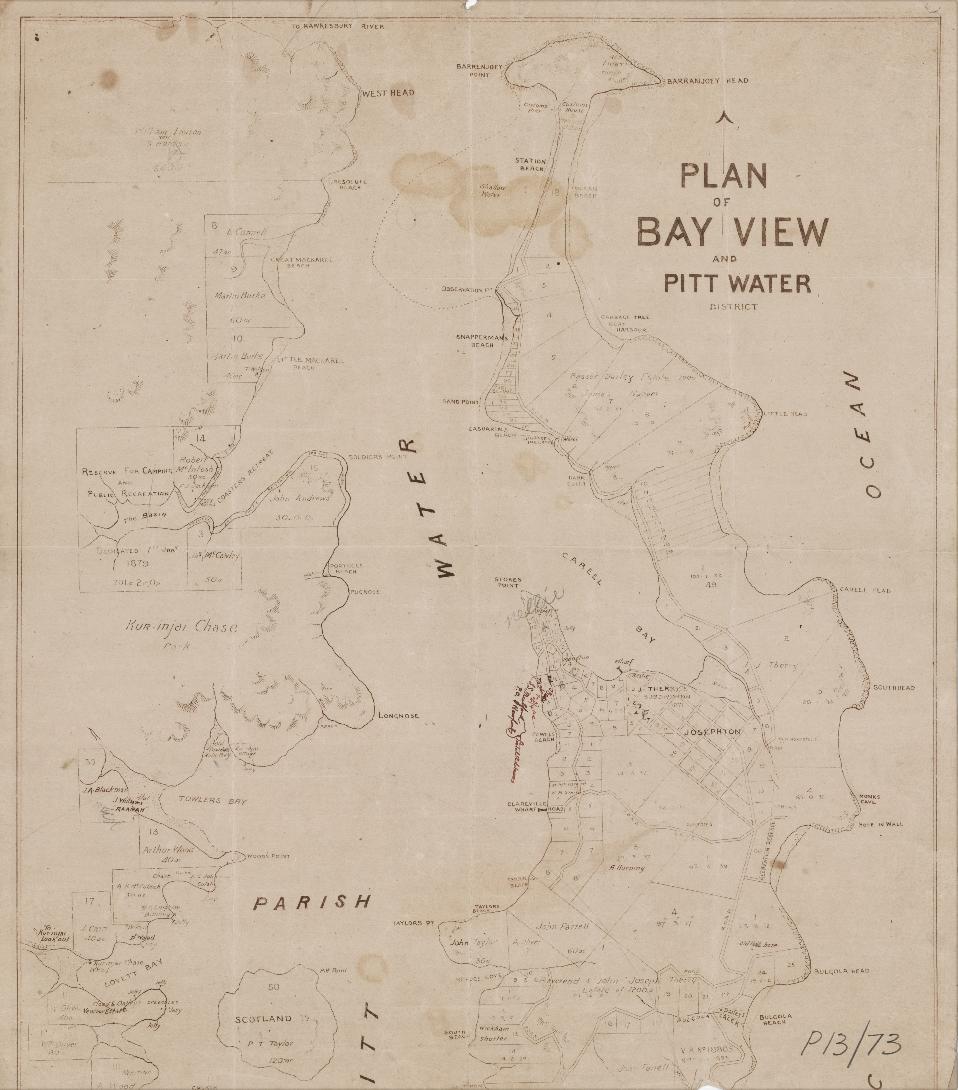
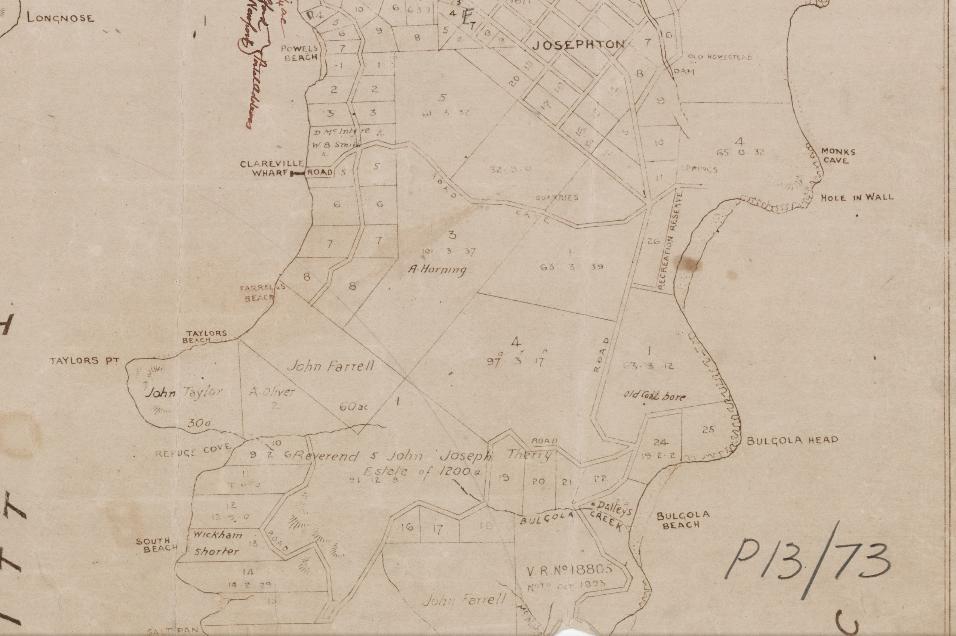
A Few Extra Extras
W.R.Johnson, 31/5/37, requesting Council to remove from 7 Hilltop Road, Clareville, two large trees which lean in the direction of his house, and are a danger to life and property. Resolved, — That the Works Committee inspect and the Overseer's recommendation that provision be made on each building application form for information whether there are any trees in the vicinity which are likely to be a danger to the proposed building, when erected, be adopted. (Crs. Campbell, Ross)
8. E. H. Reynolds, 26/5/37, again requesting the carrying out of work promised him in January last, viz — the construction of Chisholm road joining Central Road with the junction of Chisholm Avenue and Hilltop Road, Clareville, and the repairing of Chisholm Avenue. Resolved, — That as recommended by the Overseer, maintenance work be carried out on Chisholm Avenue, and that £63 be voted-for ballasting and tarring 4 1/2 chains of Hilltop Rd from Central Road to Chisholm Avenue 12 feet wide. (Crs.Hewitt,Ross)
(1) E. H. Reynolds, 22/4/45, (a) drawing attention to the condition of Chisholm Avenue, Avalon, stating that the whole of the barrage on the grades has been washed away; (b) stating Chisholm that the 12-ft. right-of-way between Chisholm Avenue and Avalon Avenue Parade is impassable in wet weather. Referred to the Works Committee. (2) F. N. Adcock, 23/4/45, making application to purchase the Council's Lots 13 and 14, Beaconsfield Street, Newport, or, if Council wishes to sell only one lot, offering to purchase Lot 13. Resolved, - He be informed that the land will be sold in the near future. (Crs. Forster, McLean) (3) A. Perletein, 21/4/45, drawing attention to the appalling conditions of Herbert Avenue, Salt Pan, from Prince Alfred Parade to his house, stating he keeps the gutter clear, and the condition of the road is now such tradesmen will not call. Avenue Resolved, - That the Engineer's report that the drains are to be cleaned out be adopted.. (Crs. McLean, Foretell (4) G. C. Pottage, 23/4/45, requesting attention to Irrawong Irrawong Road, North Narrabeen. Resolved, - That maintenance attention be given. (Crs. McLean, 3)1117(W.) (5) Ivy Case, drawing attention to deep open drain in front of her property in Lido Avenue, North Narrabeen, stating it is impossible to park within 30 feet of her front gate. Resolved, - Th• ay;bberia report that little be done at present-.ZZOlied. (6) .Avalon District Ratepayers' Ago 1100. , 24/4/45, stating complaints have been received that properties have been flooded by stormwater from the main road above Bilgola, that existing facilities proved inadequate, and the drainage easement, which is only 8 ft. wide, scoured out beyond that width, and the electric light pole adjoining the easement is in danger of collapse, suggesting that to overcome, the trouble, the channel through Lot 563 be piped and a bump constructed where it meets Old Barrenjoey Road, with a baffle wall to restrict the flow of water and that the watertables be cleared between this ,point and Bilgola Creek; also inquiring whether more water could be transferred to the easement through Lot 522 to better divide the flow of water from the main road. Referred to Works Committee. (7) H. D. Hillier, drawing attention to the damage being caused by Stormwater to the road surface of Bilgola' and Elaine Avenue and adjoining properties: Complaining of the flooding-of' garage during storms... will be, reluctantly; forced to seek legal advice, unless some assurance the trouble will be 'overcome. to Works. Committee (8) F. C. Postle, 22/4/45; drawing attention to inadequate provision for,disposing of stormwater at Bilgola.
Sybil's Sustenance
WHEN the 'Sybil' company decided to have a picnic to Avalon Beach, each member had to bring some of the 'eats.' The amount subscribed varied according, to the visitor's salary. Statisticians employed worked out Gladys Moncrieff's share at: 1 round of beef. 1 large cooked tongue. 4 bottles mixed pickles, 4 lbs butter, 2 blocks of cake, 10 doz. hard-boiled eggs. Robert Chisholm was served with a notice to buy 14lbs of onions on a soaring market, while Arthur Stigant was assessed at 13lbs of sugar, a tin of mustard, and one large-sized strawberry tart. The assessors worked with lusty appetites, apparently, for there was enough food to feed the Monaco Army left over, and at Gladys Moncrieff's suggestion it was sent to the Old Men's Home conducted by the Salvation Army at Narrabeen. Sybil's Sustenance (1924, March 16). Truth (Sydney, NSW : 1894 - 1954), p. 4. Retrieved from http://nla.gov.au/nla.news-article168703660
FUN AT AVALON.

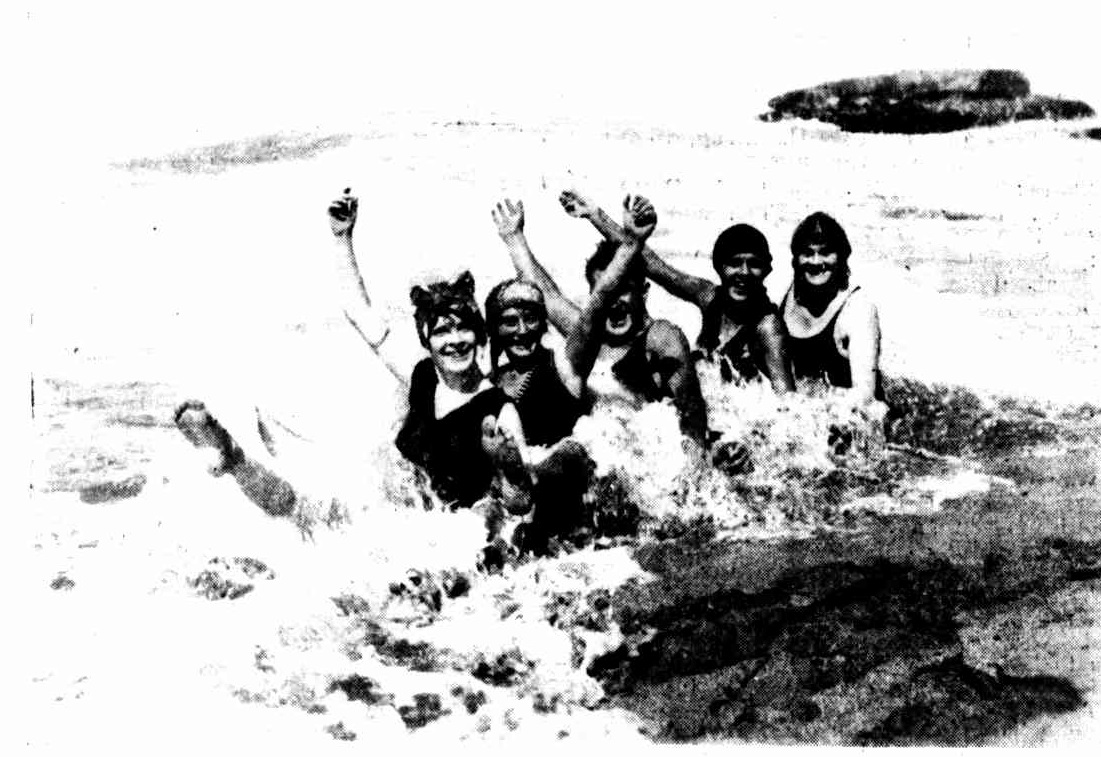
These delightful snapshots were taken at Avalon beach. a very beautiful spot near Newport, on the occasion of a recent outing by members of the 'Sybil' Musical Comedy Company and some of their friends.
FUN AT AVALON. (1924, March 19).Sydney Mail (NSW : 1912 - 1938), p. 43. Retrieved from http://nla.gov.au/nla.news-article166150978
Man Killed Trying To Save Koalas
The City Coroner, Mr. F. L. McNamara, said yesterday that a woman and a boy who tried to push a man off an electric power line had been very brave.
Mr. McNamara found that Richard Dunstan Byrne, 25, an employee of Koala Park, Castle Hill Road, West Pennant Hills, was electrocuted at Clareville on September 6. He was trying to rescue two koala bears.
Raymond William McLean, 13, of Koala Park, West Pennant Hills, said Byrne climbed a tree at Miss Courtney's home in Beach Parade, Clareville, to get two koala bears which were in a branch. He sawed part of the way through a branch when it broke and crashed through an overhead power line.
Byrne climbed down the tree and walked to where the broken line lay. McLean said he heard Byrne cry out and then fall down. He tried to push Byrne off the line with a stick, but was unable to.
Miss Ann Elizabeth Courtney said she saw a koala bear with a baby on its back climb into a tree on her property.
She telephoned Koala Park and Byrne called.
Later she heard a cry. She saw sparks and a glare from the broken line and Byrne lying across it. She tried to push him away with a piece of wood, but he was too heavy.
Mr. McNamara said it was most unfortunate that Byrne should have been killed while trying to preserve the lives of two koala bears.
Man Killed Trying To Save Koalas (1954, October 22). The Sydney Morning Herald (NSW : 1842 - 1954), p. 7. Retrieved from http://nla.gov.au/nla.news-article18457037
SOUTH AUSTRALIAN PLACE NAMES.
From "E. H. Hallack":—
"In the interesting notes supplied by 'What's in a Name' and published in The Register of July 16 he states that 'the aboriginal designation of what is now the City of Adelaide is Karra Warra.' In this, I think, he is mistaken; for in the best published authority the name of the location of our now beautiful city was Tan-dan-yer.
Your correspondent is to be commended for his plea for the retention of native names, but it is a pity that some of those retained are either mispronounced or incorrectly spelt. Notably U-raid-la, which should be U-ra-id-la, Wan-dear-ah instead of Wande-ah-ra and Yankalilla in lieu of Yangkallilla. By all means retain our native names, for what could be prettier than Yarralinka (River Light), Myallinna Dooronga (Mc-Laren Vale), Pelltonga, Naldinga, Ortunga, Yerna-yerna, Wandeen, Yuee-illa (Mount Lofty), and many others?" SOUTH AUSTRALIAN PLACE NAMES. (1907, July 18). The Register (Adelaide, SA : 1901 - 1929), p. 6. Retrieved from http://nla.gov.au/nla.news-article56532569
ABORIGINAL HOUSE NAMES
and their meanings
The words in this list are from various sources, which are given on page 2 of this issue.
In Australia there were many tribal languages and dialects, so that words differed from tribe to tribe. Explorers and early settlers recorded words as they heard them, spelling them in English according to their idea of the sound. Consequently, spellings vary.
Then, too, European usage has altered spellings and changed pronunciaions so that it is not possible to give an authoritative guide to either spelling or pronunciation.
Animals
Aldinga.. .. ..Place for hunting.
Arramagong . .Wombats run into holes.
Balagorang .. ..Kangaroo feeding ground.
Billinudgel .. ..Home of the king parrot.
Bimbimbie . . . . Place of many birds.
Birdup. Place of many birds.
Boggabri. Emu with young.
Boorongong .. ..Hunting grounds.
Buloke. Place of frogs.
Bungawitta . . . .Home of the possum.
Bungobittah . . .Many flying squirrels.
Buni. A bird's nest.
Burbugate .. ..Many owls.
Burlamatta .. ..Plenty of possums.
Burrendah . . . . Place of the swan.
Caltowie . . . . Sleepy lizard waterhole.
Canungra .. .. Place of owls.
Carribie. Where emus drink.
Connewarre .... Home of the swan.
Coobowie .. .. Wildfowl waters.
Coomalong . . . . Plenty of possums.
Coombell .. ..Bunyip in water.
Cumbalum . . . . Flathead caught here.
Curramulka . . Emu drinking-place.
Currawidgen . . Plenty of possums.
Carrabulbone . . Many white cockatoos.
Eurie Eurie . . Many kangaroos.
Gulargambone .. Place of galah parrots.
Guyra. Fishing place, or cockatoo.
Illabunda .. .. Place of swallows.
Joalah. Haunt of the lyre bird.
Kangaloon .. ..Kangaroo feeding place.
Katandra .. .. Song of birds.
Keurong .. .. Home of the flyng fox.
Laanecoorie .. . . Home of kangaroos.
Laanepyramul . .Home of emus.
Lowanyeri . . . .Place of grey geese.
Merrigang . . . . Playground of dingoes.
Nangkita .. .. Place of little frogs.
Noamunga .. ..Fishing place.
Orara . Home of the perch.
Parraweena . . . . Parrots' nesting place.
Tallagandra .... Many cows.
Tandanya . .. Home of the red kangaroo.
Tanunda. Creek with wildfowl.
Tarrawonga .... Mating place of pigeons.
Terrigal. Place of little birds.
Ulamambri .. .. Possum country.
Wambangalang ..Many grey kangaroos.
Warialda .. .. Place of wild honey.
Yarramalong .. Place of wild horses.
Plants, Trees
Araluen. Place of waterlilies.
Bambara. Forest,country.
Bampi. The bush, forest.
Bennabra. Place of the water beech.
Bilarong. Place of the swamp oak.
Boonal. Plentiful blade grass.
Brinawa. Where rocklilies grow.
Bungendore . . . .Home of the gum blossom; big hill on the plain.
Carramar. The shade of trees.
Coilarendabri ..Many flowers.
Derribong .. ..Green trees.
Dhalgai, Dulgai . A dead tree.
Duneba. Wattles.
Girra(h)ween ..Place of flowers.
Jabbarup. Plenty of grass.
Jerematta. Scrub.
Jerilderie. Place of reeds.
Kadlunga. Honeysuckle hills.
Kerta. Forest, scrub.
Kooringa. Creek with sheoaks.
Kyabram. Thick forest.
Loombrak .. ..Grass in water.
Merriwa. Plenty of grass seeds (and the flour made from them).
Miketymulga ..Trees struck by lightning.
Minmi. Home of giant lily.
Mimosa. Place of wattles.
Mulawa. Shadow of trees.
Mutyi. Bushy forest, ghost or spirit.
Narang. Forest.
Narrung. Big place of sheoaks.
Nerrigundah . . . Where edible berries grow.
Nundalla. Thistle island.
Oodlawirra .. ..Hill and tree country.
Parawirra .. River scrub, river forest.
Patawalonga . .. Eucalyptus-tree scrub.
Pimpala .. Native pine-tree place.
Punari .. Shade of trees.
Quandeine . . . . Plenty of big trees.
Quirindi .. Dead tree on mountain top.
Tantanoola .. ..Boxwood-tree hill; a camp.
Tooloomba .. ..A hollow tree.
Uambi .. Pine scrub.
Utingu .. Place of big trees.
Wallamurra .. ..Camp by rushes.
Willowie .. Green tree water.
Winani .. Hollow tree.
Wirrabara. . . . . Tree place.
Wirraminna .. ..Wattle trees.
Wirreanda . . . . Place of big trees.
Wittonga .. A reedy place.
Yackerboon . . . . Green grass.
Yallaroo .. Beautiful flowers.
Yanagin .. Green trees growing.
Yarrabee .. Gum forest.
Yarrabin .. White gumtree.
Yarrimbah . . . .Clumps of trees.
Yarrowee. Gums growing in water.
Water Places
Adaluma .. River.
Adjungbilly .. ..Permanent stream.
Arunga, Arltunga .. Waterhole.
Arriemutha . . . . The sea.
Ballin .. River.
Bareemal .. Large waterfall.
Barrabadeen . .Large deep waterhole.
Barralong .. . . Meeting of waters.
Baronga. Large waterhole.
Barwon. Great, awful river.
Barmaroo . . . .Deep creek.
Beela .. River.
Belbourie .. .. Scrubby creek.
Belubula .. Stony river.
Bemurrah . . . . Waterhole.
Billabung .. . . Stream.
Billeroy .. Running creek.
Billop .. Large lake.
Boggabilla . . . . Rivers and swamps.
Boloke .. Lake.
Boobera .. Large waterhole.
Bucaan .. Running stream.
Buckalow .. ..Little lake.
Bunna-bunna . .Big creek.
Burrabogie .. ..Big bathing hole.
Canowie .. Stony waterhole.
Caragarang . . . .The sea.
Carawa .. Creek.
Corowa .. Rocky river.
Coolalinga .. .. A spring.
Coonah .. River.
Coonong .. Creek; dirty water.
Coorabin .. Creek; barking lizard.
Coorumbong . . . Creek with rocky bottom.
Culbara .. Sandy creek.
Cullaculla .. .. Lagoon.
Curragundi .. ..Waterhole.
Dirkala. Bank of a creek.
Dundundra . . . . Waterfall.
Dungalup. Gully with running water.
Eungai. Singing creek.
Eurobin. Lake at foot of mountain.
Gabeegong . . . . Fresh water close to sea.
Gilai. Waterhole.
Gilgandra . . . . Long waterhole.
Gilghi. Small, natural waterhole.
Gulgong. Deep waterhole.
Gundamain .. ..Home on a stream.
Uaroo, Illaroo . .Track near the sea.
Iluka. Near the sea.
Jilliby. Where two creeks meet.
Jilloong. Small waterhole.
Kadumba. Falling water.
Kapunda. Rocky waterhole.
Karalee. Waterhole near grass.
Karu. Creek.
Keera, Keira . . .Big lagoon (also mountain).
Kondoparinga ..Twisting river place.
Koorrnong .. ..Creek dry in summer.
Kurrabi. Creek in gully.
Kurriri. A creek.
Kuruwa. The sea.
Larapinta. Creek with flowing water.
Lawali. Waterhole.
Liamena. Lagoon.
Lirambenda .. ..Creek.
Malloga . . .... Deep waterhole.
Mandurama .... Waterholes.
Mangowa. Lagoon.
Miandetta . . . . Bend of the river.
Morala. The sea.
Nanda .. .. . . A lake.
Nangara. A spring; also to sleep.
Narang, Narangi . Little creek.
Nariel. Small spring.
Nimitybelle .. .. Source of many streams.
Nirripa.The sea.
Nita. Spring.
Nyanda. Lagoon.
Olunda. Sea.
Palall. A creek.
Panamuna .. ..The ocean.
Pantowora .. . . Opposite the lake.
Para. River or creek.
Parachilna . . . . River with steep banks.
Paringa. Place at the river.
Parri. River.
Pirranyallock . . Small river.
Pokataroo .. .. Wide river.
Pooraka. Dry waterhole.
Tarana. Large waterhole.
Tarcoola. Bend in the river.
Taran. Lagoon.
Tatura. Small lagoon.
Terang. Fresh lake; a tree bough.
Terenga. Lagoon.
Terowie. Hidden waterhole.
Terragalonga .. Where two creeks meet.
Timbrebringle . . Big river bend.
Tingara. Sea.
Tuckarimba . . . .Junction of two creeks.
Ulmarra.Bend in the river.
Unanderra . . . .Junction of two creeks.
Uringa. A long beach.
Wagana. Waterfall.
Warrain. Belonging to the sea.
Wareen. Sea.
Warreparinga . .Windy river place.
Warriparri . . . . Windy river.
Willawong . . . .Junction of two creeks.
Winderlup . . . . Permanent stream.
Wingara. Spring of water.
Woorabinda .... Camp by a deep waterhole.
Yaringa. Near the sea.
Yarramie. Little creek.
Yertala. Waterfall.
Land, Sites
Adelong. Plain with a river.
Akeringa .. .. On the plains.
Algona. A mountain.
Aperta. A hill or mountain.
Arila. The sand, land, or earth.
Arilarkna .. ..The clay.
Arltunga . . . . Place of claypans.
Arrabri. A high mountain.
Arwakurra . . .. White cliffs.
Badaminock . .Place of spirits.
Balanada. White man's settlement.
Baloo . A hill.
Bandalong . . . . Junction.
Bangalee. Sandy beach.
Bangalla .. .. Low hill.
Barakee.Place of stone.
Barrabooka . . . . Hunting-ground.
Barree. Mountain.
Beelong. Bay.
Bembooka .. ..High peak.
Benwerrin . . . . Long hill.
Berriwerri . . . .Crossing-place.
Bethungra . . . . Black mountain.
Bibanup.White rock.
Bibbenlukke . . .Big look-out.
Birru. Small plain or flat.
Binya. Mountain.
Boonderoo .. .. Stony country.
Bundanoon . . . . Place of deep gullies.
Burrangarra .... Sea beach.
Callemondah ..Hilly.
Cambewarra . . Mountain on fire.
Chiniala. A hill
Cobbadah .. ..Place on a hill.
Coorong. Narrow neck of land.
Coreen. Last of the hills.
Corrodgery .. .. Sandy country.
Coryule. Hill by the sea.
Cundumbul . . .. Big mountains.
Dakara. Hard ground or earth
Darly. A large hill.
Dungalup .. ..Gully with running water
Durimbil .. ..Round hill.
Elgata.Hill, mountain.
Eurobodalla .. .. Land between waters
small haven for boats.
Gabee-ellia .. ..Gully with running water
Girilambone ..Place of stars; flintstones
Goonedah .. ..Corroboree ground.
Gralunga. Sandy spot.
Gullallie. A ravine.
Gulomogo .. .. Stony ground.
Gunnamatta .... Beach and sandhill
Gunungai . . .. Flat open country.
Gunyerwarildi . . Home of white stones.
Illalangi. House or camp on a hill
Illalong. Plain; swampy place.
Ilya. Open space.
Irkanda. Scrub country.
Jindabyne .. ..A valley.
Jindalee. A bare hill.
Kalawa. Flat country.
Kanyaka. A stony place.
Kariboo. Hill.
Karnang. Low-lying place.
Karralika. On a height.
Kinka. Many hills.
Krambruk .. .. Sandy place.
Kunari. Flat country.
Kyoga. Plain within a forest
Malkana. Sandy country.
Mallawa. Flat country.
Maloga. A sandhill.
Malumba .. ..Rocks.
Manooka .. .. Hill.
Merrigum . . . .Little plain.
Minimine .. . .Clear country.
Minka . Cave.
Moonah .Island.
Moonarie .. ..Cliff.
Moorda. Blue mountain.
Moorilla. Pebbly ridge.
Mullumbimby ..Small, round hill
Mungala .. ..Sandhill.
Murrabinna .. .. Stony, scrubby place,
Mypolonga .. ..Cliff look-out.
Nalya. Circle of hills.
Nanimah .. ..Rough, stony country.
Narraburra .. . . Rough country.
Naturi. Sandy soil.
Nimbin. Pointed rock; big stone
Nioka .Green hill.
Nurragi. Scrub; south country.
Omeo . Mountains.
Oolburra . . . . Mountain peak.
Palara. Flat country.
Palpara .. ..Large plain.
Parukala .. .. Flat country.
Patawita .. ..Small hill.
Pattarnda . . . .Open place in scrub.
Pertaka. On a hill.
Pertaringa .. .. Belonging to the hills.
Pindari. High ground.
Piralilla. Beautiful hill.
Pitara. Desert country.
Porpanda . . . . High hills.
Rupari. Rounded hills.
Talinga. Sandhill.
Tepko. Hill.
Terama.Mountain.
Tibooburra .. ..Heap of granite rocks.
Tora. Land near creeks.
Totola .Hill.
Tulong. Mountain.
Tyagarah . . .. Open grass country.
Ulcela . Mountain.
Unkulara .. ..Valley.
Uralla . Big hill; running water
Uringa. Long beach.
Wallenbeen . . . . Stony hill.
Wamara. A plain.
Wambiri. Seacoast.
Wanda. Beach sandhills
Wandarri .. . .Sandy country.
Warili. Lonely track.
Warrawoona . .. Undulating grassy plain.
Wileri . Plain country.
Willuri. Gully.
Woolandoon ..Little plain.
Yalamurra .. .. Peak of a hill
Yaraban. Hill with red gum trees.
Yarawini . . .. , .Gully.
Yaraldool .. ..Plenty of stones.
Yalong. Big sandhills.
Yungarup .. . . Range of hills near thc sea.
Yuriel. Coastal bay.
Descriptive
Ada. Good.
Aldora. West.
Alkira. Bright, sunny.
Alkoonrie.Very nice.
Allanga. Distant, a long way.
Amaroo. Beautiful place.
Aminya ......Quiet.
Ankua. Sleepy.
Antakira. South.
Arinyuna. Long way away.
Arinuna. " "
Arana. Happy.
Attunga. High place.
Ballima, Ballina . Distant.
Barunbali .. . .To the east.
Baroona. Place far away.
Benbullen .. ..A high, quiet place.
Berrima. To the south.
Billandry .. ..Far away.
Billabourie . . . .A good place.
Binnowie. A green place.
Booligal. Windy place.
Carinya. A happy, peaceful home.
Chongoowarra ..Place of rest.
Cooinda. A happy place.
Corandirk .. ...A good place to live.
Croajingalong . .Facing east.
Cudgee. A very good place.
Dalpura. Quiet, calm.
Dandarbong .. . - Very pretty country.
Dandaloo .. ..Pretty; also Hail!
Dandaraga .. ..Very good country.
Eleebana-..Sweet, fragrant.
Elouera. A pleasant place.
Gadara. Cold, windy, draughty.
Garie..Sleepy.
Gerogeri. A pleasant place; a magpie.
Gerri. Sleepy.
Gidya.. Little; species of acacia.
Ilinga. Far away.
Illilliwa.Setting sun; the west.
Impara. The sun rising red.
Ingara .Long way.
Itharu Thither.
Kalinya. Good.
Kallioota .. ..Green country.
Kambora .. .. Sweet.
Kanandah .. . . The west, where sun sets.
Kara. High up.
Karalta. Green place far away.
Kariwara .. . .West.
Kanaree .. ..High.
Kiah . Beautiful place.
Koolkuna . . .. Place of safety.
Kooyong. Resting place.
Lalwinya .. ..Quiet.
Lenkunya .. ..Beautiful.
Lowanna .. .. Beauty.
Mankina. Happy.
Marralomeda . . Best place on earth.
Mathoura . . .. Windy.
Mawarra.A pleasant place.
Merindah .. .. Beautiful.
Minnarka . . . . Far, distant.
Miri Miri. High up.
Mirreen. The south.
Mooroobah . . . . Beautiful, good.
Murlali. Peaceful, friendly.
Murraba. Beautiful.
Murrumbung . . Very pleasant.
Narbethong .. ..A cheerful place.
Narriah. A bare place.
Neerim. High, elevated.
Nentoura . . . .Secluded, out of the way.
Ning Ning . . . .Quiet.
Noonameena ..Sleeping place.
Numbulen . . . .Quiet.
Nunana. Little.
Onkara. Far away.
Oolielkirra .. ..New and bright.
Oomool. Pleasant.
Oorigoo. Distant.
Panaroo. Small.
Parari. Long way.
Paruparu. Grey.
Patharu. Thither.
Pannaroo . . . . Resting place.
Quinbalup . . . . A happy place.
Talkook. Very good.
Tatiara, Tattiara .Good, beautiful country.
Toogoolwa . . .. Place of the heart.
Undara. Long way.
Waitpinga .. .. Windy place.
Walkandi .. ..North.
Wangara . . .. West wind.
Warrara. Long way away.
Warawara .. ..Far away.
Warekila. Happy valley; place of
changing winds.
Warrambucca .. A warm place.
Warruga. Good view.
Weemala. Distant view.
Werona. Quiet.
Winmalee .. . .North.
Winnima. Close by.
Wombalano . . . . Pretty, beautiful.
Workara. South.
Wotama. Quiet, calm.
Dwellings
Akora. Dwelling, camp, hut.
Apmarra. " " "
Arura. " " "
Baanga, Baanya . Camp.
Bungarie .... . .Hut, tent.
Bulumba. Camp, hut.
Canowindra .. .. A home.
Caringal. Elevated camp.
Dardurr. Shelter made of bark.
Doogan. Camp.
Garema. "
Gooyong. "
Gundowring . . . Camping spot.
Gunya. Shelter or hut.
Illalangi, Illangi . Camp on a hill.
Illira. Hut.
Ilta.Camp, hut.
Kalganyi. Camping ground.
Karingal. Happy camp.
Kirami. Camp.
Kunji, Kungie . . Hut.
Kooranowa .. .. Camping ground.
Lambruk. Homestead.
Langi, Laingi ..Camp, hut.
Lara. Hut on stony ground; also Milky Way.
Larundel. Camp.
Lenna. Dwelling.
Lingi. Camp.
Luprena. Hut.
Maggea. Camp.
Mia Mia. Native shelter.
Minimbah .. . . Home of the teacher.
Minka .. ..... Cave.
Mirra . ..Camp.
Moonya. Dwelling.
Nalyilta. Hut.
Narchara. Camp.
Ngoora, Noora .. "
Noorla, Noorong . Home.
Nyunoo . Grass humpy.
Ooria. Camp.
Pandawerie .. ..Hut.
Piltaka. Camp.
Tabulam. My native home, my home.
Umbana. Hut.
Wahratta .. ..Camping-ground.
Walarba. Camp, hut.
Waritya. Hut.
Warranyah . . .. My house.
Wongabeena . . . .Our home.
Wongaburra .... Our home.
Woonan. Home.
Wyanda. Hut.
Wyangari .,
Wybalena .. .. Home or resting place.
Yandiah. Camp of lively talk.
Yaralla. Dwelling, camp, or home.
Yarilla . Camp.
Yurla. Home.
Water
Adnamira . . . . Running water.
Akoonah .... " "
Apamurra . . . . Fresh water.
Arcoona. Underground water.
Aroona. Running water.
Banoon. Sweet water.
Banyandah . . . . Home on the water.
Bareki. Water.
Barellan .. .. Meeting place of waters.
Barongarook . . Running water.
Beltana. Running water.
Binda . Deep water, seaweed.
Bombala. Meeting of waters.
Boodarra. Water in caves.
Boondi. Water breaking on rocks.
Brcula. Place of trickling water.
Cabarita. By the water.
Calleen. Fresh water.
Carwoola .. ..Waters meet on a plain.
Chinkapook . . Red water.
Cowandilla . . . . Drinking-water place.
Cullen. Water.
Dingabledinga .. Water everywhere.
Euchucha .. ..Meeting of waters.
Girrakool . . . . Place of waters.
Goondiwindi . . Water coming over rocks.
Galligal. Place of water.
Kalangadoo . . . . Pool of water.
Kapunda . . . . Spring; rocky waterhole.
Keelbubban . . . . Sound of rippling water.
Kooringal . . . . Home near the water.
Lal Lal. Dashing waters.
Longerangong . . Dividing waters.
Meroo . Junction of two waters.
Millewa. Big waters.
Millunga . . .. Swirling waters.
Milparinka . . . . Find a well here.
Morialta .. . . Ever flowing.
Mundoora . . .. Deep water.
Myuna . Clear waters.
Nabilla. Water.
Narrabri. Meeting of waters, big creek.
Nattai. Water.
Nepowie. Watering place.
Nerrin-Nerrin ..Many waters.
Nyngan. Place of many streams.
Opala. Fresh water.
Pambula. Two waters.
Prahran..Partly circled by water.
Quarrawa .. ..Water.
Tallangatta .. ..Clear water.
Tilba Tilba . . . . Many waters.
Tirranna . . . . Running water.
Wattamolla . . . . Near running water.
Wilima. Running water.
Wollondilly .. ..Water trickling on rocks.
Wyarama .. . . Running water.
Yallakool.. Clear water.
Yanco. Song of running water.
Miscellaneous
Allawah. Rest, or camp here.
Allomba . . .. You and I
Anuna. We.
Anunaka .. ..Ours.
Apalka. Dream.
Apanina .. .. Come here.
Aputaringa . - He who lives on a hill
Arrana. Mine.
Balaka. Content.
Balamara .. .. Morning Star.
Crana. Welcome.
Coolalie. The south wind.
Cullenya. Here it is.
Cumbalya .. .. Come here.
Danina. Farewell.
Dhindi. Nest.
Dulili. Together.
Ettamogah . .. Have a drink.
Gwandalan .. .. Rest, quiet, and peace.
Ilina. We two.
Inala, Indura . .To rest.
Karobean . . . .Together.
Kardinia .. ..Sunrise.
Karkawarri . . . . The evening breeze.
Kumali. Sacred.
Koomoorang . . Hill of clouds.
Kurpinta. Rainbow seen after rain.
Leumeah, Lumeah Here I rest.
Malparara . . . .Two friends.
Mappiti. To rest.
Merriwee . . . . Come here.
Mirambeek . . . .Mine.
Mirambeena . .Welcome; you, yours.
Mirikata. The morning star.
Monomeith . . . . Welcome, rejoice, beauty.
Mycumbene .... Here I sit down.
Nallak. Come on.
Nangarim .. ..Dream.
Nanowie . .A corner.
Nayuka. Mine.
Nerang. Little.
Ngalla. We two.
Nganalak ..Mine.
Nindethana .. . .Ours.
Noojee. Content.
Nullegai. We two.
Nundah. The north.
Nurungi. Remember.
Nyendanni .. ..Well and happy.
Orana. Welcome.
Ouyamunna .... Remembrance.
Pabunbari . . . . Dream.
Pangari. Shade, shadow.
Pankina. Be happy.
Piltainga. Together.
Pirakanta .. . .Spread out.
Tallawalla .. . .Sit down.
Taworri. Evening breeze.
Thooruna . . . . Together.
Tirrike Laughter, joy.
Ukanali. Always the same.
Wallawa. Stop here.
Wandandian .. Home of lost lovers.
Warrawee .. .. Come here.
Werai. Look out!
Wirrina. Somewhere to go.
Woambra . . . . Remembrance.
Yallambee .. ..To dwell; stay, tarry.
Yallul . Always.
Yoothapina . . . . Much good luck.
ABORIGINAL HOUSE NAMES and their meanings (1961, December 20). The Australian Women's Weekly (1933 - 1982), p. 28. Retrieved from http://nla.gov.au/nla.news-article51392923
